Big or Small, Plan for it All; Event Planning as Marketing
by on Mar 6, 2019
by on Mar 6, 2019
If you’ve ever entertained guests in your home, you know that successfully pulling off even a small-scale event takes a little bit more planning than just sending invitations and putting out a bowl of chips. For events on a larger scale, the planning needs only grow. Retaining a qualified event planning specialist lets you coordinate the overall event’s direction and goals, while not becoming mired down in the nitty gritty details necessary to pull it off. That means less stress and a more enjoyable event for you, the host.
Just like you wouldn’t start rerouting your home’s plumbing unless you had the proper knowledge, skills, and experience, you probably wouldn’t want to tackle planning a major event without the same level of familiarity with the process. This is where it pays to hire a professional marketing agency for your event planning needs. Agencies have the experience you need, plus the resources necessary, for pulling off your event under budget and on time. Planning and coordinating your event through an agency removes the guesswork and ensures a thorough approach to your event planning needs.
Depending on the size and type of event you’re planning, you may want to consider some or all of the following factors:
You’ll want to make plans for your marketing to work with and complement your event. This extends to the actual event itself. A simple example would be If your company’s logo and colors are yellow and blue, you should probably try and weave that same color scheme into the decorations (e.g. balloons, signs, feather sail sign banners, etc.) or other items at your event. This creates a seamless brand experience for your guests that will be memorable and impactful. Similarly, the rest of your event’s marketing should also tie in with the look, feel, and brand identity you’ve already established.
Do you have an upcoming event you need help professional help planning and organizing? Get in touch with the experts at Grid today!
by on Feb 3, 2019
From awnings and hanging signs, to directories and sandwich boards, signage at your office is a crucial form of visual communication with your visitors. Building or environmental signage can be used for a variety of reasons including identification (the name of your business on the door, building or office designations, awning graphics, etc), navigation (parking or access information), safety (hazardous materials, area rules, etc), or advertising (pop up signs, sandwich boards, menu boards, etc). But no matter what the use, signage is a form of communication between your brand and your visitor, and as such should be considered as carefully as you would any other marketing effort.
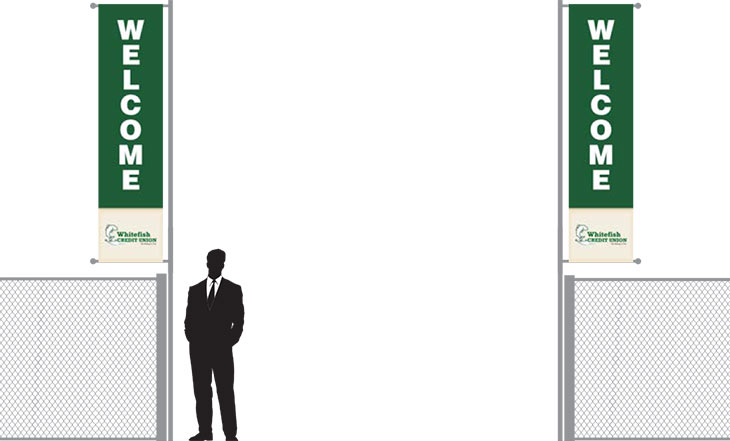
Before a person visits your office or retail space they have an idea in their head of what that experience may be like. This idea is created from every experience they have ever had with your brand; from the people they’ve spoken with, to the business card they received, to the brochure you sent them, to the website they checked out on their phone. It is a mental projection of what your brand will look like in ‘real space’ (and it’s one of the reasons why representing your brand accurately in all of your marketing is so important!)
When a visitor comes to your office or retail space they will begin reconciling everything they thought they knew about your brand (their mental projection), with everything they see in the ‘real space’. For example, if your marketing collateral always uses shades of green and a script font, but then all of your building signage has a purple background with block lettering, it will be difficult for people to reconcile this information into one cohesive idea of who you are as a business. They may wonder if they are in the right place, or if this is the same business. In a worst case scenario, the greater the amount of reconciliation that has to happen the more a person may feel misled about who you are and what you do.
In addition to being a representation of your brand, building signage is perceived as an indicator of how much you value your own business. If your signage is dull, faded, broken, crooked, misleading, incorrect, has typos, or otherwise isn’t clear, you’re communicating to your visitors that you don’t care how you are representing yourself. It’s akin to handing out a torn business card, or going to an upscale restaurant in a wrinkled t-shirt. If you do not show that you value and care for your business, your visitor will leave with the same impression.
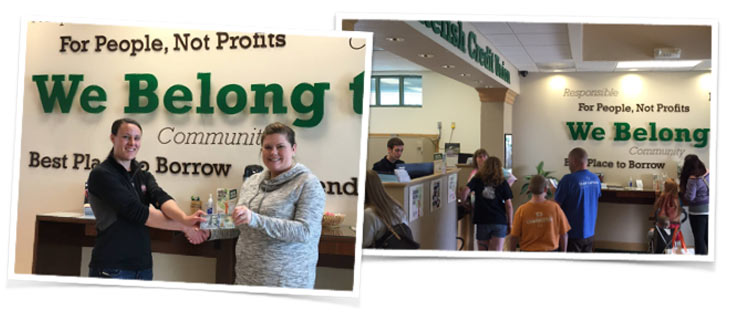
Every office or retail space has it’s own building signage needs, so the below list is not meant to be complete, nor is it a “to do” list of every type of sign you should have. We encourage you to reach out to us if you’d like to discuss your specific needs in more detail.
Photo courtesy of Wikipedia user Anthony92931.
by on Feb 2, 2019
You may be wondering why, exactly, you are bothering to read an article about stickers and their role in marketing. How much more could there be to know besides that you order up a bunch with your logo, put them out on your trade show table, and hope someone takes one and sticks it somewhere? With that understanding alone you are indeed missing out on the larger implications of the sticker as a medium: as a self-adhering label or notice that can serve a variety of purposes. In this article, we’ll introduce you to a wider variety of uses for the humble sticker, and show you how it can be a powerful tool in your arsenal of marketing tactics.
The most common way that stickers find their way into a businesses marketing plan is as brand vehicle. A business prints up hundreds or thousands of stickers that feature their logo and/or slogan, and give these out to current or potential clients. You’ll commonly see these splayed out on a vendor table at a trade show, or tucked in the box with a product you ordered. You see these types of stickers everywhere; from lamp posts and motorcycle helmets, to laptops and car bumpers.
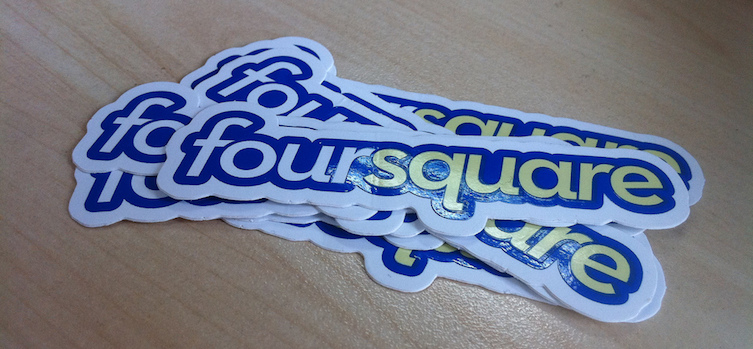
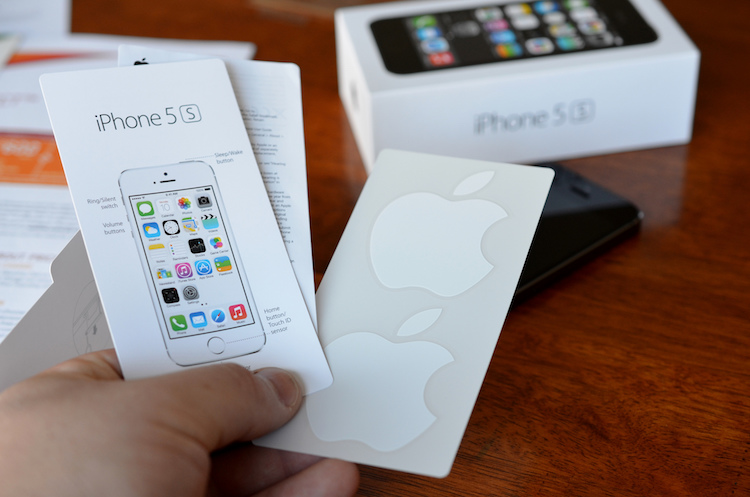
Although common, using stickers for the purpose of building your brand can still be effective and inspiring, if done correctly. Ultimately, you’re asking other people (often random strangers) to spread your brand into places and demographics you may not have previously reached, so you need to put a campaign into place that encourages your target demographic to take action.
One approach would be to encourage people to take a photo whenever they see your sticker and post it to your social media page, creating a volunteer sales force. This can increase your number of followers or likes, promote interaction on your social media pages, and get your brand out into places it may not have been seen before. You could pair this with a giveaway, offering something of value to anyone who submits a photo or likes one of the submissions.
Another approach would be to create the feeling of exclusivity by making people do something to earn your sticker. It creates a sense of camaraderie between people who have it, and also serves as a source of “bragging rights” to those who do not. The most well known example of this is the classic “I Voted” sticker. It’s worn proudly by those who voted, and signifies to everyone else around them that they earned the right to wear it that day.
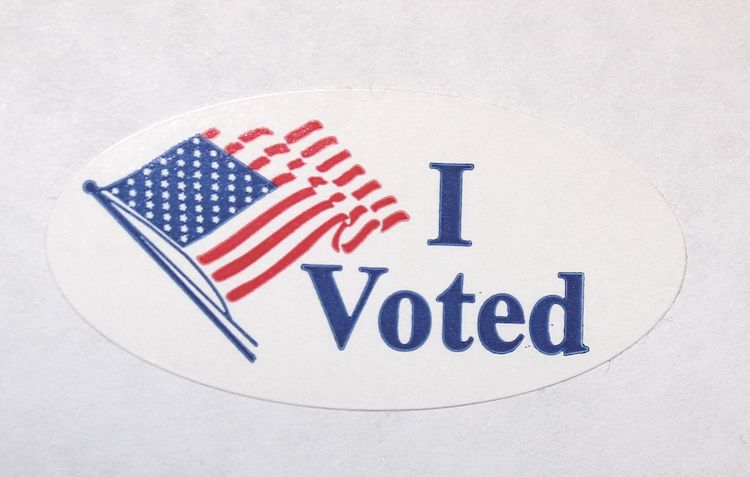
Some of the most creative uses of stickers have come from guerrilla marketing campaigns seen “out in the wild”. These campaigns take advantage of things seen in our daily life, and adds a context that somehow promotes a brand or message.


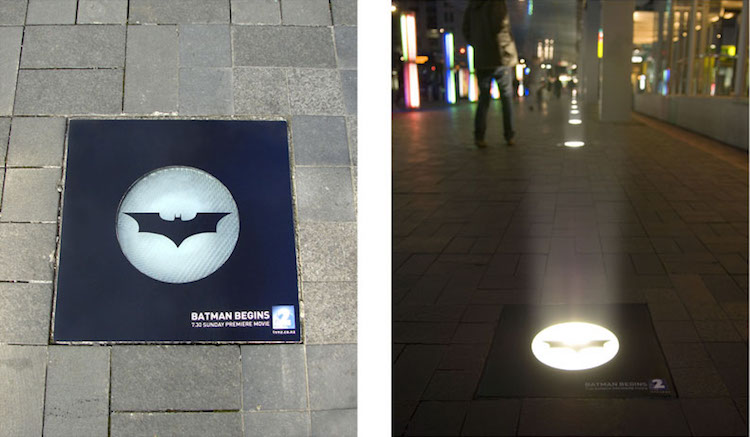
Many products are packaged in containers that can be difficult or prohibitively costly to print directly on. These can be glass or plastic bottles, curved surfaces, certain glossy materials. In these cases, high-quality stickers are used to apply the brand and label information onto the package. Some common examples of this are shampoo or conditioner bottles, beer bottles, cosmetic items and self-contained food items like bananas or oranges.

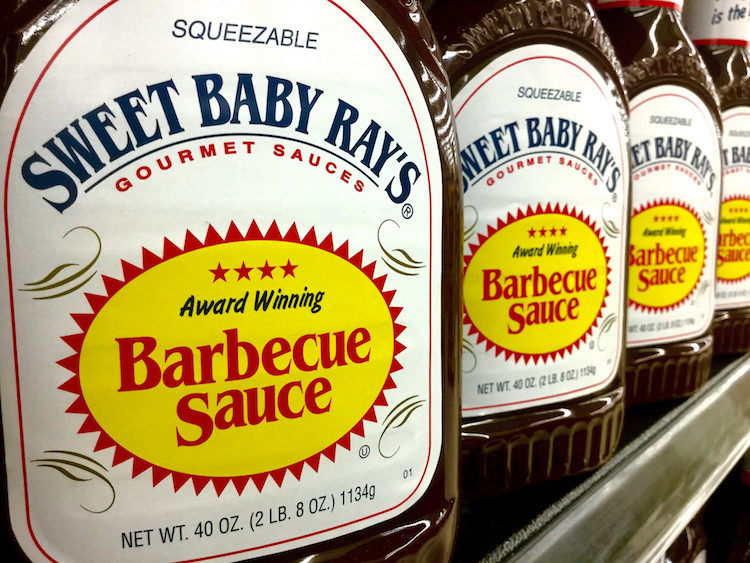

Stickers can also prove handy when adding additional or temporary information to a product’s package, such as “new” or “clearance” designations, buy one get one specials, “as featured in” notices, or “new packaging” highlights.
Most offices have information they need to share with their in-person visitors. Stickers can be used to post this information in a cost effective and visually appealing way. While every office space is different, some common examples include the business name / brand, office hours, payment types accepted, or accreditations and affiliations.
Stickers can provide a unique, cost effective, and easy-to-remove solution for plain or underutilized wall areas of your office space. From whimsical to functional, wall stickers (also called wall vinyl or wall decals) can bring a brand to life in ways that would be difficult for traditional paint or framed art.
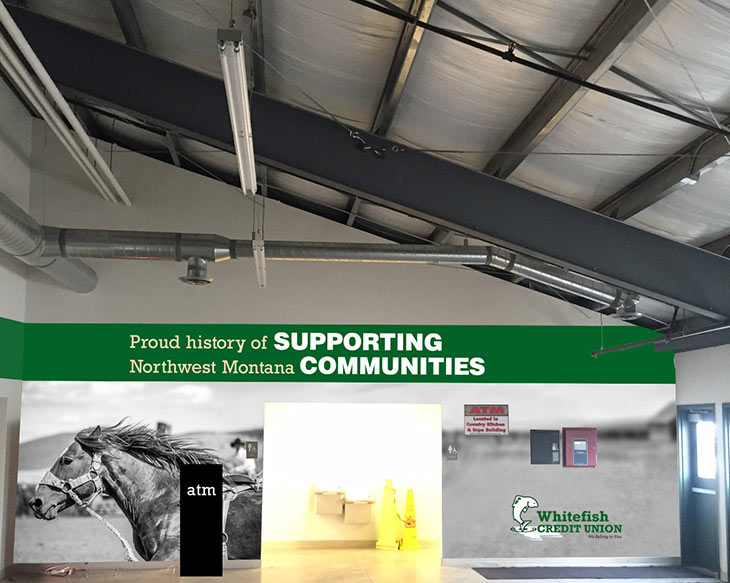
Vehicle wraps are large stickers that are applied to a vehicle on top of the original paint. A wrap allows you to change the appearance of a vehicle quickly and temporarily, so you can always update your messaging or return the vehicle to it’s original appearance.
Wraps can be either partial or full, covering only a part of the vehicle (like the back window or bumper), or the entire vehicle front to back, and last anywhere from one to five years.

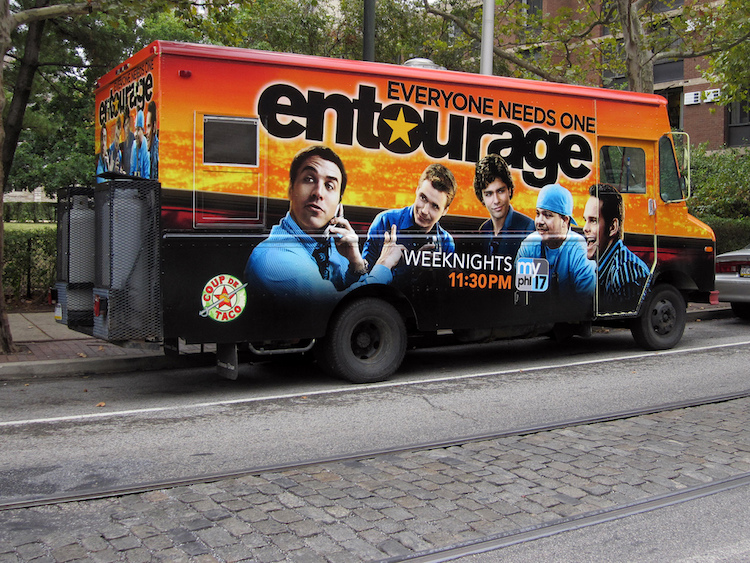
There are a myriad of ways that stickers, and adhesive labels in general, can be used to benefit your business. From promoting interaction on your social media channels, to wrapping your messaging around a city bus, a sticker marketing campaign should be only one piece of your entire marketing strategy. At Grid, we work with our clients to identify the best marketing channels for their specific product or service, brainstorm and execute multi-faceted campaigns, and analyze the results. If you’re interested in the role sticker marketing can play in your strategy, get in touch!
Photo provided courtesy of Flickr user Blake Patterson.
by on Jan 20, 2019
As an entrepreneur, nothing excites quite like the word ‘sales.’ And getting your product into a retail store is a great way to start getting them. But how do you approach retailers and what do you say to them when you do?
First, it’s important to consider what kind of shop you want to have your products sold in. Does your product lend itself to being in a small mom and pop shop or would it be more at home among hundreds of other products on the sprawling shelves of a big box store?
Smaller shops will generally know their customers and what they like better than the big-box-we-carry-everything-under-the-sun-type stores. That means when a smaller shop carries a product, it’s because they like it, they know their customers will like it, and it works. They’re also often more niche-focused with their product selection, so a consumer shopping their knows they’re getting exactly what they need.
On the other hand, a big-box store offers the potential for a much larger volume of sales than a smaller shop. It also exposes your product and brand to more consumers simply by the large volume of traffic they experience on a daily basis. Big-box stores tend to carry an impressive variety of retail items, so while a consumer might not shop there looking for your product in particular, you may receive sales from consumers making impulse purchases if your product is marketing well within the store.
If you are focusing on getting your product into retail locations, then the product’s packaging should be driven based on the needs of the retailer. For example, if you’re only selling at large retailers, you’ll be vying for attention against competitors located on the same shelf. Or your product may be stocked on a very high, or very low shelf. Does your product packaging stand out from competitors? Can it be read from a top or bottom shelf? Is it easy to read, and convey exactly what the product is, without need for excessive examination? Will your product sit upright on a shelf, or does it need it’s own point of sale display? Does the retailer have special requirements your product’s packaging has to meet? Does your product fall under the purview of the Fair Packaging and Labeling Act or FDA requirements?
If you’re selling through smaller retailers, you may want to tone down your product’s packaging to emphasize the artisanal, high-quality feel. Shelf space is often limited in these situations, so you may need to consider reducing the size of your packaging. Will the retailer require a special bar code or labeling system to meet their own checkout system?
Getting your product on any retail shelf requires a good pitch. When pitching retailers, it’s important to show them what your products will do for them. How will your product help improve their bottom line? What is your expected rate of sales? Do you have documentation that supports these estimates? What does your historical sales data look like? You’ll need to show them that you understand their business and consumers just as well as you know your own product. If they see that you’ve considered this from their perspective, their going to be more apt to give your product a closer look. A press-kit can help you more easily explain your product, brand and business, by putting everything in one convenient place. With sections for your company’s history, press releases you’ve put out, and media coverage your product has received, a press kit puts everything a buyer needs in an easy-to-read package.
You’ve perfected your packaging and sales pitch, and now it’s time watch the orders come pouring in, right? Not so fast, you’re job isn’t over just because your product has snagged some shelf space. Your retail partners are going to expect to review your marketing plan in detail, which will show them how you plan on moving your product from their shelves. Retailers aren’t in the business of promoting your products for you, so a fully fleshed out marketing plan is essential to making your retail relationship a success. Your marketing plan should show what your company currently looks like (including a SWOT analysis), an understanding of your target demographic, research that you’ve done into pricing and how you reached your price point, the marketing tactics and strategies you’ll use to create demand, your marketing budget, and more. A solid, well-researched plan will go a long way with buyers in the retail marketplace.
If you’re thinking about bringing your product to retail, we highly recommend that you reach out to us first. We can work with you on everything from your market strategy, to product packaging, and even the pitch itself. For more information, contact us!
Photo courtesy of Flickr user James Petts.
by on Jan 20, 2019
Press kits are the means by which you let members of the media, retailers, and others fully experience your product or service, and get to know your brand. Typically, the purpose of a press kit is to inspire a review or feature of your product or service, without being paid to do so.
There are a number of reasons for creating and sending press kits. Foremost among them is that a review is typically free and, therefore, more credible than an ad in the eyes of most consumers. For example, you’re probably more likely to take action and go see it when a friend tells you to check out a great new movie, as opposed to just coming across an ad for it in the newspaper. That’s because your friend is giving you their honest opinion on the film. You trust them and have found that your tastes and opinions often align with their own, so their review carries a lot of weight. The newspaper ad is simply a company paying the newspaper to advertise their product. It doesn’t carry as much weight as an actual review. The same applies to influencers anywhere. Their core audience believes they are credible and probably shares similar tastes and opinions as them. So when they recommend something, it’s given extra attention because of their credibility.
Another reason to have a press kit made is it simplifies much of the work of the journalist, making it easier for them to write about you. When a writer has everything they need to know about your company right in front of them, including a sample of the product, you’re much more likely to receive coverage, and for the details to be presented accurately.
If it’s a product you’re selling, your press kit will include at least one sample of it for the publication to hold, touch, use, play with, test, and inspect. You can explain to someone what a product does, its quality craftsmanship, or the way it works – but nothing will do it justice like putting it in their hands.
Along with your product, you should always include a fact sheet, which explains who you are, your company’s history, how your product or service works, and anything else you think is pertinent to understanding your company and your product or service. This includes, but is not limited to, major dates in your company’s history, the location where it’s currently operating, notable clients you have worked or are working with, pricing information, revenue statistics (if you want that information to be public), founder names, etc. This may also mean relevant data sheets (MSDS, CAD or instructional drawings, specifications, certifications, etc.).
You’ll also want to include a roundup of any media coverage you’ve already received. This could be in the form of press clippings, links to websites, a DVD or thumb drive of television coverage, etc. Media outlets will be more likely to run with your story if they see their peers have already vetted you to a certain degree and found you fit to publish. Credibility plays a large role here, as well. If you’ve been published in the New York Times, Popular Mechanics, and National Geographic, editors and writers will almost certainly put more credence in you and your press kit, over those with little to no coverage.
Next, try to anticipate what the journalist will need to do their job when covering you. Print and digital outlets will need hi-res photos of your product, company logos, pictures of your company’s founders, etc. Include all these materials in your press kit. If a writer doesn’t have to look far for everything they need to write about you, you’ll be more likely to get coverage than someone whose press kit is less complete.
Some people prefer doing everything through their computer. Others enjoy holding paper in their hands. Satisfy them both digital and physical versions of your press kit! The digital version can be as simple as a link to a page on your website or elsewhere that contains JPEGs, PDFs, videos, etc., of everything in your kit.
There’s a very simple rule of thumb for identifying if someone should receive your press kit: If they are a part of your target market, or cater to those in your target market, and have a voice to reach people, you’ll want to consider putting a press kit in their hands.
Begin by taking a look at your target market. Where do they receive their news from? What other publications do they read? What shows do they watch? When they’re going to make a purchase decision, who do they consult? You’ll gradually start to build up an idea of who your customers or clients are and what their behaviors look like. If you’d like more information on how to identify your target audience, check out our article on The Importance of Market Research.
With this knowledge of your target audience in hand, identify the outlets most likely to reach them. Don’t confine your list to traditional media like newspapers, magazines, or television shows. Also look at new media like blogs, vlogs, personal sites dedicated to narrow interests, and even individual’s social media pages. Even if it’s a small group served by these blogs or individual pages, you may find that they’re a much more qualified audience, resulting in greater sales with fewer impressions.
The media is great for introducing your product and getting your company’s story out. But you’ll also want to consider other influencers in your target market when putting together your press kit sending list. Identify potential clients who may be interested in your product or service. Affinity groups are another audience to consider. If your product helps better locate mountaineers trapped by avalanche, you’ll definitely want to send your press kit to local or national mountaineering and first aid groups to get you company on their radar.
A mountaineering group interested in life-saving tools, probably isn’t concerned with your company’s revenue statistics. Press kits are very dynamic, in that they should always be tailored to you’re audience. Include only the items that will most appeal to each individual recipient. If an editor receives a press kit overfilled with superfluous items, they’re likely to think it was mass-mailed and didn’t take into account their needs or their audience. Again, make the recipients job easier, and you are more likely to get coverage.
If you’re ready to put your product in the media’s hands, we can help! Contact us today to discuss creating your own press kit.
by on Dec 6, 2018
You’ve created a product, perfected your packaging, and now you’re ready to introduce it to the world! But… how do you do that? Launching a new product is an important moment for your business, and could generate a lot of buzz if you handle your marketing correctly!
The first step to a product launch is to formulate a plan. This part of the process is incredibly similar to how to plan a business launch, which we cover in depth in our article, “If You Build It, Will They Come? How to Plan a Business Launch.” You will start with the same round of questions: Who are your demographics? What is your message? What channels should you communicate through? And how will you translate interest in your launch into clients and sales?
If your an established business you should already have a good idea of who your current demographic is, but your new product may be aligned to a different one. Consider the gender, age range, income level, communication preferences, and any other information about the person who would be inclined to purchase your new product. How would your potential buyers like to hear about your new product? Should you hold an event or mail a postcard? Should you follow up with an email campaign? Would a local publication or influencer be interested? What can you post to social media? How should you update your website? Practice seeing your product through the eyes of your demographic, which will help you determine how best to bring your product into the world.
Every industry is different, but most people purchase a product because it fulfills a need. Someone who buys a new dishwasher usually isn’t doing it because they want a second one hanging around the house. Maybe their current dishwasher broke, or they’re buying one to install in a new home. When you’re determining the messaging for your product launch, focus on the potential customer and their need, versus purely talking about the product itself.
For example, if you’re introducing a new line of genuine leather purses into your clothing line, you might be tempted to tout the high-quality origins of the leather or the number of zippered pockets. Instead, try focusing on how the leather, unlike the customer’s previous purses, will not crack or fade, or that the zippered pockets help keep their change, lipstick or other loose items safe and secure. A customer is more likely to understand your message if you show them how it applies to their life, versus forcing them to make that association on their own.
Another way to help your launch be as successful as possible is to involve opinion leaders in the process early and often. Opinion leaders are the people in your life, your community, your internal team, or your previous customers that potential customers look up to, admire or trust. Have you ever been to a ribbon cutting ceremony for a new local business? Chances are you’ve seen your Mayor or even Governor at the event. Why? Because they are opinion leaders of the community, and their presence and involvement give an air of legitimacy and credibility. If it’s good enough for the Mayor, it’s good enough for me!
The most important opinion leaders you’ll find are your own internal team. Make sure each of your employees understands the new product, supports it, would feel comfortable discussing it with potential customers, and is excited about bringing it into the market. Next, look for social media opinion leaders that focus on your industry. You might be able to send them a free product for review, and their approval could get you in front of hundreds, if not thousands, of new potential customers you previously were unable to reach! Are there other community businesses or related industries that could support your product? For example, it’s not uncommon to see a massage therapist carrying soaps or lotions for another local artisan.
The more leaders you can involve in your product its launch, the larger the reach your launch will have.
A new product launch is a wonderful way to generate new content and keep people interested for a longer period of time. Consumer attention span is notoriously short (even shorter thanks to social media) so use your launch as an opportunity to bring people along for a ride. You might begin by hinting that something new is in the works, or sharing a zoomed in photo of a small detail (but make sure not to give it away). You could post about manufacturing updates or color swatch selections. You might tease about the flavor, scent, or ingredients. Build up the suspense until the big day!
Success! You’ve launched your product. But the work doesn’t end there. Make sure you have a plan in place for how you will convert the momentum created by your product launch into long-term sales. Were you collecting email addresses from people who want to be notified about your next product launch? What do you plan to do with those? Were you able to get a bunch of people to like your page on Facebook? Make sure you have follow up posts scheduled to reach out to them regularly. Did you capture photos or videos of the event? Consider how you can use those to promote your product weeks or even months later!
If you know you’ll be bringing a new product to the market in the future, and would like help in planning and executing a launch strategy to make the most of it, get in touch with us!
by on Dec 4, 2018
If you sell a product, chances are you’ve also had to consider how you package it for your customers. Does it come in a bottle, jar, box, or bag? Is it vacuum-sealed, taped, held closed with glue? Does it come packaged with instructions, warranty information, or return labels? Are you required to have a nutritional table, list of ingredients, or a country of origin printed on it? Are they sold individually or in a pack, stored in your home, a warehouse, or are they palletized? Will they sit on a retail shelf, hang on a rack, or lay loose in a box on display?
When it comes to product packaging, there are many questions to be asked and considerations to be made that are unique to your product and how it will be used, but there are some major overarching topics everyone should be aware of.
Much like how a house has “curb appeal”, so too does your product have “shelf appeal.” A consumer’s first interaction with your product is often with the packaging it comes in, so it’s essential that it accurately reflect your brand. From what material the packaging is made of (paper, plastic, cardboard, cloth, wood, steel, etc), to what’s printed on it (logo, text, illustrations, photos, nutritional information, etc), the design will have a major impact on your overall appeal.
For example, if you tout that your product is eco-friendly, but package it in an overly large, complicated plastic shell, you’re contradicting your brand message. Conversely, packaging an item like perfume or cologne into an elegant, expensive looking box builds the idea that your brand is luxurious and made only of the highest quality ingredients.

Beyond just the design of the package itself, there may also be industry-specific labeling requirements, some even mandated by the government, such as the appropriate nomenclature for declaring volume or weight, the correct language and line-thickness needed for your nutritional label, and what requirements there are for using specific terms such as “organic” or “fat-free”.
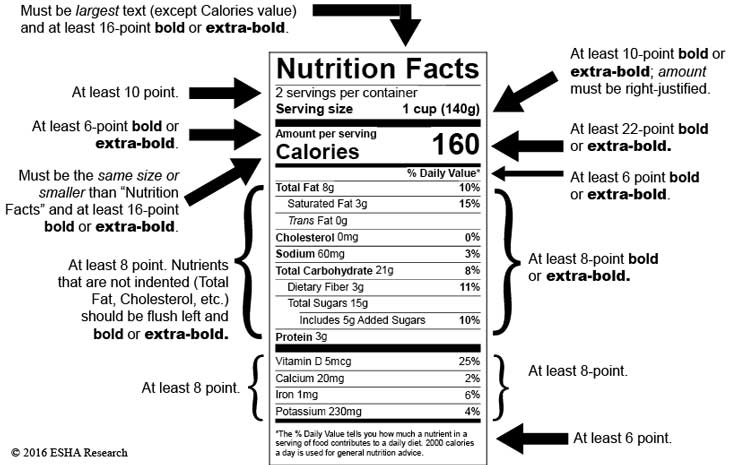
Most products are not just dropped into a one-size-fits-all bag, or tossed into a generically-sized box, taped up, and delivered to the retailer or the customer. There are often needs specific to your product that must be considered to help determine the appropriate shape and size of the products packaging. For example, will your product be shelved, and thus must be in a package that can stand up on its own? Will your packaging need a hole or tab at the top so that it can be hung on a rack? Can your barcode be easily scanned at the point-of-sale? Is your product fragile, or contain many small pieces? How will they be protected or contained until the item is purchased and taken home by your consumer?
The shape of your packaging also plays a role in its “curb appeal”. The flat rectangular face of a box gives you a lot more room to advertise than the curved front of a can. You’ll also know exactly how the product will be shelved, with the front forward, versus a curved package which could be turned in any direction, potentially hiding important pieces of your packaging design. However, geometric shapes can draw the eye on a shelf of otherwise slab-sided boxes.
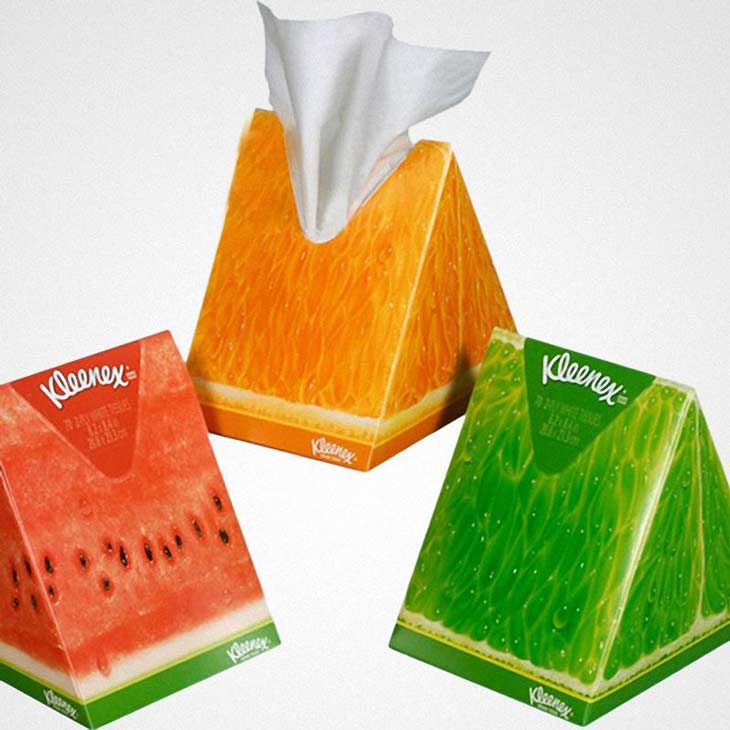
Your bottom line isn’t only influenced by your product’s sales – expenses in the production of your product and its packaging can play a huge role in how much you make. Even the difference of a few pennies in the cost of production could lead to hundreds, thousands (or more!) in additional profit or loss at the end of the year. Your material choices, printing needs, assembly, and even how a product is inserted into the package are all important considerations you’ll need to make. Understands and having experience with things like die-lines (what the “template” for printing, cutting, folding and gluing) is critical. Beyond making sure something is doable (that it can be printed and assembled in the way you intended), an experienced marketing agency can also help you determine the most cost effective solutions, design the packaging, recommend or vet packaging manufacturers, and ultimately see your product through to completion.
Besides the printing and materials costs of packaging, you’ll also need to consider any necessary labor costs. Take a smaller product, like a bar of soap, for example. The box it comes in is likely designed so that many boxes can be printed on a single sheet of card stock, but then the manufacturer needs to cut each box out of the sheet, make the necessary scoring or folding, assemble the box, glue or tape the sides together, place the product in the box, and then seal it shut. On very large quantity orders, this can be automated by machines, but if you’re doing smaller quantities, you’ll need to account for the human labor necessary to complete each step.

Whether you’re selling your product online or in a retail shop, chances are you’ll need to find a way to ship your product safely and cost effectively – either to the end consumer or to the retailer. How many of your packages can fit into a standard shipping carton, or how many of those containers can fit neatly on a pallet or into an overseas shipping container? In the beverage industry, shipping considerations are one of the major influencing factors in moving from bottles to cans – they weigh far less, break less often, take up less room, and need less protective material around and between each product – thus, they can ship for far less! Not to mention, cans can keep the beverage fresh for a much longer period of time, giving the product time to ship to its final destination. This shift, however, isn’t without some caveats – in the beer world, your 6-pack is like a miniature billboard. You know it will be facing only one of two ways toward the consumer, presenting a large image on the shelf. However, with cans, they are often sold in a plastic 4 or 6 pack attached to a plastic ring. You don’t necessarily know which direction each of the cans will be facing on a shelf, so packaging designers must use techniques such as colored strips, repeating patterns, and rely more on consistent brand colors or typography.
Sometimes a product doesn’t need its own packaging, except for shipping purposes. One of our clients sells boutique / high-end yarns both through their retail shop and through their website. One of their concerns about shipping was the protection of a product once it was sent out to a customer. The shipping box or envelope could be exposed to a wide variety of environments that would be destructive to the inside product, such as heavy rain or snow. Instead of trying to package every skein of yarn inside a plastic bag, adding cost and time to the shipping process, Grid helped develop a heat-sealed, cloth-covered bag that would be strong enough to survive shipping, and fully protect the product inside. The fabric material on the bag has their logo screen printed across the front, adding brand impact while also protecting the contents. The bags are of such high quality that many customers reuse it as a “project bag” for their knitting materials!
Whether you’re bringing a new product to market, or want to evaluate how to improve your existing product packaging, talk to the experts here at Grid!
by on Nov 28, 2018
There’s a lot of truth in the old adage that a picture is worth a thousand words, and when it comes to your product photography, it’s worth even more. Product photography gives your potential customers a lot of information about your product – the materials, the packaging, the build quality, and even what sort of lifestyle the product fits well into – but it also communicates the value and quality of your overall brand.
Consumer level cameras continue to improve in quality, but there are numerous technical and aesthetic differentiations between amateur and professional grade photographs. Basics such as exposure, color balance, and focus are, of course, important to get correct. But even more so are elements like lighting and composition (where the subject is in the frame, what is in focus or out, what’s lit or in shadow, etc). These elements have a huge impact on the image your customer sees, and thus the impression they take away about your brand and their interest in purchasing your product.
If you were selling a watch, for example, you could use focus to drive the viewers attention to the details of the watch, and use lighting to reduce the prevalence of the models arm or body. You’d also need to be conscious of the reflection of your lighting in the face of the watch – avoiding glare or it reflecting the studio or photographer. If you’re shooting on a seamless background, the shape, size and color of the backdrop may also affect your lighting and final image, as light bounces off each surface, including behind the subject.

Sometimes you want the opposite affect – where the product is more obscure or in shadow – for the purpose of teasing a new product.

These are the kinds of decisions that a professional photographer can work with you to make, using their expertise to help meet your business and marketing needs.
Our client, Simply Sue’s, creates boutique skin products that contain only organic and natural ingredients. They approached us to handle their product photography for their next round of marketing efforts. We identified the need for three different types of photography: individual product shots (where a single product is the focus of the photograph), group product shots (several types of products all of the same scent / variety in one photograph), and “lifestyle” shots (in this case, a product alongside its natural ingredients). These photographs were to be used not just for direct-to-consumer sales (such as on their website), but also in a marketing push for in salon and spa use. Individual product photos would give salon owners a detailed look at the quality of the packaging, group product shots would show the variety of available products, and lifestyle shots would appeal to upscale consumers shopping for their own skin care products.

This product shoot wasn’t without its own unique challenges, of course, especially since we were working with food as supporting elements! Food, obviously, spoils over time, but when it’s subjected to rigorous handling and intense lighting, particularly delicate or fresh items can quickly lose their visual appeal. In addition to food products, this shoot also featured ingredients that were hard to identify in their natural form, or were hard to showcase in a visually pleasing way, like powdered clay and shea butter.

Depending on the complexity or content of the shoot, sometimes it’s necessary to bring in a food stylist, who’s entire job is to brainstorm and execute creative ideas to make the food or products look as visually appealing as possible!
In addition to the complexities of shooting the natural ingredients, the actual product packaging also presented its own series of challenges. The texture and material of the packaging can cause less-than-desirable reflections. The goal is, after all, for consumers to focus on the product, NOT on a reflection of the photographer or the studio! Solving this requires some know-how and attention to detail in planning and executing the photo shoot, often involving creative lighting solutions. Depending on the material, you may also be able to dull reflections with a light dusting of aerosol hair spray!
If you’re ready to show your products off to the world, let Grid help with your next photo shoot. We can art direct (either on set, or remotely), or provide the photographic talent using our in-house or partner photographers!
by on Nov 22, 2018
A picture is worth a thousand words. What words it “says” can have a big impact on your product or brand.
Camera technology has gotten to an astoundingly good point in the past decade. Digital has replaced (and even superseded) film in all but the most unique situations, and cost of equipment has continued to decrease while image quality has continued to improve. But just because you CAN shoot a whole campaign on an iPhone (as Apple did with their “World Gallery” aka Shot on iPhone campaigns in 2015 / 2016 – which appeared on more than 10,000 billboards in 25 countries), it doesn’t mean the tools we use always do the whole job. Photojournalists often say “the best camera you can use is the one you have when you need it” and the running joke among some photographers when asked what settings to use is “f/8 and be there” (f/8 as in f-stop aka a measure of how much light is let into the lens via the aperture, but here it’s being pronounced tongue-in-cheek as “fate”). But ultimately, more than the equipment used, lighting, composition, and most importantly, subject, are what make a photograph great.
Lighting doesn’t have to mean a studio full of strobes or a grip truck and generator on location. It can be a simple matter of observing where the sun (or other source of illumination) is coming from, and working that to your advantage. For the sake of budgets, and for flexibility, speed and mobility, instead of lights we use a reflector or diffusion (it softens or reduces the light reaching a subject). This is done to put more light on somebody’s face – maybe just to get a little sparkle in their eyes, or to lessen harsh shadows. Lighting can also be used to control mood and tone of an image – shooting during the “golden” or “magic” hour (typically 15-30 minutes before and after sunset or sunrise) can lend a warmer tone to the image, conveying different emotions than shooting outdoors midday. Finally, paying attention to the contrast between your subject and the background is important. We’ve probably all seen a photograph with somebody backlit in front of a window, where the person’s face is completely in the dark, and the window is just a bright white blur. Common problem, but easily fixed by adding more light on the subject, reducing the light coming in through the window, or just moving the subject or camera. Paying attention to light and using it to your advantage can make for a vastly better photograph, and is the biggest separator between a “professional” image and an “amateur” snapshot.

Composition is also important when crafting an image. Sometimes it’s knowing the intended use and thus leaving copy space for a headline, or not putting important details where a logo or something like a Facebook profile icon will hide them. Beyond leaving room for content or accommodating specific use cases, where you place the subject or how you want to lead the eye through the image matters. Consider two people in a coffee shop. You could shoot this same scene many different ways and each would direct the viewer to a vastly different takeaway. Shoot it from directly overhead and maybe it’s a meeting or a date. Shoot it from over the shoulder of one person, looking at the face of the other, and it’s a conversation. Do that same shot but put the background out of focus and that conversation is more intimate, maybe even romantic. Taking composition further, it’s important to pay attention to not just the placement of objects and shapes, but details like eye-lines. What side the subject is on or looking toward matters – in Western culture we read text left to right, and as a result we tend to “scan” through an image the same way. Where a subject is looking (or walking, or pointing) is often used to direct the viewer to look there as well. Composition isn’t just two dimensional graphic design though. Much can be done via use of depth – not just “depth of field,” (having more or less of the image in focus), but layering information – what is in front of or behind the subject and how much is visible or obscured. Composition also needs to take into account color and contrast – placing a subject or shooting from an angle so that a light object stands out from a dark background is often important, too.

Whether shooting a model, a product, a location, etc., the most important thing, of course, is the subject itself. This is one of the most critical aspects of creating a successful image, and one that often takes the most pre-production planning and logistics. Who will be in the image? What are they wearing? Where will it be? If it’s a product, is it in the retail box, or by itself? Is somebody holding or touching / interacting with it, or does it stand on its own? For example, shooting a model in front of a plain backdrop might be appropriate for a catalog or eCommerce website, but if you’re creating a brochure, poster, billboard, etc., you might want them in more of a “lifestyle” setting. Or if you’re trying to present an educational product, having a group of children in the background instead of a classroom of empty desks might set a better tone. Shots with people in them can also require an awareness of your target demographic – an advertising image with a room full of baby boomers probably won’t resonate well with your target group if you’re trying to sell a technology product or service to Gen. Y / millennials. Some brands focus first on the beauty of the product before showing how it’s used. With the introduction video for Microsoft Surface Studio, nearly a minute goes by devoid of people, with elegantly lit close-ups of the computer – and then we see nothing BUT how people interact with it. Yes, by the way, these suggestions also hold true to video, not just still photography. Ultimately, the subject is king – you can take the most well-composed, gorgeously-lit photograph, but if the content makes no sense and people can’t connect with or relate to it, it’s not successful.
So the next time you look at or take a photograph, think of the (approximately) thousand words above!
by on Nov 21, 2018
eCommerce is a catchy term for any commercial transaction that is conducted electronically on the internet, be it from a mobile device, tablet or desktop. Most commonly, eCommerce is used to refer to a consumer purchasing a product online and having it shipped to them directly, but can also include the consumer purchase of services, business to business transactions for goods or services, online auctions, or the purchase of digital goods, such as streaming movies or video games.
Before eCommerce became a part of our daily lives, most businesses were in competition within their industry and specific geographic location. For example, if you needed to purchase a new shirt, chances are you’d be selecting from the retail options available within a few miles of your home or work. These retail stores wouldn’t have considered themselves in competition with stores across state lines. Now, however, the internet is blurring those boundaries and introducing avenues of competition that previously did not exist.
The lure of starting your own eCommerce business (or adding eCommerce on top of your traditional commerce foundation) can be incredibly attractive. Coupled with the hundreds of third party services providers that tout the “ease and simplicity” of building an eCommerce store on their platforms (such as Shopify and Wix), you may feel ready to jump in with both feet! But before you proceed, you should be aware of the components that go into not only setting up your online store, but processing payments, fulfilling orders, and providing customer support (just to name a few).
The most basic component to any eCommerce system is the product being offered. Your product (or products, a la Amazon) can be anything from televisions to filing cabinets, prom dresses to dinnerware – the opportunities are endless. As we mentioned before, eCommerce is not limited to physical goods, but can be extended to allowing customers to select and purchase your service plans online, purchase digital goods, such as pre-recorded webinars, or grant access to member-only features of your website.
When considering what you will offer for sale through your eCommerce system, you must determine how you will obtain the products that you are selling. Are you making your products by hand? Will you be purchasing your products in bulk from the manufacturer? Will you need to arrange an agreement with a distributor? Do you have blind drop ship arrangements with producers?
Depending on what you are selling and how you plan on procuring it, there may be additional considerations such as legal contracts, affiliate agreements, packaging needs, labelling requirements, UPC or barcode generation, federal or state level regulations, and even resell agreements.
If your eCommerce is a new business, you may also need to think about your inventory and product storage. Will your products be delivered on a truck requiring a loading dock for unloading? Are they particularly large or will they require certain temperature considerations during storage? Are they fragile, perishable or living? Will they have a shelf life? How will you track inventory you have in stock, versus what is in delivery? What are the turn around times for purchasing new product and having it available for sale through your eCommerce?
When it comes to product, packaging, inventory and storage, there are a wide variety of scenarios that may apply to your situation. Although we at Grid have experience in each of these situations, the nuances of each are too exhaustive to cover in this article. If you are preparing your eCommerce solution and need assistance in any of the topics being discussed in this article, we encourage you to reach out to us for more direct and specific support.
Now that you’ve identified what you are (or will be) selling, and how you will receive and store it, the next step is to set up the place where you will connect with your customers and enable the transaction to happen – your website.
As we mentioned earlier, there are quite a few third party services that provide “out of the box” online eCommerce systems. These solutions can be great for simple eCommerce stores, such as those with only a few products, those with products that do not have many variants (such as size or color options), or those that don’t plan to process too many orders. The benefit to these platforms is they allow you to get up and running fairly quickly: you sign up for a monthly plan, choose a design template, connect it to your payment processor (which we will cover below), put up a few products and you are off and running!
But, as most of our clients who started with one of these solutions have found, most businesses that plan to really focus on their eCommerce business find themselves outgrowing the capabilities of the platform fairly quickly, and need to move on to a more robust, extendible, or even customizable solution. Just as every business is different from another, so, too, are their eCommerce needs.
One of the most headache-inducing parts of eCommerce used to be navigating the waters of credit card processing, gateways, contracts and monthly fees. But as more businesses have pursued eCommerce solutions, the demand for an “easier” approach to accepting credit cards online has grown exponentially. Businesses were clamoring for a credit card acceptance system that did away with antiquated fee structures, contractual requirements, and penalties for accepting credit cards that weren’t “in hand” to be run through a swipe-style machine.
A number of new credit card processors have entered this field to respond to the demand, making accepting credit cards online easier, safer, and more cost efficient. At Grid, we regularly recommend Stripe to our clients (depending on their needs, of course) to accept payments or donations. If Stripe doesn’t meet your needs, you may also consider Square or Google Wallet.
On the other side of the spectrum, most eCommerce systems readily connect to Paypal for accepting payments. We, however, would strong advise against using Paypal for any business transactions since although they act like a bank they are not classified (and thus not regulated) as one. They are not required to maintain any of the security, customer service, or dispute resolution services that typical banks are held to, which can result in sudden and inexplicable freezing of your account with no actual recourse.
With your online store up and running, you may be inclined to kick back and wait for the orders to come rolling in. We hate to spoil your moment of zen, but an eCommerce website is not a “build it and they will come” scenario. Remember how we talked about the internet opening up new lines of competition for traditional commerce businesses? Every online business is in competition with every other online business offering the same or similar products or services – so the real work in your eCommerce website has just begun!
When it comes to marketing your eCommerce system, there is an almost infinite number of marketing strategies that could prove successful in driving traffic (and thus sales) to your website. The marketing campaign you embark on should be designed around informed decision-making about your product, demographics and messaging. But the important takeaway here is that you must be doing something to get the word out, whether that’s a loyalty program, social media campaign, email newsletters, deals of the day, free samples, etc.
If no one knows about your eCommerce website, you will not receive any orders.
You’ve gotten the word out about what you’re selling, and the orders have started to come in. Great! Now, how do you plan on fulfilling those orders? Who will be responsible, and on what time table, for checking for any orders placed? Will you need packaging material and boxes? Are you shipping with US Postal, FedEx or UPS? Depending on your shipping provider, are you able to ship to post office boxes, internationally, or to a residential community? Will the package have to be signed for? Will you need insurance? What sort of shipping time have you guaranteed, and what is your return policy and process? How will you handle out of stock or backordered purchases?
There are many different questions that can arise about your fulfillment process. Take time to consider each step of the operation before you launch your eCommerce website, so that you don’t find yourself with an order in hand and no plan on how to fulfill it!
There is no doubt that the percentage of eCommerce purchases using a mobile device will continue to increase over the next few years. If you doubt the validity of that statement, you have only to look at the largest retailers in the world, such as Amazon, Google, and Facebook, to see the importance they are placing on their mobile experiences.
You should be considering the experience of a mobile user during every stage of building your eCommerce solution. Does the website not only function properly, but provide an enhanced experience specifically for customers on a mobile device? Do the images resize properly for the size of the device, and does your navigation tuck away nicely so as not to distract from browsing your products? Do you streamline the process of finding a specific product, adding it to the cart and checking out? Are you adding annoying obstacles that would prevent a mobile user from completing checkout, such as requiring account creation or breaking the checkout experience up into too many pages?
In addition to understanding the components that go into building an eCommerce solution, it’s also important that you understand at least the basics of law as it relates to online transactions. Businesses selling products or services online, particularly those selling to customers in different states or internationally, face different legal and financial considerations as they relate to privacy, security, copyright and taxation.
The Federal Trade Commission (FTC) regulates most online activity, including email campaigns, online advertisements and consumer privacy and protection. The Payment Card Industry (PCI) Security Standards Council develops standards and rules outlining the procedures for proper handling and storage of consumers’ financial data. During the course of your eCommerce business you will collect sensitive personal information about your customers, and you will be subject to state or federal privacy laws, FTC regulations, and PCI compliance standards. It is your responsibility to adhere to all rules and regulations to protect your customers’ information.
One of the most standard options for providing protection for your customers is the use of a Secure Sockets Layer (SSL) certificate assigned to your website that encrypts information that is passed into your website (such as email, password and credit card information). Most consumers have been “trained” to identify secure eCommerce websites using SSL by looking for a closed padlock icon on the status bar of their web browser.
When compared to traditional commerce, eCommerce comes with its own set of advantages (and difficulties, which we cover below).
eCommerce, when implemented thoughtfully and purposefully, can open a lot of opportunities for a new or existing business. Whether you sell products or services, giving your customers a way to browse, select, and purchase at their own convenience opens doors that a physical location may never be able to afford.
If you are considering an eCommerce solution for your business, we highly encourage you to reach out to us to discuss the best implementation. We can walk you through each step of the process, from beginning to end, to help you identify obstacles and opportunities unique to your specific situation. If you already have an eCommerce solution up and running, but it isn’t performing to the level you want, we can evaluate your setup and help identify areas for improvement. At Grid, we have extensive experience with a variety of types of eCommerce solutions, from big to small, and are happy to lend that knowledge to you!
by on Oct 16, 2018
There’s a phrase we tell every single one of our clients, when it comes time for us to build or redo their website. “We can build you a website that launches an actual rocket into space, from halfway around the world. But do you need it to?”
The idea is that your website doesn’t need to be full of bells and whistles, with live chat boxes, Twitter feed integration, online calculators, blinky GIFS or auto-play music. In fact, we consistently see higher user engagement on websites that have streamlined functionality and content, as compared to those that do not.
Consider this scenario. You’re interested in working with a financial planner to help you put together a successful retirement plan for you and your family. You begin your search as many of us do, by hitting up your favorite search engine and putting in terms that return results for financial planners in your area. As you are browsing, you encounter three distinct types of websites:
The Out-of-Date
You know an out of date website immediate by it’s “boxed” in style, where a majority of the content is constrained in a static-sized box centered in the middle of your browser. This website does not adjust it’s design when browsed on a mobile device. There may even be broken links or images. You immediately wonder when the last time this website was updated, if the company is still in business, and, most importantly, if this firm matches the personality of your more modern-age family.

The Overachiever
As soon as you load this website, you’re hounded by a pop up box inviting you to chat live now. Even if you wanted to chat with someone online, you wouldn’t be able to because the chat service says there are no agents currently online. You continue to navigate around the website, finding tons of “useful” tools, like an interest calculator or an image gallery of photos from last year’s holiday party, but nothing in the way of real substance. You’re not event able to find a clear list of their services, except for a mention about IRA limits in their last blog article (which was dated 2015).
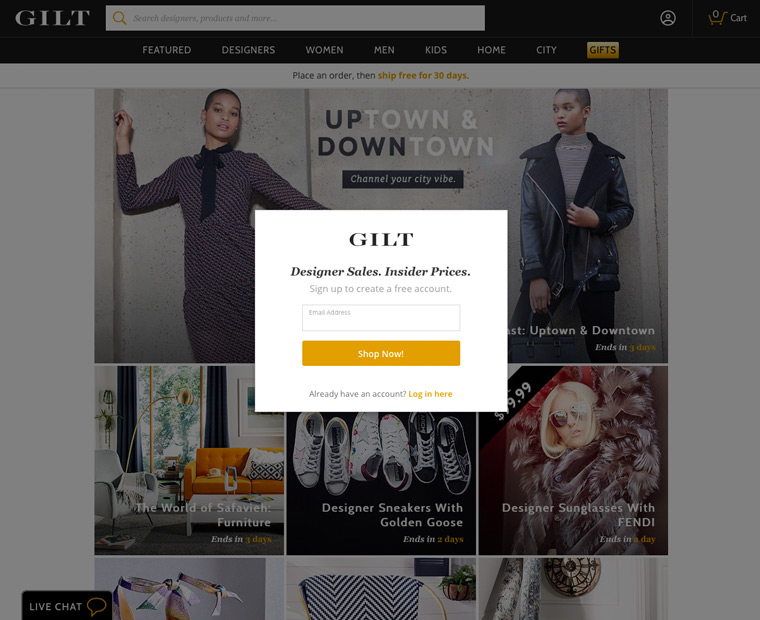
The Professional
When this website loads, you have a clear sense of where to find the information you are looking for. The navigation options are concise, with dropdowns for more niche content, that helps you quickly and conveniently move right into the information you are looking for - retirement planning. On this page is a helpful overview of their process, along with multiple ways to contact them, including phone, email or an online form. You are not pressed to choose your own appointment time just to get more information. Because of how easy it is to navigate the website, you naturally browse into other services, such as college tuition planning, and estate planning - you do, after all, have children to consider as part of your plan.
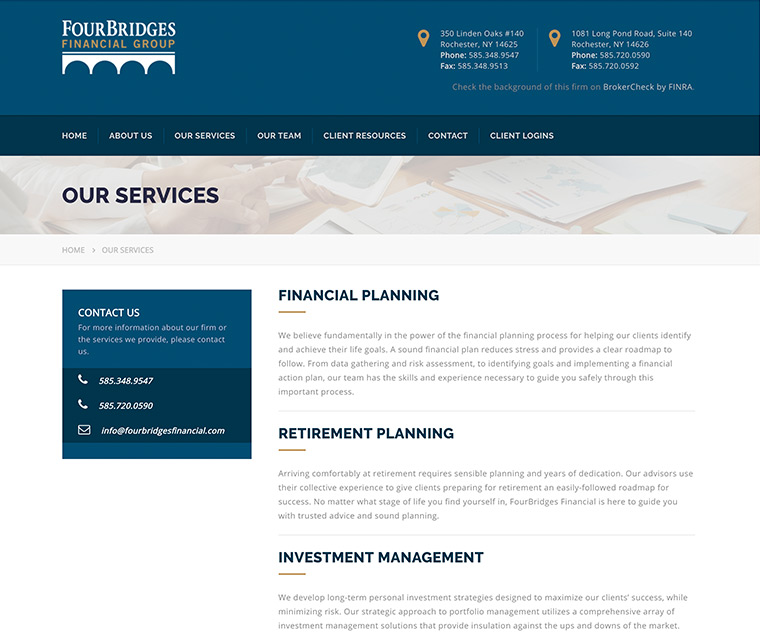
Our Work
When we began our work with FourBridges Financial Group, both our team and theirs were already on the same page about keeping the website as streamlined as possible. It should cover their major areas of work, feature their professional team, and should have a design and interface that would allow users to find the information they are looking for quickly. Addresses and phone number should always be considered a priority, and have a place at the top of the website no matter what size device you are browsing on. Users should be encouraged to contact individual team members directly, or submit general inquiries.
While the FourBridges Financial Group could have included more “flashy” or “interactive” content, it’s our belief that a professionally designed website, with a logical information architecture and high-quality content, should be able to engage and inform users without hiding. Remember that your users visit your website looking for some sort of information. The choice of whether help guide them quickly and easily to that content, or obfuscate it behind bells and whistles, is up to you.
by on Oct 2, 2018
The formal practice of public relations can be dated back to the early 20th Century. Since then, “public relations” has been defined in a lot of different ways as its role has shifted in parallel with the demands and expectations of consumers. In 2012, the Public Relations Society of America worked with the public at large to define public relations as “a strategic communication process that builds mutually beneficial relationships between organizations and their publics.”
In other words, it’s about building and maintaining your reputation with anyone who ever has, or will form an opinion about your business (current or potential customers, members of the community, voters, the media, your vendors, industry partners – the list is endless).
From these definitions, it might be easy to write public relations off as a marketing practice only needed by larger organizations, or businesses involved in hot-button issues like politics, energy or health care. But discount the need for public relations at a small or medium-sized business at your own risk. There may be no such thing as bad publicity, but there is such a thing as handling your publicity badly, and one poorly thought out response to a media inquiry could land your brand in hot water for years to come.
Handling the flow of information between a business and the public can take many forms, and indeed should depending on the information being shared and the audience it is being shared with. For example, the language and content used in an announcement about your new retail location will sound very different when shared with the local business journal versus a notice to nearby residents. The business journal will be interested in the number of jobs being created while the nearby residents will want to know how an increased demand in parking may affect their home life.
Let’s take a look at a few of the ways public relations professionals can help shape your business’ reputation.
Public relations professionals spend a lot of their time cultivating relationships with media outlets, publications, and journalists. They spend time researching each journalist’s area of expertise or personal interests to best understand what types of stories he or she may be interested in hearing about. The goal is to craft a well-written press release with a newsworthy angle about your organization that can translate directly into an article or story – saving the journalist valuable time in pulling together the facts or tracking down sources. With the right combination of press release and journalist, an organization can get a substantial amount of “free” press in third-party publications, building a significant amount of brand credibility and trustworthiness.
A press kit can serve a variety of functions, but is primarily used either as a follow up to a press release, or as a way to promote awareness about a new product. The kit contains anything that may help a journalist understand more about the client or their product, including things like executive or business profiles, testimonials, photographs, in-depth product descriptions, product samples, recent press releases or media coverage, product demonstration videos, and (of course) contact information for requesting additional information.
Over time, a good public relations professional will build their client up to be seen as an expert in their respective field. When writing articles, journalists often seek out experts who can be reached and interviewed on a moment’s notice (the news waits for no one!). For example, if a city proposes rolling out free, city-wide Wi-Fi access, a journalist will write about obstacles the city will face, including technology limitations or security concerns. The journalist will thumb through their contacts looking for people who have the credentials and credibility to weigh in on a topic like internet security, and reach out for a comment in person or by phone. These opportunities not only position that person as an expert in the eyes of the reader, but also increases the likelihood of that journalist covering their next press release.
Every business worth its salt will find itself in front of the media at some point or another. Public relation professionals work with anyone at your organization who may need to interact with the media, particularly for radio or television interviews. They will help prepare answers to questions that are likely to be asked, brainstorm ways to guide questions and answers back to the desired messaging, and coach on how to look comfortable without looking casual. An innocent looking interview can turn into an interrogation quickly, and the interviewee needs to be prepared on how to adapt and adjust their responses on the fly.
There are innumerable kinds of public relations crises, some of which are completely out of an organization’s control. Organizations of all types and sizes are encouraged to consider what types of emergencies might affect the organization, their customers or their brand. What impact might a large natural disaster, technical issue, human error or legal concern have on your business? A crisis management plan identifies as many disaster scenarios as possible, and lays out a specific response plan for each, including when customers and the media should be contacted, by whom, and what messaging should be shared. Preparing this information in advance can mean the difference between weathering a public relations storm, or being forced to close up shop.
Although you can do your best to prepare, sometimes things happen that we could have never seen coming. In these situations, it’s incredibly important to have a public relations professional on hand to help guide your organization through the crisis in a timely manner. Depending on the situation, you may need to be making public responses within hours, at any hour of the day. Under this type of stress, it can be easy to give knee-jerk responses that later turn out to be untrue (making you look untrustworthy, even if the intentions were good), or wait too long to respond (making you look uncaring, and giving the public time to form their own opinions of what has happened). A public relations professional will help put together a response and timeline appropriate to the situation, including who will be the organization’s mouthpiece for this issue, and they will respond to questioning.
Public relations is important for every business, in every industry, whether there is a crisis on hand or not. The success or failure of businesses often rests on a reputation that has already been built, and public relations works to build this reputation around the right messaging. If you’re ready to start shaping the public perception of your business, or recognize the need to adjust how your organization is already perceived, reach out to us today!
Photo provided courtesy of flickr user Congress of local and regional authorities.
by on Oct 1, 2018
So many discussions about websites and a brand’s internet presence today center around applications and eCommerce. While more and more companies are moving toward this kind of online experience, sometimes you just need to get information out there about your company, such as: what you do, where you are, when you’re open, etc. We refer to this kind of website as “brochureware” – if you could hand somebody a trifold or a folder / binder at a meeting, convention, door-to-door, etc., what would it say about you?
Restaurants, for example, need to showcase their menu, their location, and their hours of operation. A manufacturer might want to talk about their equipment or capabilities, and the industries they cater to. A landscaping business or carpenter may want to showcase jobs they’ve done, while talking about the geographical area they serve and how to get in touch. The idea is to simply and concisely present the most important information a potential customer or client would need to see in order to choose you. That isn’t to say that these are cookie-cutter, static, one-size-fits-all websites. In fact, many of them have back-end code to allow the business owner to quickly and easily update menus, add new examples of work, or otherwise modify the information – but they are typically built in a simpler manner, utilizing lighter-weight content management systems, such as Expression Engine, WordPress, or others.
What system is used and how the site is organized comes down to what we refer to as information architecture. More than just a site map or content outline, Grid works with our clients to determine not just what to say, but the relevance and priority in which it’s said. While content on the web is nowhere near as rigidly presented (page 2, 3, 4, etc.) as printed brochures, there is still something to be said about the order of information in your navigation, or top-to-bottom on the page. If you are a consumer-facing brick-and-mortar business, we will often suggest prioritizing contact information or your business address / directions. In the B2B sector, just like how you see many financial institutions making it easy to find their routing number online, manufacturing sites might prominently display a DUNS, GSA, FAA, etc., number or ID that they often receive calls or emails about. Going back to the “brochure” analogy, the website visitor should be able to see who you are, what you do, and how to get in touch (or visit, etc.) as quickly and easily as looking on the front and back of a brochure – and find more details about the “why” by opening it up and reading the inside pages.
In the past, companies often thought of brochureware sites as one-and-done, just like a printed brochure – once it’s “designed” and sent to print, it’s not updated until the next round of printing. At Grid, we prefer to think of all websites as ever-evolving, and we tailor our solutions for clients large and small with this in mind. There are several benefits to updating the information on a website on a regular basis. Not the least, Google tends to reward websites with changing and growing information with better ranking in their search results. End-users tend to visit a site more than once before making a decision. Seeing new information reinforces with them that the company they are looking to buy from or partner with is growing, vibrant, or frankly, still doing business. As a consumer, would you want to go to a restaurant who still listed their Thanksgiving specials in May? Whether it’s adding press-releases or relevant industry articles, posting new case studies, or as simple as updating a menu, changing hours, or choosing seasonal imagery, thinking of your website as something flexible that grows and changes with you is important.
In addition to keeping the website up to date, it’s also crucial to be sure that it represents you well across the various devices and platforms that people are viewing it on. This is often referred to as “responsive design” – where a design and a site’s content are translated to be presented in the best way possible whether on mobile, tablet, or a desktop. We’ve all visited a restaurant site where you can’t read the phone number because it’s too small on mobile (or can’t click on it to call them because it’s a graphic, and coded poorly). As more and more people browse (and search) from mobile devices, this is something that isn’t just a “want-to-have” now, it’s a must-have. Even Google is rewarding mobile-friendly sites in their search results. This isn’t just important for consumer-facing sites. Even as far back as 2010, Forbes revealed that more than half of senior executives considered their mobile device as their primary. For B2B this could be as simple as a traveling executive finding contact information or an address for a meeting, or as mission-critical as narrowing down vendors based on capabilities. To underscore the importance, what if your medical practice now offered Sunday hours, but you found the office vacant because people viewing your website thought that you were closed? Or, imagine spending hundreds of thousands or even millions of dollars on a new piece of equipment to expand what you could do, only to see that equipment sit idle because your partners didn’t know you had it. Getting the word out where customers (and Google) can find it is critically important to the growth and sustainability of your business. If you are interested in having us evaluate your current website, need help moving it into a more responsive design, or are building your first site from scratch, reach out to Grid and let us help you establish an impactful presence on the web today!
by on Aug 29, 2018
When it comes to online advertising, one of the most valuable benefits is the ability to collect and analyze data about the campaign. Data is neither positive nor negative in and of itself, but you can use that data to give you more information about your potential and current customers - information that should be a vital component of your marketing and business decisions.
Our client, Convergent, works with universities, medical centers, and government agencies to deploy or upgrade their VOIP / unified communications systems. They can act as a carrier liaison and project manager for these telecom deployment projects, which can often span multiple years. Large projects such as these naturally have a long sales pipeline, so Convergent approached Grid for help in creating very targeted online marketing strategies that focus on specific midwestern and east coast prospects.
We began our work with an in-depth discorvery process to determine what the ideal Convergent client looked like. From company size and location, to how much previous exposure to Convergent this ideal client would have, it was important to understand exactly what this customer looked like. Once we could “put ourselves in their shoes,” we developed groups of targeted keywords and natural language phrases that mimiced what this ideal client would search for online if they were in need of the services and solutions that Convergent provides. Next, we used these groups of keywords to help us build search advertising campaigns that focused on each individual topic. For example, if a potential customer searched for “how long should telecom deployment take,” we wanted to serve up an ad that focused on how working with Convergent could reduce your overall time of deployment. Alternatively, if someone searched for “how to plan a voip system,” the ad should instead focus on Convergent’s extensive experience in implementation strategies.
The first few months of a search marketing campaign should be considered your base line, and should be used to test your campaign in a few different ways. For Convergent, we used the first three months to refine the campaign by optimizing the bid strategies (identifying which keywords are resulting in traffic that we would consider more valuable than others, and adjusting the bid strategy to reflect that increased value) and adding negative keywords (disassociating our advertisements from any searches that contain certain words or phrases). For example, after implementation we learned that the phrase “carrier liaison,” which for Convergent refers to a consultant that interacts directly with a provider, is also used in trucking and logistics, in reference to dealing with Customs and Border Patrol.
We also use this time to assess if our assumptions about our potential customers were or were not correct, and make adjustments based on those results. Did we assume potential customers would use technical language, when instead they are using layman’s terms, or vice versa? Did we expect potential customers would be searching for information during the work day, when instead the data shows they are browsing early in the morning before standard work hours?
Lastly, we use this time to establish goals for the flow of our website traffic. Is it proving more valuable to have your website visitors pass through your pricing page before they reach your contact page? Or do you have a better conversions if people visit one of your case study pages? This sort of analysis can improve your search engine marketing campaign by telling us which information is most important to your traffic, what page of your website your advertising traffic should be pointed, and what we should encourage the visitor to do once they are on that page.
After several months, one of our major findings for Convergent was that we could safely decrease their average bid amount by over 50% with nearly no impact on the overall traffic volume!
At that point, we worked with Convergent to identify their specific website traffic trends, and use that inform their offline marketing efforts. For example, we were able to identify that a segment of traffic to the website was originating from an a network/IP that could be traced to a specific educational institution. This allowed Convergent to reach out to that institution with a more targeted marketing campaign, which included mailing their decision makers a “first aid kit” to help them “repair” a telecom deployment strategy that may be languishing under another provider!
We also set up custom reporting that would notify Convergent if there was a significant amount of traffic coming from the areas centered on the physical location of key potential customers.
At Grid, we believe that it’s better to target your marketing campaigns to a handful of highly qualified viewers, versus spamming your ad to hundreds of people who have no interest in what you do. This is one example of how we’ve put that targeted ideology into effect for Convergent. If you are interested in search engine marketing or how a highly targeted marketing approach could benefit your business, contact us today!
by on Aug 10, 2018
Pay-Per-Click advertising, or PPC advertising, is the overarching term given to any digital advertising strategy where the advertiser pays based on the number of clicks an ad receives, not the number of times the ad is shown. While the concept of PPC advertising popped up in the mid 1990s (with several sites claiming to have the first PPC model on the web), there are three major players in the PPC market today Google AdWords,Bing ads and Yahoo Gemini. Each provider offers an advertiser the opportunity to show PPC ads on their own platform, but otherwise work based on the same process outlined below.
Chances are, if you’re reading this, that you’ve used one of the major search engines before to search for something on the internet. In fact, we’re willing to bet you’ve used a search engine at least once today. Based on the keywords you use in your search query, the search engine shows you a list of websites that may be relevant in the “organic search results” section (for more information on how the search engine ranks these websites, read our article titled Say Hello to SEO).
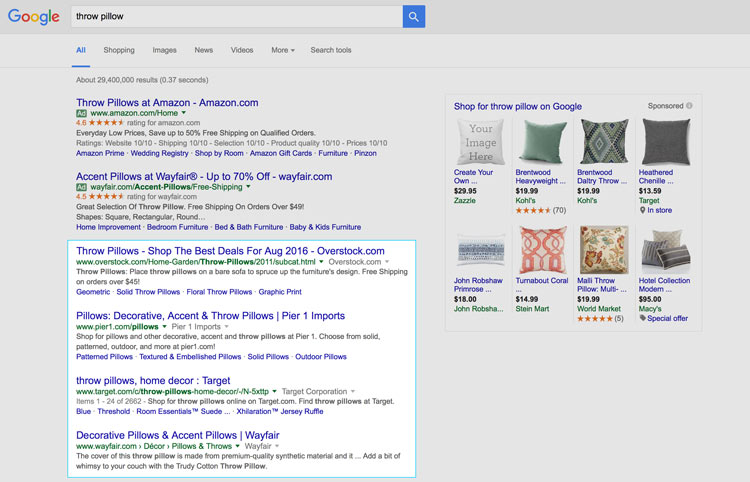
Based on the keywords you use in your search, you may also see a list of results that looks visually different than the organic search results. These are the PPC advertisements.
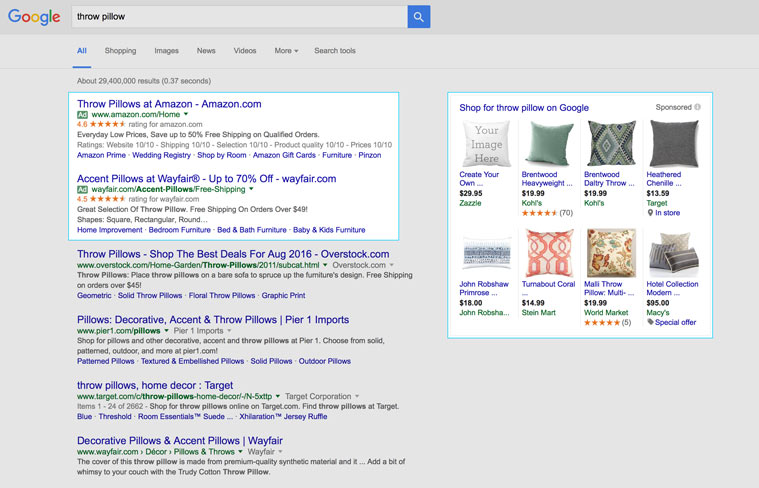
The search engine platform (in the case of our screenshots, Google) chooses what ads to show in this space through their respective PPC advertising system, using a variety of factors that we’ll cover in more depth below. As we said before, the major benefit of a PPC advertisement campaign, as opposed to most advertising channels, is that you only pay when someone clicks the advertisement link and is directed to your website – in effect, you are only paying when your advertisement proves successful.
The first step of any PPC campaign, regardless of the platform you choose, is to generate a list of keywords that are not only relevant to your business or industry, but are also the types of terms that a potential client may be searching for. For example, although an IT security provider might call one of their products a “security appliance” or “network intrusion protection”, the average potential customer might instead be searching for a “network firewall”.
The second step is defining your demographics and setting up your campaign to reach them. If you want your ad to reach business professionals, you should be running your ad during work hours, while a family-fun center may want to focus their ads to run on holidays and weekends. Each platform gives you a variety of different targeting options, from day and time, to gender and age.
Third is to design or write your actual ad. Most platforms still utilize text ads which are limited to about two short lines of text, so it’s important to make sure your messaging is on point, and is cohesive with the keywords your targeting. For example, if you’re using keywords related to window treatments, you don’t want your ad copy to be focused on table linens.
The last step is to identify your budget, which is typically entered as a maximum out-of-pocket figure that you are willing to spend each day. We recommend a minimum budget of $3 per day, regardless of your industry and campaign, but this number can grow exponentially depending on the scope or the needs of your advertising.
As with every form of marketing, it’s important to consistently review how your campaign is performing, including reviewing the performance of traffic that it brings to your website. You may find that the traffic you are bringing in through certain keywords performs very well compared to other traffic, which may mean you should increase the budget allocated to those specific keywords. Or, you may find that traffic that is directed to a specific product page results in purchases more often than traffic that is directed to the homepage. Reviewing this data on a minimum monthly basis, and making campaign adjustments depending on the data you are seeing, current industry trends, and your overall business or marketing goals, is essential for the success of a PPC advertising campaign.
At Grid, we’ve created and implemented many PPC advertising campaigns, and would be happy to review your current campaign or consult with you on how a campaign could fit your marketing strategy.
by on Aug 7, 2018
While still in the early years of the internet, it became clear that there would need to be a way to organize and find the information that was becoming available on numerous websites. Throughout the 1990s the technology for reading and indexing websites evolved, both as a result of improved technological capabilities, and as new needs arose. By the late ’90s, all of the major search engine names we know today (Google, Bing – previously know as MSN Search, Yahoo, Ask.com, and more) were in development.
As more websites were published, businesses started to see the value in being ranked higher than their competitors in search results. Being listed as number one or two for popular keyword searches could mean the difference in millions of dollars worth of sales, especially if you were an online retailer who relied on getting as much website traffic as you could. Search engine optimization (SEO) was born from this need. SEO is the process of influencing the placement of a website in a search engine’s list of unpaid, or “organic”, search results (a website’s placement in paid search listings is covered in more depth in our article “The Basics of Pay-Per-Click Advertising”). There were, and still are, two primary approaches to controlling a website’s SEO, the white hat approach and the black hat approach.
As you may have been able to determine from the name alone, the black hat approach to SEO relies on aggressive, often under-handed tactics that either outright violate search engine terms of service, or at the very least, go against the spirit of the guidelines. Black hat SEO is generally disapproved of by professional agencies and search engine optimization experts, as the practice focuses primarily on gaming search engines’ algorithms, instead of improving the value of the website to the viewer.
When search engines were in their infancy, a large part of the onus of determining what keywords were relevant to a website or for classifying the content of a website, was placed on the website itself. This was done primarily through a series of special “meta tags” used in the website’s code that would, for example, give the search engine an easy list of keywords that were applicable to the content of the page, or a summarized description of the content. On a travel agency’s website, for example, a page dedicated to Paris tours might have keywords of “Paris tours” and “international travel”, whereas the contact page would have keywords of “contact a travel agent” and “travel agent phone number”. Problems with this system arose when companies began overloading their websites with terms that were not relevant to the page content, hoping to gain website traffic from having their website listed among search engine results for popular but non-relevant terms. A travel agency website, for example, might start listing keywords like “home mortgage” and “coupons”.
Search engines were quick to recognize that they would live or die based on the quality of the search results they provided. As competition between the search engines intensified, and as individual websites continued to overload their keywords, search engines began to move away from trusting the “word” of each individual website, and toward using more complex algorithms that use a variety of factors to influence search rankings – algorithms that continue to evolve even today. With every round of changes that have come to search engine algorithms, black hat SEO practitioners have tried to find ways to continue to “game” the system, which has resulted in a number of black hat techniques including, but certainly not limited to:
Black hat SEO techniques can seem attractive at first glance. When you get a phone call or an email from a company offering to get you in the “top five spots in Google,” they are most likely offering some sort of black hat technique that draws you in with a low cost.
In a best-case scenario, if you engage in (or hire someone to perform for you) black hat SEO, you may see a short-term increase in your website ranking. However, search engines are in the business of giving their searchers relevant and helpful results. It is, therefore, in their best interest to actively identify and combat every black hat technique that is developed. As they make adjustments to their algorithms, you will see your website ranking decrease, and the money you had spent on black hat SEO in the first place will have gone to waste. Do you think you have the time and resources to stay one step ahead of some of the largest companies on Earth? In a worst-case scenario, one or more of the big name search engines identifies your website as one engaging in black hat techniques, and as a consequence, they de-list your website from any and all search results or ban your domain completely. Can you really afford to risk having your website blacklisted?
Examples of black hat SEO are referenced here purely as an educational reference, and are not endorsed nor offered by Grid.
Behind the scenes, the need for more accurate search engine results, and the transition of internet-usage from collegiate and professional situations to our everyday lives, drove a slew of technological and computing-based advances. Amit Singhal, a Google Fellow, put it perfectly when he said that over the past decade, the expected results of a search engine query have moved away from “give me what I said” to “give me what I want”. Search engines and their associated technologies are no longer looking at specific queries (“corporate accountant”) and matching those word-for-word with websites that said they were relevant, but are instead extrapolating the meaning behind a search (“how does an S Corp track its finances”) and providing website results that offer the most value to the searcher. When you stop trying to affect how a search engine sees your website, and instead focus on the experience and the benefit you provide to your website’s visitors, you are engaging in white hat SEO.
White hat SEO uses a series of tried-and-true methods for improving your website’s search rankings, while adhering to a search engine’s terms of service. There are a wide variety of techniques that fall in this camp including, but by no means limited to:
Not every factor that goes in to a search engine’s algorithms is related to your website, or your internet presence. Some factors are, in fact, influenced by the searcher, and are why two people can search for the exact same keyword, but get back very different results. These include:
After all this information about search engine optimization, you may be thinking that SEO is important for absolutely every website and that you should drop everything and start working on it! But with all marketing, that’s not necessarily the case.
SEO is a long-term, often very intensive process, where results can take months if not a year or more to propagate. At Grid, we consider your overall business and marketing goals to see what sort of role SEO would play in moving you toward those goals, and consider that role against other opportunities that may cost less but do more. It’s important to remember that search engine algorithms are changing constantly (as often as 1.5 changes per day, according to Google CEO Eric Schmidt in 2010), and without a long-term commitment to the SEO process, you may see the work that you’ve put in negated by a simple algorithm change.
However, if your business relies heavily on search engine traffic, sells products online, or is in a relatively competitive industry, SEO may be the next important step you take for your marketing. If you’d like more information on your current SEO rankings, or to discuss what an SEO implementation strategy may look like for your business, we are happy to take a look.
by on Jul 31, 2018
During certain times of the year, whether that’s the holiday season or a particularly busy season for your specific industry, it can be harder than normal to catch the ear of potential customers. They may be inundated with marketing from larger and more boisterous competitors, or the cost of media buys may be through the roof due to demand. But there are two frequently overlooked forms of marketing that can help you cut through the noise of competitors, reach potential customers the you previously didn’t have access to, and build loyalty with your current customers – all with a budget-conscious price tag!
An affiliate program is a program where your business rewards an affiliate (whether that’s an individual or another business) for each sale attributable to the affiliate’s own marketing efforts. Although this concept of revenue sharing pre-dates the internet, its popularity grew alongside the rise of eCommerce and online retail due to the benefits it provides to both merchant and affiliate. Merchants favor affiliate marketing because of the “pay for performance” model, meaning the merchant only incurs a small expense once a sale has been made, while affiliates are able to make money without having to create their own product, stock inventory, fulfill orders or process customer payments.
Although every affiliate program is unique, there are some overarching aspects that remain the same. As a business, you invite people to become an affiliate (or, you are approached directly by people wishing to become affiliates) and offer them access to all sorts of marketing material they can use to push your product or service. This type of material could be digital banner ads, print ads ready to be sent to a publication, radio ads with blank space for you to input your business name, a template website, or a product catalog with their contact information printed inside. For each sale that comes through as a result of the affiliate’s marketing efforts (tracked via a special purchase URL, or discount code used at checkout) you offer the affiliate some form of compensation: a percentage of the sale made, a flat payment after a certain number of sales, a credit with your business for future purchases, etc. The goal is to enable the affiliate to do the marketing for you, keeping your costs low while still promoting sales.
Affiliates can take a number of forms, from individuals trying to monetize their blogs, to social media influencers capitalizing on a large number of followers, to businesses who want to round out their online store with more products. Some of the most well-known companies offer affiliate programs, such as Amazon, iTunes and Microsoft.
Sometimes affiliate programs can grow large enough to introduce multiple tiers of affiliates, where an affiliate has their own group of people underneath them making sales for a smaller compensation than the original affiliate. Some of the most popular examples of multi-tier affiliate programs are Mary Kay, Tupperware and Pampered Chef.
The hardest part of implementing an affiliate program for your business is going through the process of defining exactly what the program will look like. You need to consider how you will attract individuals or businesses to become affiliates, what your compensation structure will be, how compensation will be tracked and paid out, what collateral you should make available to your affiliates, and what impact the program will have on your current business processes and resources. However, with some proper foresight you can put together an affiliate program that builds off itself and can provide a much needed boost to your bottom line.
While affiliate programs work by tapping into your affiliate’s pool of potential customers, loyalty programs specifically focus on getting your previous customers to become repeat customers (and you know what they say, it’s cheaper to get repeat business than it is to drum up new business). These programs work by offering a reward to the customer for making a certain number of purchases, reaching a certain total dollars spent threshold, or purchasing several times within a specific time period. These rewards can be VIP discounts, access to special events, prizes, or free products or services.
Loyalty programs are incredibly common and can be found across a variety of industries such as coffee shops, restaurants, airlines, grocery stores, gas stations, hardware stores, hotel chains, financial institutions and fashion retail stores. In fact, I’d bet that you reading this are either currently a member of a rewards program, or have taken advantage of one before!
The benefits to offering your customers or clients a loyalty program are numerous, but we’ve highlighted some of the top reasons below:
Through the years brand loyalty or brand recognition has consistently been one of the top motivators when it comes to purchasing decisions. By using affiliate marketing or loyalty programs, you tap into the power of the customers around you. Affiliate marketing uses these customers as brand evangelists, spreading the word about your product or services to their friends and followers. Loyalty programs, on the other hand, work to bring your current customers back time and time again, by offering perks and rewards for their loyalty. If your considering implementing an affiliate or loyalty program, or aren’t seeing the results from the program you already have, drop us a note! We’d love to consult on your current marketing strategies, and how they can be improved to help you reach your specific business or marketing goals.
Photo provided courtesy of flickr user Joe Loong.
by on Jul 31, 2018
It’s six months into the year and your marketing agency just gently reminded you that it’s time to start preparing for the upcoming holiday season. Your shoulders tense up, and your stomach drops – didn’t we just FINISH the last holiday season? We still have months before the next round of holiday shoppers descend on our stores!
Non-holiday related businesses see an average of 40% of their total sales come in during the last two months of the year. Although we don’t recommend holiday planning specifically for every type of business, the same concepts can be applied for any season in which you see most of your business. Accountants, for example, can use these same strategies for planning the months leading up to tax time in March and April, and tanning salons can plan for the months leading up to the beginning of summer.
Holiday planning (or planning for your specific busy season) should be a large part of your annual marketing plan, which we discuss in more detail in our article titled How to Build a Marketing Plan. If your annual marketing plan hasn’t sufficiently covered your holiday plan, don’t panic! Looking over your holiday plan five or six months in advance of the actual season gives you time to evaluate your business, identify your goals, create a holiday plan, make all media buys, and ensure all moving parts of the plan are in place well in advance of crunch time!
Every holiday plan will be different business to business and industry to industry, so we can’t spell out exactly what your plan will look like (although we’d be happy to consult with you one-on-one to go over your unique needs). We can, however, give you some overall tips and tricks to keep in mind as your holiday plan is coming together.
Certain seasons, like the holiday season (November and December), the back to school season (August and September) and the beginning of summer season (April and May), are very busy with businesses marketing heavily against each other. With this amount of “signal versus noise”, it can be difficult to have your marketing message stand out, especially if you’re competing against big name brands with big name marketing budgets. To combat this, you should begin enacting holiday-related campaigns as early as September. That doesn’t mean every marketing campaign from September on should reference the upcoming holidays – instead, you should be building brand loyalty and reputation with your previous and potential customers. Customers are more likely to open an email from a brand they quickly recognize versus one they haven’t heard from in a while and may not remember.
Starting your holiday campaigns early gives you the perfect opportunity to engage early bird shoppers. These types of consumers respond favorably to time-sensitive sales, free shipping, two-for-one offers and giveaways. For this specific demographic, you’ll want to use your early campaigns to generate both a sense of urgency and a sense of “winning” by offering great deals well in advance of the holiday.
Avid holiday shoppers value their time, so a picture may indeed be worth a thousand words. Instead of expecting your customer to read a lengthy email or product description, consider engaging them with high-quality visual media, like professional photography or a video about your product or service. Video in an email leads to a 200-300% increase in click-through rates compared to non-visual content.
Certain terms are more engaging to consumers around the holiday (such as “tricks” and “quick”). Your usual content copy strategy for marketing collateral may need to be adjusted specifically for your holiday campaigns to account for your customer’s mindset around the holiday season. According to research by Outbrain, headlines and links that contained certain keywords like “cocktails” and “shopping” see higher click-through rates than other terms.
Gift cards are incredibly popular with Millennials, which represent one third of the current U.S. population. Convenience, practicality, and the ability to use gift cards online have made gift cards top sellers during the last few holiday seasons. Do you offer gift cards or certificates for your products or services? How do you issue these, and how do consumers redeem them? Consider your process, and start reaching out to any third party companies that may need to be involved in printing cards, distribution, or redemption.
Create campaigns that encourage customers to get involved in the mix. This could be anything from a website that adds a funny filter to a user uploaded image, to a social media giveaway that invites people to send in photos of their pets dressed like Santa. The more outside of the box and fun the experience is, the more likely it will be shared.
Your holiday plan should be visible and consistent across all of your marketing channels, from in-store displays to your social media to your radio advertisements. Make sure to train your in-store staff so that they understand the deals, online offers, and any restrictions that may apply.
Smartphone and tablet usage continues to dominate web traffic and shopping habits, especially during the holiday season. In 2014, 52% of those who shopped online used smartphones or tablets (up from 41% the previous year). Make sure your email campaigns, digital advertisements, and, most importantly, your website and eCommerce solution are easy to use for mobile viewers.
Will your website be able to handle a sudden influx of traffic as a result of a particularly successful email campaign? Do you have enough staff on hand to fulfill orders that come in and meet shipping deadlines? Start putting processes into place that allow you to scale as needed to meet the demands of the holiday season.
Holiday shopping continues past New Year’s Day, and so, too, should your holiday plan. Post-holiday consumers are usually shopping for themselves, indulging in purchases they normally wouldn’t during the course of the year. These types of consumers are looking for post-holiday deals, and are driven by deep discounts over retail prices. Use this as an opportunity to clear out inventory that is harder to move during other times of the year, or inventory that will be outdated by the next holiday season.
It may feel like the holiday season is too far out to start planning for, but with the amount of potential sales on the line, it’s worth the time and effort now to save headache, hassle, and budget down the line. If you’re not sure what a holiday plan should look like for your business, or have not seen significant returns on your previous plans, get in touch! Grid can help you evaluate your business goals, put together a holiday plan, execute your marketing campaigns, and set you up for continued success over the next holiday season.
by on Jul 31, 2018
There’s no better feedback available than what you can learn from your current or previous customers: from how they heard about you and their purchasing experience, to the likelihood of a future purchase and the effectiveness of your overall brand. Your customers have first-hand experience that you can (and should!) be using to your advantage. Remember, it’s not what YOU think about your business, but what THEY think about it.
Our client, CAPS Aviation, is a leader in the corporate air parts, equipment repair, and tool calibration industry. In addition, they offer important and insightful training experiences and certifications, such as in-flight first aid, cabin services, and crewmember emergency training. Although their training courses are already considered to be some of the best available in the California area, CAPS Aviation wanted to ensure that their students were completely satisfied with their training experience, from start to finish.
To capture this information, we worked with CAPS to define a limited set of survey questions that would provide the most actionable information. Survey participation decreases exponentially for every question you ask, so we limited the survey to 10 questions or less, and provided a tangible incentive — complete the survey and receive a $10 Amazon Gift Card. The expense of offering gift cards to participants is incredibly small when compared with the cost of each individual training course, and it shows the participants that their feedback and time is valued. While many companies only offer you a “chance to win” for completing a survey, our participants would appreciate knowing their time is directly and immediately rewarded.
Next, we focused on the content of the questions themselves, carefully balancing the need to ask for very specific feedback with the ease of taking the survey. For example, asking a participant to rate their overall experience with your business can give you an idea of that persons sum experience, but are you able to identify exactly what worked well or what didn’t? Do you have follow up questions to get a better understanding of why the participant provided the rating they did? If yes, did you really need to ask their overall satisfaction in the first place? Remember, every additional question results in a lower survey completion rate, so your questions should be as streamlined and concise as possible, while still providing you with actionable feedback.

You should also consider the language you use, to prevent leading the respondent to an answer they might not normally have given. Asking “Would you like free coffee in our waiting room as our way of saying thank you for being a customer?” will get you very different results than asking, “In what ways can we improve your waiting experience?” even though both questions are related to the same topic.
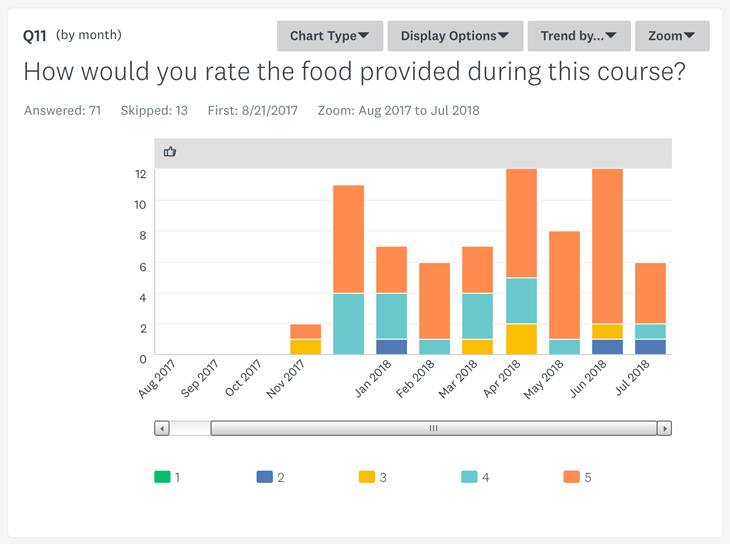
To encourage participation in this online only survey, we designed an email campaign that is sent to each training participant within two weeks of the completion of their course, to capture feedback while it is still fresh. The email is well branded, prominently features the “reward” for survey completion, and shows the customer that CAPS Aviation takes the satisfaction of their customers seriously. This invitation also acts as a marketing piece, as a way to invite these customers to return for future training and certification opportunities.
Since the start of this post-training survey campaign, CAPS has seen a 71.54% open rate on the email campaign, a 50.89% click rate into the survey, and a 33.6% full survey completion rate (as a percentage of all emails delivered) — percentages that have far exceeded our expectations!
If you’re ready to evaluate your level of customer support and satisfaction, let us know! We’d be happy to evaluate your desired outcomes, create a focus group or survey response strategy, execute the campaign, and work with you to analyze your results.
by on Jun 27, 2018
Media planning is the process of determining which media to use and what type of advertisement spots to buy to either support your company’s overall marketing strategy or a specific marketing campaign. The process involves devising a strategy, negotiating and purchasing, while taking into consideration what is being advertised, who the target demographic is, and what the campaign goals are. Due to its importance to the success of a campaign, the relationships needed, the complexity of the terminology and the reports, and the level of previous experience needed to do it correctly, we highly recommend that you partner with a knowledgeable and experienced marketing agency for your media planning.
Advertising Agency vs Marketing Agency
It’s a question we hear often: what’s the difference between an advertising agency and a marketing agency? Media planning is one of the key areas where an advertising and marketing agency differ. Advertising agencies work with media publications, such as radio, tv and newspapers, to purchase bulk groupings of available ad space at a significantly discounted rate and then turn around and attempt to sell that space at a mark-up to their own clients. This type of approach naturally results in trying to offload lower quality advertising spots on unsuspecting clients, or pushing spots that are not appropriate for that specific client’s needs.
On the other hand, a marketing agency approaches advertising buys through a carefully thought out media plan. Although the cost of the actual buys may be a little more expensive than going through an advertising agency, by using a marketing agency you are guaranteed to purchase spots that will align with your marketing strategy, reach your target demographics, and provide an overall better return on the investment.
Developing a Media Plan
The first step in developing a media plan is a careful review of your marketing strategy and an evaluation of your industry, the consumer market, and the state of each individual marketing platform. Through this analysis, we will be able to better understand what framework the marketing campaign will be working in, and what outlets may be more or less effective. For example, if the marketing campaign will happen during an election year, running a radio ad on a news station may reach further than during similar times in non-election years. At the end of this step, we will have a good understanding of what the specific objectives of the campaign are, who the demographics for the campaign will be, and what outside influencing factors may play a role in what media is used for advertising.
The second step is to determine to what extent the target audience must be exposed to the campaign message in order to reach the objectives of the campaign. We determine what reach (the number of different persons or households exposed to the campaign), frequency (number of times within a time period that the target demographic is exposed to the campaign) and continuity (how the campaign is spread out over the time period) will be needed for each component of the campaign in order to reach the objectives.
The third and most intensive step is devising and implementing the actual media strategy. During this step, we make three important decisions: what media mix to use (television, radio, print, etc), where to advertise geographically, and when to advertise, all while balancing the needs against the campaign’s budget.
It’s difficult to emphasize just how much of a role budget plays in this phase, not just from the standpoint of what can be purchased, but also what role every purchase has on the overall campaign itself. For example, if a campaign needs a certain amount of television reach to prove effective but there isn’t enough budget to obtain that amount of reach, it affects the balance of the media mix, which will affect what demographic can be reached, which affects what messaging to use, which could ultimately affect the objectives of the campaign in the first place. The real difficulty in media planning is walking that fine line between maintaining the objectives of the campaign, putting together a plan that can deliver that campaign effectively, and remaining within the budget.
An experienced marketing agency will be able to stretch your budget further than you could on your own through several approaches. First, we will be able to narrow your buys down to only those that will prove the most effective, cutting out the cost of a “spray and pray” approach. Second, we have the experience necessary to negotiate each buy down to the lowest cost possible, without sacrificing reach or frequency. We also have established relationships with media representatives, which gives us more buying power because we are often negotiating purchases for multiple clients at once. Last, most media outlets offer agencies a discounted purchase rate because they know their work will be streamlined by working with a professional agency, as opposed to a business owner who may never have run that type of advertisement before.
The final step to media planning, as with every marketing campaign, is to evaluate the performance of the campaign. You should identify the strengths and weaknesses in the campaign, how (or if) they are related to the media planning itself, what that means for future marketing efforts, if there are any opportunities for follow-up marketing to capitalize on the campaign you’ve already put in place, and determine if any changes should be made to your marketing strategy as a whole.
At Grid, we have over a decade of experience in working with regional and national media outlets to plan and execute media plans for a wide range of types of campaigns. If you’d like more information on how we can help your business with media planning, contact us!
by on Jun 26, 2018
Everyday Hands is a Rochester-based company that gives individuals and business an extra set of “helping hands” in a variety of situations. Whether you have an aging parent who needs companion visits, need hosting a corporate event, or are looking to de-clutter your home, Everyday Hands is the company you want to call!
As we started our marketing work with Everyday Hands, the largest-impact marketing opportunity we identified was improving the website experience for their current and potential customers. The original website was not responsive (didn’t work well on mobile devices), contained outdated information, and did not portray the professional quality of Everyday Hands and their staff.
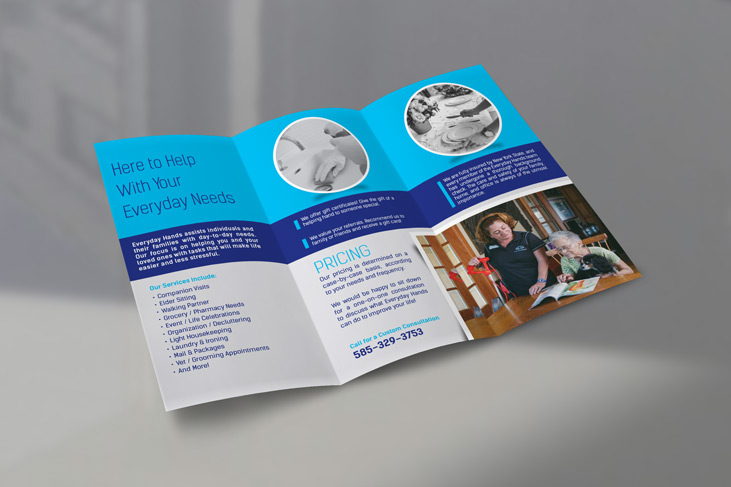
We began our website work by walking the client through how domain registration, renewal, domain name systems (DNS), website hosting, and email services work. It’s important to us that our clients understand these processes and how they are related. This allows our clients to make the most informed decisions about their websites moving forward. During this discussion, we discovered that Everyday Hands’ previous web developer had been responsible for registering their domain and setting up the website hosting. The developer had listed their own personal information on all of the accounts, and never turned access, passwords or ownership over to Everyday Hands. This meant that neither we, nor Everyday Hands, could manage or make updates to the website, the hosting service, the domain name, or their email accounts.
Sorting out the account ownership issues became our top priority. No matter what marketing work we do with or for our clients, it’s important that our clients have full ownership of their critical business assets, such as their domain, hosting, and email services. Some domain registrars have a process in place for claiming ownership of a domain if you are not listed on the account, but these processes are long, cumbersome, and often come down to a single person at the domain registrar making the decision one way or the other. This verification process is needed to ensure that random individuals aren’t able to claim websites for business they do not, but they are not foolproof methods of reclaiming a domain. At the end of the day, if you aren’t listed on the account, you run a high risk of losing control of your accounts for good.
Unfortunately, Everyday Hands’ original web developer was completely unresponsive to their requests to claim the accounts, and after several months of efforts that ranged from petitioning the domain registrar, to going to domain auction / back order, the client was unable to gain ownership of their original domain. This meant Everyday Hands was forced to select a new domain, update all of their marketing collateral (including business cards, tri-fold brochures, social media accounts, etc), update their email address with all of their clients and vendors, and create a new website.

With this frustrating setback behind us, we moved on and helped Everyday Hands choose and register their new domain (in their own account!), set up new hosting, transition their email accounts to the new domain, update their marketing collateral, and launch a brand new website that took advantage of newer technology and an improved customer experience. Although we wish Everyday Hands could have reclaimed their original domain, the experience serves as a reminder about the importance of working with professionals who have your businesses best interest at heart.
If your unsure of who is listed as the owner of your domain, that’s a sign that you could use a consultation with us! It’s quite often we hear that an office manager who left 2 years ago, or the neighbor’s kid who’s now off at college helped to do it, and that can put your company in quite the bind should you need to make changes (or even renew it to keep the status quo). We can help you track down those details, ensure your accounts are set up correctly, and even make recommendations for the safety and security of those accounts long term. Get in touch with us today!
by on May 30, 2018
Just because advertising is trending into the digital realm doesn’t mean all other forms of advertising are dead. Earlier this year, we were tasked with finalizing the marketing strategy for Finger Lakes Opera’s 2018 production of Johann Strauss Jr’s Die Fledermaus, the chosen opera for this years annual production. As we worked together through the budget and marketing planning process, we were able to challenge the client to think more strategically about their advertising buys, especially when it came to print.
Those Who Forget History…
The first step to evaluating what print advertising strategy we should have moving forward was to see exactly where we “had been” – meaning, what sort of print advertisements had they run in previous years, in what publications, at what size and frequency, and what sort of metrics they had been able to collect about how well each ad had performed in converting to viewers to purchasers.
Unfortunately, as is very common when it comes to print advertising, there were plentiful records about how and when the advertisement had run, but no data about how the ads had actually performed – which left the client unaware of the value of investing resources into print advertising again.
Given Finger Lakes Opera’s demographics (discussed more below), we did not want to cut out print advertising altogether, but we knew any strategy we put in place moving forward would need to provide analytics at the close of the campaign, so that we could base future print advertisement decisions off real data.
We also found that there was no real reasoning behind why ads were placed in certain publications – another very common scenario when it comes to print advertising. Very often ad placement comes down to which advertising representatives got their foot in the door at just the right time in the budgeting or advertising timeline, or who was able to put together the most cost attractive advertising package. With our experience in working with publications, we knew we could improve the buying decisions moving forward with a little dose of strategy.

Leveraging Existing Relationships
There’s nothing prohibiting any person or business from contacting a publication and placing their own print advertisement buy. What makes it advantageous to work through an Agency, like Grid, is that we have long-term, already established relationships with each individual publication. Often, we have been working with the same representatives at the publication for a number of years. They can anticipate the needs of our clients, they know how we prefer to communicate (when to email casually versus call with important information), and they provide dedicated service for us when any issues do arise. Our representatives also help us by sharing their “insider” knowledge about upcoming issues. If, for example, a publication is running a special interest issue, or featuring an article that is related to the industry of one of our clients. This relationship also means more favorable pricing, better placement of ads, and can include perks like extended due dates!
Targeted Placement
When considering what publications to run ads in, we don’t just consider the total number of subscribers, reach, or audience size. The most important thing to consider is what sort of demographic you want to put your messaging in front of, how that demographic consumes content, and what publication they would most likely be reading. We make it a point to review data available from the publications themselves to evaluate their demographics, which can include information like location, age, gender, income, or product preferences. It’s important that the publications we choose reach the target demographic that would be interested in our advertisement. For example, you wouldn’t want to place an ad for a high-end luxury car in a high school newspaper.
Buying in “Bulk”
As an agency, we are often able to reduce the price of a print advertisement even further by purchasing “in bulk”, both because of the frequency in which we purchase ad space for clients, and because we know how many ads we want in each issue of a publication well before the deadlines come due. In addition to this purchasing power, we can also work with our representatives to create comprehensive advertising packages that include more than just print. Most print publications also have digital versions, regular email newsletters, video opportunities, and/or a powerful social media presence. By putting together a package of different types of advertising opportunities with a single publication, we can bring the cost of print advertising even lower while also extending the reach of our campaigns.

Coming Full Circle
Working through an agency isn’t only about getting you a better deal. It also means the entire process is easier for you! We handle reviewing the publication rates and demographics, configuring the most attractive packages, negotiating the best deal, ensuring the quality of the ad is top-notch, and making sure that you receive all follow up material related to the performance of your campaign.
In addition to helping you determine ad budgets and placements, Grid can handle all of the creative, too; from designing the artwork, to licensing or shooting necessary photography. We prepare the files per each individual publication’s specific and unique guidelines and requirements (and trust us, they all have their own set of specs)! We handle the delivery of those files, whether that’s emailing the file, providing a Dropbox link, using their FTP, or submitting via a custom client portal.
Conclusion
Even though all the Yellow Pages is good for is killing big spiders or reaching tall shelves, that doesn’t mean all print is dead or outdated. In fact, print has in many ways become a luxury good, meant for those who have extra time, prefer the tactile feel of print in their hands, or are tired of squinting at a fingerprint smudged smartphone screen. While that doesn’t mean every business and every message is appropriate for print, it does mean there are still a number of strategic opportunities for print advertisement. With a little legwork, industry knowhow, and advertising experience, we can help you turn print into a very success tool for your next marketing campaign!
by on Apr 19, 2018
Fort Knox Federal Credit Union was launching a new credit cards balance transfer campaign, and turned to Grid to help build momentum and promote the campaign. In addition to in-branch marketing efforts and a robust digital display and re-targeting campaign, we strategized a preroll video advertising campaign.
What is video preroll? You’ve certainly seen it - when you watch a video on a news website, or watch content through a streaming service like YouTube, you sometimes see a video advertisement prior to your content. Sometimes, these are full 30 second ads (with the ability to skip it after several seconds), while other times they are shorter and un-skippable. For Fort Knox, we wanted to keep the videos brief, about 15 seconds in length, and we wanted to produce several variations so that viewers who saw the ads multiple times wouldn’t find them repetitive. Our goal was to achieve a high completion rate (meaning the viewer watched the video in full), while also keeping the messaging prominent - that this was a great rate for a wide variety of individuals.
We typically prefer to shoot all of the photos and videos for our campaigns ourselves. This gives us the best opportunity to ensure continuity between online, offline, still and motion elements across every aspect of the campaign. But, when we don’t have that luxury (whether that’s due to budget, logistics or timelines) we can purchase footage assets from a number of our agency resources. The Fort Knox balance transfer campaign came with fairly short notice and wasn’t suited (due to seasonal constraints) to shooting everything ourselves. The client’s in-house creative team had already identified several very strong photographs as a starting point, and turned to us to put together video assets that mimicked the same look and feel.
We researched multiple sources of stock footage, and pulled together several videos that used acting talent that strongly resembled the provided photographs, and then color graded the footage to further establish a match. Doing this ensured that it would be easier to match the colors, typography and other creative decisions in the print, direct, in-brand and social elements of the campaign.
With the creative complete, we worked with our advertising placement partners to target where these videos would be shown - we wanted to target individuals who were most likely to take advantage of the offer. Using a combination of geographical targeting, age, education, income and interests (overlaying multiple layers of data to create several buyer persons), we were able to ensure that our preroll videos would be shown before content that our target demographic would most likely be interested in watching. That is one of the biggest advantages of preroll videos over traditional television advertising - we can place ads not just based on television show or time slot, but also on audience demographics and interests. This targeting was also done in conjunction with the email marketing and digital display buys - and once a user had seen the video or clicked through to the website, they were also more directly targeted for future ads in different formats via re-targeting.
The results of the campaign were tremendous. Fort Knox saw a click-through rate exceeding 1% (where in digital advertising, success is measured in tenths of a percent on a typical campaign), with the strongest results centered around their key markets (branches near a younger, up-and-coming audience). In fact, in their hometown they saw a view-through rate (where a user watches a video and then visits the target website later) of over 13%, demonstrating a very strong interest in the offer. For website statistics, we saw a higher than average time on site, and an increased number of papers per session from those users coming from the preroll videos. Ultimately, the campaign was so successful that the client opted to extend the campaign for another 6 weeks.
If you would like to see how video preroll can bolster your own marketing efforts, feel free to contact us!
by on Feb 16, 2018
At Grid, think it’s important that all of our team members pursue hobbies and interests outside of work, to keep their lives balanced and fulfilled. Our President, Cassandra Moffitt, stumbled onto a new passion for ballet a few years ago, and we recently helped her launch a new Patreon campaign focused on sharing her new adventure with the world. Even though Cassandra is embedded in the marketing industry, we approached her campaign no differently than we would any of our other clients - and the results in such a short amount of time have been fantastic!
Patreon is a platform that let’s you show your support for creators through small, monthly subscriptions. These creators run the gamut from video game developers to blacksmiths, illustrators to fashion designers. Cassandra originally wanted to document her ballet journey through video purely for herself, but as she began to film her classes and rehearsals many people encouraged her to share her content with the world - to show others what it’s like to take on such an intense hobby in your spare time. Patreon was the perfect platform for sharing this content!
We began by working with Cassandra to brand the campaign, guiding her through the same branding process that we use for all of our clients. The campaign ultimately became known as Pointe Progress.

Our next step was to solidify a social media strategy. We knew social media would be a significant component to Pointe Progress’ marketing strategy, so we created a very detailed content calendar and posting schedule. Cassandra knew with her already full schedule that she would need to know, on a day by day basis, what she should post about and on what channels. We started the calendar by adding her class and rehearsal schedules, milestones such as costume fittings, dress rehearsals and performances, and other major events (such as two planned international trips). From this, we were able to identify how much content (such as photos and videos) could be created from these events, and then schedule on a day-to-day basis how and where that content should be shared. To specifically promote Pointe Progress’ Patreon campaign, that meant creating some content that would be shared publicly to generate awareness and interest, some content that would be shared only to Patreon subscribers (that’s one of the main benefits of being a subscriber!), and additional bonus content that would be shared with higher level subscribers.
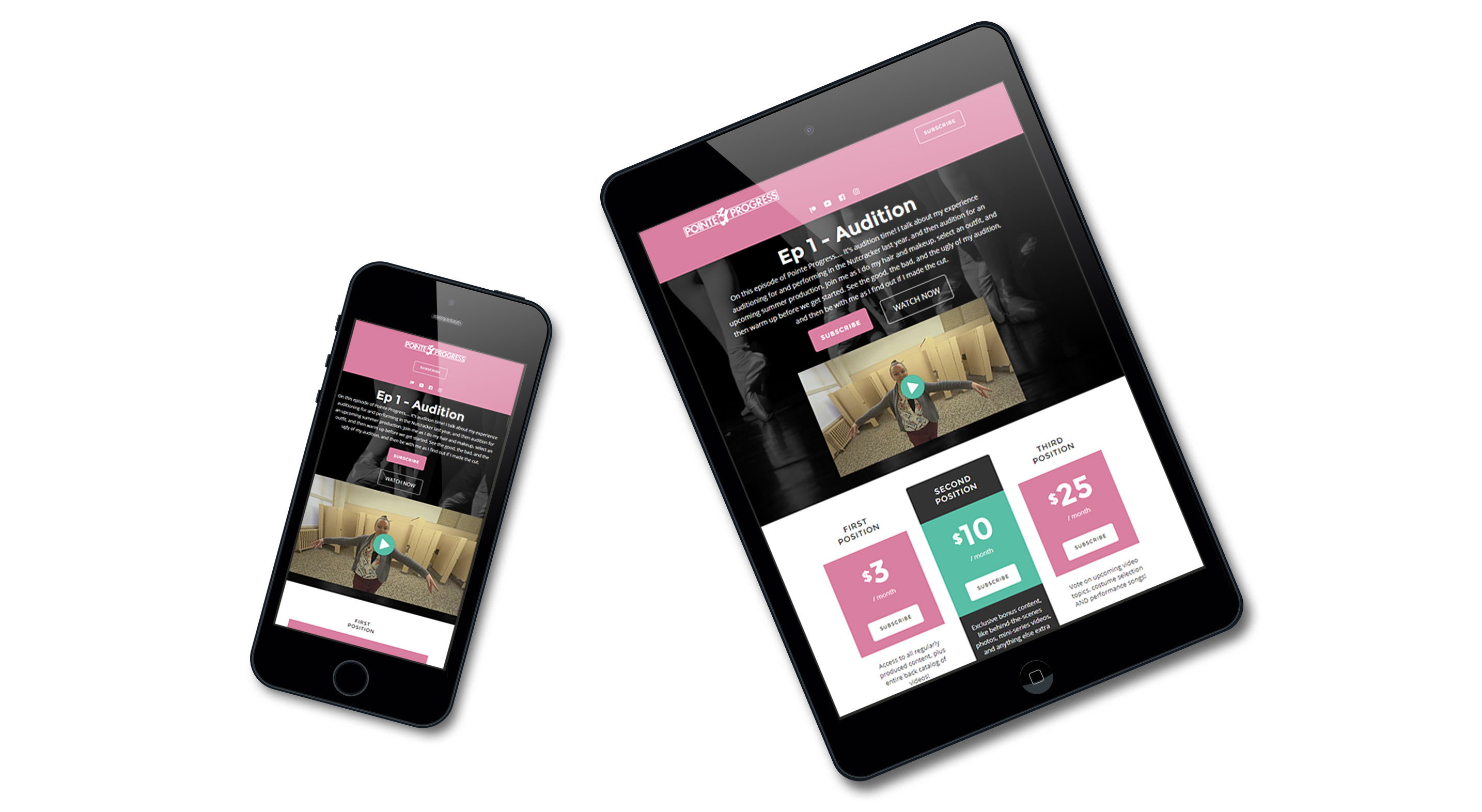
About a month prior to launch, we set this posting schedule to work. This gave us ample time before launch to identify scheduling decisions that weren’t feasible with real world constraints, or opportunities for generating additional content that we had not previously identified. After a month, we had a solid system down to ensure Cassandra was making regular posts in all of the right places. It also provided a great source of “back content” so that when the campaign launched, her social media accounts would have tons of content to keep people interested.
The next step was to start building buzz about the launch. We did this in two ways. First, we scheduled social media posts that hinted at a BIG upcoming announcement. These typically included “behind the scenes” photos to pique interest, and encourage them to like / subscribe / follow to hear the big news first.

We also ran several Facebook advertising campaigns, including one ad that encouraged page likes from a wide variety of people. We left the targeting fairly wide so that we could see what demographics responded most positively to our ads, letting us better target future marketing efforts. It’s one thing to have an idea of what your target demographic should be, but another to have real world data to support that!
Although Cassandra played the primary role in writing and directing content for her episodic videos (as it should be - she is the content expert here!), our team is supporting her efforts by filming and editing each video. This variety of perspectives and knowledge involved in the project gives her videos a polished look and feel, and ultimately demonstrates to potential Patreon subscribers that the content they will receive from her on an ongoing basis will always be of the highest quality.
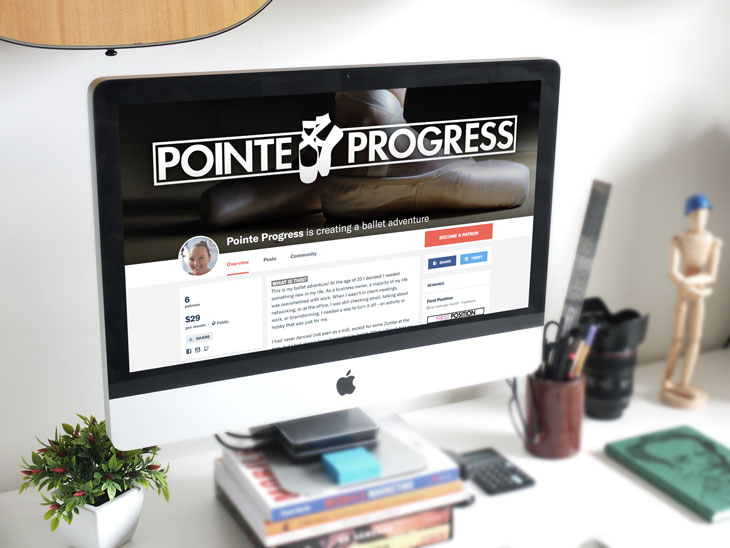
The campaign is still in it’s infancy, having launched only a few weeks ago, but Pointe Progress is already experiencing tremendous success! Within one week, our videos had been viewed over 4,300 times on Facebook alone, her page is receiving approximately 10-15 likes per day, she currently has a reach of 4,800 Facebook users, her Instagram account has seen a 134% increase in followers, and her Patreon campaign has already begun generating revenue. We are confident that this campaign will continue to grow and flourish, thanks in large part to the marketing strategy we put in place before launch.
All of us at Grid are excited to continue working on this project, not just to help the campaign grow, but also to continue to show Cassandra our support. And if you haven’t subscribed yet, there’s no better time than now! If you’re thinking about launching a new business, Kickstarter, or Patreon campaign, get in touch!
by on Nov 21, 2017
In 1983, Neil Looy founded Corporate Air Parts and Services, a humble maintenance and repair station for JetStair aircraft. Over the past 30 years, the business has evolved into a multi-faceted, one-stop shop which services Gulfstream and newer business aircraft, trains flight crews, and provides logistical support around the globe. In 2017, the business transitioned from Neil to his daughter Jennifer, who brought with her an incredible amount of experience, a strong sense of leadership, and an outlook for the business that went far beyond it’s current capacities.
One of the first tasks she wanted to undertake was a full evaluation of the Corporate Air Parts and Services brand, including an assessment of the business name, logo, and brand as a whole. The brand had not changed much since it’s early beginnings, and Jennifer was adamant about redesigning the brand to match their status as a leader in their industry. The brand needed to better characterize their forward thinking attitude, expertise, and professionalism.

We began this work by researching the current Corporate Air Parts and Services brand, their products and services, the companies they work with, their ideal customers, the current state of the industry, their competitors, and other brands that their ideal customers would be attracted to. We also interviewed internal staff, at various levels, about how they viewed the company and their perception about the direction the company was heading. Although our goal was to improve and modernize the brand, we wanted to make sure it was built solidly around the companies “personality” and vision - without that, we knew it could not be a successful rebrand.
One of the primary concerns for a new brand was that the business name, “Corporate Air Parts and Services”, no longer accurately reflected the range of their capabilities. As we discussed the rebrand internally and externally, we found it was very common for people to refer to them simply as “CAPS”. It was a moniker that was already very well recognized within the industry, and did not move too far away from the original roots. Based on this and our market research, we felt strongly that the best way to move forward would be to rebrand as “CAPS Aviation”.
The next step was to design a new logo that would stand out among competitors, while still fitting in with the industry, that looked modern and forward thinking, yet reflected their decades of experience and integrity. We presented the client with two logo options, both of which we felt could serve them well.

The first was a classic interpretation of their brand. It paid homage to the industry through the use of the plane iconography, and utilized the original Corporate Air Parts and Services brand colors of grey and dark blue. This was our corporate option - one that we knew would feel a little safer because it didn’t stray “too far” from other brands in their industry.
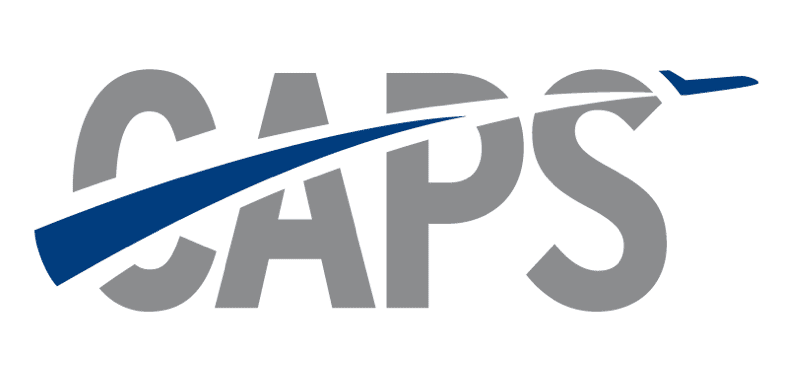
Our second option, and our top pick internally, was the riskier choice. We utilized vibrant colors coupled with bold text and strong angular shapes to make a statement. The “blades” of the overlapping A were reminiscent of the blades of a prop aircraft, and symbolized the breadth of complimentary services that CAPS provides. It takes a team to maintain a fleet of aircraft, and CAPS Aviation could serve as your trusted partner.
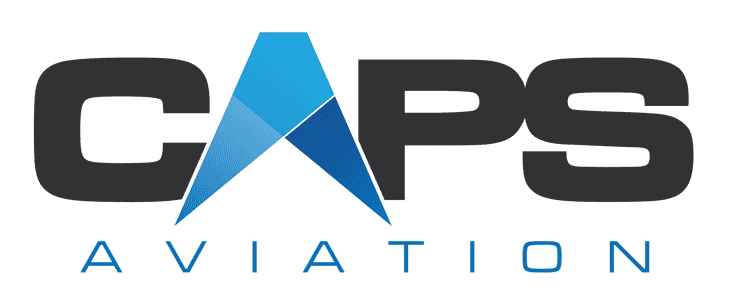
As we expected, the client initially leaned toward the first option. It felt like a more natural progression of the brand - something safer, and more well known. However, by the end of our presentation, she really began to see how the second option could drive the CAPS Aviation forward in a new and exciting direction. We provided her with some visual examples of how the second option could be used “in real life” - mocked up on a sign, or used on a water bottle. After a few days, the potential behind the brand really sunk in, and she was in love.

Since then, we have been applying the new brand to a variety of different areas as the need has arisen. Trade show backdrop and table draping, water bottles, pens, mousepads, stickers, coasters, apparel, branded giveaway items, business cards, letterhead, presentation templates, and (coming soon!) a new website! It’s been an absolute pleasure working with CAPS Aviation through their rebrand, and seeing the results of our work come to life!

If your company is considering a rebrand, talk to us first! We can help outline the process, set up a timetable for the work and rollout, and determine the budget necessary to bring the new brand to life!
by on Oct 24, 2017
Finger Lakes Opera has been delighting patrons with their productions of grand operatic masterpieces since 2013, complete with spectacular sets, dazzling costumes, inventive staging, and a professional orchestra. Over the past five years, they’ve outgrown their humble beginnings as a collaboration with SUNY Geneseo, into a standalone organization that calls Canandaigua their home.For their 2018 season, Finger Lakes Opera reached out to Grid for our expertise in planning and executing marketing campaigns to promote their productions. Our work began with the creation of a detailed marketing plan that would help guide the financial and marketing decisions over the course of the year.
The goal of a marketing plan is to provide a business or organization a time and budget roadmap for marketing efforts over a period of time. This can be everything from the start and end dates for specific campaigns, to print deadlines, to when media buys need to be solidified. When done correctly, your annual marketing plan will also serve as the starting point for future years’ planning - reducing the amount of time and guesswork needed exponentially. (If you’re still unsure about the importance of a marketing plan, or would like to learn more about how to create one, check out our Knowledge Article titled “How to Build a Marketing Plan”)
Although the end product of going through the marketing plan process is important, the REAL value is in the questions, takeaways, and decisions that are made DURING the process. Let’s step through some of the outcomes of Finger Lakes Opera’s experience:
One of the largest and most glaring aspects to FLO’s previous years marketing efforts was that very little of it had been trackable, so they were unsure what value they were getting from specific efforts. Was print ad A, priced three times higher than print ad B, producing three times the ticket sales? Was print ad C, which was run in an experimental market, worth the investment this year or in the future? By raising these questions, we were able to show FLO the impact that collecting this data (even down to a per-advertisement level) could have on future marketing decisions. This also gives us the opportunity to put tracking processes in place for this years advertisements. With these processes in place, we’ll be able to make more data-driven decisions in future years.
When it comes to media buying, there is significant power in pre-purchasing. Publications and media outlets (print, radio, television or digital) would rather work with you once to sell four ads, than try to sell you a single ad four times over the course of the year. While working through FLO’s marketing plan, we were able to determine our purchasing needs across publications for the entire year, which gave us significant negotiating power when it came to cost (not to mention, it let us finalize the timelines relating to producing each ad, so we knew nothing would sneak up on us!)
In the case of Finger Lakes Opera, we knew that printed collateral played a huge role in their overall marketing budget. With this in mind, we made sure pay attention to printing needs right from the start. What may seem like a small decision (such as whether to produce a trifold brochure, or expand the content into a four page booklet), may have a dramatic impact on the final cost of printing - and when you’re talking about printing thousands of copies, these costs can add up. To make sure we had a full view of the marketing plan and budget for the year, we needed to make sure all costs, including printing, were accounted for right from the start.
Our example in Hidden Expenses naturally leads us into the idea of streamlining your collateral. When we first sat down with Finger Lakes Opera we discussed a number of different print collateral options for the coming year, including a bifold, a trifold, a rack card, a booklet, a postcard, a fact sheet, and a donation envelope. After discussing the goals and usage of each piece, we were able to streamline this year’s collateral needs down to just a few pieces that could be used in multiple ways. Making decisions about the print needs for the coming year will result in a significant cost savings, as we know exactly what types of pieces we are producing well in advance.
Part of our considerations for streamlining collateral involved how we could make design adjustments to certain pieces so that they were usable over several years, letting FLO access more advantageous print pricing for higher quantities. For example, we discussed separating information regarding individual and corporate donations (information that doesn’t change year to year) out into its own document, so that it could be inserted into other collateral that had to be reprinted every year.
Last, but certainly not least, through the marketing plan process FLO was able to identify areas of opportunities for forming mutually beneficial relationships with other organizations. For example, with their list of their final print needs FLO will be able to approach a local printer to guarantee thertfolio of work in return for a sponsorship opportunity and ad placement within the appropriate collateral.
We’re incredibly excited about working with the Finger Lakes Opera for their 2018 season, and hope to see you at this year’s production of Die Fledermaus and other festival offerings!
by on Aug 2, 2017
It’s a familiar routine for everyone with an email address. You load up your inbox for the first time of the day and find two or three email campaigns sent by companies you’ve interacted with before. These could be company news updates, a sale of a particular product or service, event announcements or blog updates, but it’s content that you receive on a regular basis that helps keep you informed about the happenings of your favorite brands. On the other side, businesses are using email campaigns to keep their brand “top of mind” with you, so you think of them next time you have a need for their type of product or service. It’s more cost effective to keep a customer than it is to find a new one, and email campaigns are a powerful way to do just that.
There are many different types of email campaigns, and each type gives you another opportunity to build your brand with your current or potential customers.
You can’t send an email campaign if you don’t have any email addresses on your list. You can collect email addresses through a variety of means including a form on your website, through social media, visitors to your trade show booth, or people you have received business cards from at a networking event. You should also make sure to add any of your current customers, or anyone who has expressed an interest in becoming a client over the past several years.
It’s important to remember that most email campaign software providers prohibit you from using email addresses for anyone who has not agreed to join your campaign. This would include any email addresses that you have purchased, found on other websites, or for people who have specifically requested not to receive information from you.
There are a lot of deciding factors that will play into the design of your email campaign. It should have the same look and feel of your brand, but shouldn’t look like a carbon copy of your website. The design should creatively make the most of the available space and the types of content you plan to feature, whether that’s information about an event, or a link to a video.
In this day and age, it’s also important that your email campaign be mobile friendly. Most email interaction now-a-days occurs on mobile devices, including smartphones and tablets, so you should make sure your design caters to those types of views.
You should have clear calls to action so that a viewer can easily find not only the information they are looking for, but quickly understands what type of action you are asking them to perform (whether that’s to register for an event, call your office, or read an article on your website).
Last, but certainly not least, is that you should strike a very careful balance between the amount of text and the amount of graphics in your campaign. For spam filtration reasons, most email providers will block emails that are made up of mostly images – so make sure you keep as much content as possible written in actual text!
When writing the content for your campaign, always keep in mind who you are addressing and how they will consume the content. First, your content should talk “with” the reader, not “at” them – remember, your reaching out to this person through their email address, not taking out a billboard along the highway.
Take your time to write a compelling subject line – hint at the contents of the email, but don’t be 100% literal. You’re more likely to get opens with a subject line like “New Products Selected Just For You” versus “August New Products”.
Keep your content consise and to the point. For longer articles, give an overview of the topic and link them off to the full article available on (preferably) your own website. Use bullet points, creative use of type or font, or graphics to help break up anything that has to have longer chunks of text.
Watch your words! Words like “free”, “naked”, “prescription” or “pharmacy” may have a legitimate place in your content, but they are a red flag for every spam filter. Try to push the use of these terms off into the article on your website, or use an alternative term altogether.
For the more advanced, we would suggest that the content of your email campaigns follow the same content calendar that you’ve created (you HAVE created one, right?) for your social media or other marketing efforts. This helps keep your messaging consistent across multiple channels.
Your work isn’t over once you send your campaign! Over the next two weeks, you should be reviewing the data you’ve collected through your campaign, and deciding what information may need to be acted on. For example, if you find one of your included articles is receiving a significant amount of traffic, that may signal to you that your current and potential customers are very interested in that specific topic. You could follow up with additional information, work more of that topic into your social media, or highlight that topic in your next marketing campaign.
With all of the above in mind, you may be tempted to head off to start your own email campaign! However, before you do, it’s important that you be aware of the regulations that surround sending email campaigns. CAN-SPAM is a set of regulations issued by the FTC that covers all commercial messages sent by a business, which includes your email campaigns. Some of the main CAN-SPAM requirements are:
If you’ve been sending email campaigns and are seeing little return on your investment, are not sure how to review your analytics, or have yet to begin your campaigns, we can help! Our team can help evaluate the roll that email campaigns can play in your business, whether from a pre- or post-sales role.
by on Jul 26, 2017
GMR Associates, a Rochester-based expert in the development and administration of benefit plans for the construction industry, regularly collects large numbers of warm leads through a variety of their marketing and sales efforts. These leads would come into GMR’s sales pipeline in batches after GMR attended a trade show, hosted an educational seminar, or joined a new trade association. The timing and quantity of these leads made it impossible for the GMR sales team to personally connect with each and every contact, leaving potential sales on the table. GMR contacted Grid looking for automated options to further qualify leads past initial interest, so they could better allocate and prioritize their in-house sales assets. After discussion with the GMR executives and sales staff, we decided the most effective path forward would be an automated email drip campaign. We started the process by working with GMR to fully understand and scope out their typical sales process. What messaging do they start with? What facts or figures are prospective clients most interested in early in the process? Later in the process? What are the most common objections to becoming a client, and when do these objections come up? Armed with that knowledge, we laid out a map of the most important, influential, or necessary content that needed to be communicated to any potential client. That map showed us that the content could most logically be split into a series of five emails, thus comprising our drip email campaign.
The content map for this campaign was:
The first email is a re-introduction of who GMR is and what they do. This positions GMR as experienced, knowledgable and professional providers of benefit services. It also brings GMR to top of mind with the recipient, in case the recipient didn’t remember that they had requested that GMR contact them with more information.
One of the major hurdles GMR sales associates would face during the sales process was fully explaining the benefits of working with a professional as opposed to trying to handle benefit plans in house. Our second email outlined the benefits that come from working with an industry expert.
One specific service that GMR offers is their Health & Welfare Trust, which provides supplemental unemployment benefits. With this being such a unique and beneficial product, we wanted to make sure it was highlighted in the series.
One of the largest benefits of working with GMR is that they free up a large portion of your time to focus on your business, and with regulations at an industry, state and Federal level, you could get lost in the details every time they change. When you work with GMR, you can leverage their full-time focus on your industry.
If a lead made it to the final email, it was time for the hard ask. The final email invited the reader to contact GMR for more information, and let them know that a GMR sales representative would be contacting them soon.
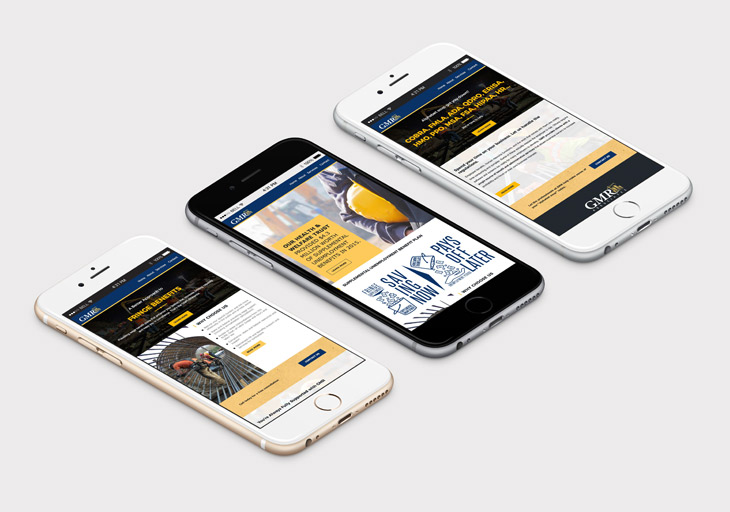
Once implemented, these campaigns helped to slowly narrow their leads to a more manageable (and more efficient) list. With our sophisticated analytics tools, GMR is able to track who receives each email, who opens it, what links they click on, how many times they click, and if they unsubscribe at any point during the process. Any lead that makes it through Email #5 was considered a high priority contact, while any lead who showed a particular interest (through interaction) in a particular email was handed to the appropriate internal resource to contact them about that topic. With this new streamlined process, GMR was able to more effectively and efficiently assign their in house resources to the right potential clients, improving their work loads AND close rates!
If you’d like to know how an email drip campaign could supplement your sales process, we’d love to talk!
by on Jul 24, 2017
Not every business venture is planned as far in advance as your marketing agency would prefer you plan. Such was the case for FourBridges Financial Group, who came to us looking for advice and direction on a new brand, as they hit the ground running in the Rochester market. They needed all of your typical business staples - business cards, letterhead, etc - and quick, as they were actively recruiting and pitching new clients to come on board. With our strength and expertise in branding, we knew it was a task we were up for!
As we began our discussion, we discovered that FourBridges had worked for several month with an independent designer on brainstorming a business name and designing a logo. The results of that relationship were, unfortunately, not as strong as FourBridges had hoped they would be. It was clear to us that much of that disconnect had come from a lack of proper market research into both the local and national financial planner industry, and into their target demographics. At Grid, we firmly believe that all branding decisions should be made with data and available research in mind. Without an understanding of who your clients (current or potential) are, and what the industry looks like, it’s incredibly hard to stake an effective brand claim.
Along this line, we began our work by querying a host of data about not only the financial planner industry, but also about consumer financial trends in general. Were people feeling optimistic about their financial futures? Was there uncertainty in the marketplace? Would clients be looking towards FourBridges in an effort to feel secure in the choices they have made, or would they be looking to FourBridges for advice on maximizing their potential? Although there’s no clear cut answers to these questions, it allowed us to get a pulse on what clients in the Rochester area would expect from FourBridges, and thus what their brand needed to convey.

When it comes to branding for a new business, it’s vitally important that the logo have a look and feel that “sits right” with the business decision makers. That is, we can tell you what is viable with consumers - what looks professional, what will work well on advertisements, what will appeal to and be accepted by your demographics - but we can’t tell you the direction you are trying to take the business. With that in mind, we concepted five different rough logo directions that we felt would be equally as strong in the marketplace. Some were traditional, some were more modern. Some were artsy, some were rigid. Ultimately, it would come down to what “sat right” with the FourBridges team.

After less than 24 hours, a selection was made and we moved into finalizing the logo, which included selecting colors, adjusting treatments, and preparing the final logos for various applications.

We’re very proud of the final results, and have since worked with FourBridges on their business cards, letterhead and website!

by on Jul 24, 2017
You may have heard the term “banner blindness,” which is the idea that consumers have been conditioned over time to scroll past or otherwise ignore digital advertisements on websites, because the ads aren’t at all relevant to their interests. If your campaign is unfocused or otherwise un-targeted, then your ads may be experiencing banner blindness - you may have an amazingly low cost per impression (that is, the cost to display an ad to a viewer), but the value of every impression is low because you’re not showing it to the right people. Just because your ad loads onto a page doesn’t mean anyone is paying attention to it.
So why, then, is digital still the best place to advertise, and is currently expanding in reach and utilization?
Most digital advertising platforms offer audio and video advertisements. YouTube and Pandora, for example, offer a combination of video, display and audio advertisements whose benefits far extend just showing an ad for an impression. On each of these platforms, users have registered and provided demographic data such as age, gender, location, and interests which allows advertisers to more accurately reach an audience that is interested in what they have to say.
Some of the most common targeting demographics are:
You can target by state, county, city or even zip code. Some platforms offer per-household or per-IP level targeting. You can also use this information to reach viewers as they enter or leave an area. If you are a brick and mortar retail location, you may want to reach people within 800 feet of your location. If you’re a bank or a credit union, you could show a vehicle loan to viewers who are near a car dealer. Conversely, you can use geography to exclude viewers if, for example, you already have excellent market penetration in one specific neighborhood, but want to continue to grow your audience in a nearby neighborhood. Through a combination of targeting decisions, using geography to target demographics can give you powerful control over your messaging.
You may want to use these targeting demographics to fine tune an advertisement for that specific viewer. If you’re a clothing retailer, you may want to use gender demographics to show women a version of your ad that uses female models, while showing men a version that uses male models. It would be a waste of marketing budget to show an ad for diapers or household cleaning products to a male teenager, just as it would be a waste to show an ad for a skateboard to a senior citizen. Mistakes like these are avoidable through the use of a targeted digital campaign.
Digital platforms allow you to target specific genres, performers, shows or interests. Want viewers who are older, with higher income? Target classical music or jazz. Looking for younger adults? Try hard rock, pop, or electronic music. Even the length of time a viewer listens to or watches videos on a platform can lend itself to patterns. A person who listens to Pandora for eight hours a day may, in general, be more comfortable making a purchase online when compared to someone who only watches short cat video clips on YouTube once every few weeks.
Another benefit to digital advertisements, besides their highly targeted nature, is that they often “stand alone”. With traditional radio, television or print advertisements, your ad is lost among six minutes (or six pages) worth of other advertisements that are vying for the consumers attention. Platforms such as Pandora allow only one commercial at a time (and only a few each hour), keeping the viewers attention on your messaging. Some platforms are experimenting with letting an advertiser “sponsor” an hour or episode of uninterrupted use, in return for watching that sponsors longer video or audio message. Recently, the Montana Office of Travel and Tourism used a similar feature on Pandora to promote ski vacations in Montana. In doing so, they saw a 347% improvement in visibility among adults 25-54, and an uplift of 144% among adult winter sports enthusiasts. (source: Pandora for Brands)
In another success story, Rusnak Automotive, a high end import luxury dealership in Los Angeles, more than doubled the industry average digital click through ratio while spending under 1% of their total annual advertising budget. Rather than aim their advertisements at a broad audience, and thus spending more money to put the ad in front of more eyes, they opted to narrow in on a very specific demographic - viewers intending to purchase or lease an Audio within the next 6 months. The campaign had a clear call-to-action and utilized “Digital Addressable” multi-screen ads (showing ads to the same viewer across digital TV, tablets, and smartphones) overlaid with Polk data to be sure the creative was delivered on a nearly per-household if not per-person basis.
If you would like to learn more about how a digital advertising campaign could work with your media buying strategy, please contact us for a free evaluation of your current and planned buys!
Photo courtesy of Flickr user Rosenfeld Media.
by on Feb 26, 2017
Vehicle graphics have presented us with some of our favorite in-office moments. We congregate in groups, we talk to ourselves, we act out scenarios, and we measure each other. All in a days work!
Great Northern Heating & Air, an up and coming business in the HVAC industry, turned to us for our expertise in vehicle graphics and wraps. They had recently purchased several Ford Transit 250’s to serve as their daily operations vehicles, and while they had poured a lot of time and effort into setting up the inside of the van to work for their needs, they were relying on us to make the outside of the van work just as hard.
We began our work by scouring the internet for photos of the right year, make and model of the vehicle. We wanted top views, side views, rear views, and even photos of the under body if we could find them (which we couldn’t, in this case). We needed to evaluate every piece of trim (is that metal, or plastic?), the functionality of the side mirrors (do those extend?), the way the side doors open (are there rollers that touch the body paint?), and how far the extension of the rear doors when opened (is it 90 degrees or a full 180?). When we couldn’t find all of the answers we needed, we took a field trip to the local Ford dealership to get answers to our few remaining questions.
Back at the office we physically re-enacted every way we could envision the Great Northern Heating & Air team could possibly interact with the vehicle. What space did we have to work with if the side door and passenger door were open? What did it look like if the left rear door was open, and someone was standing at the side of the van? You may be wondering why all of this was important – simple, we had to find any opportunity in which we could break a potential design.
For example, if we have important information showing on one panel of the truck, but 75% of the time a door will be open and blocking that panel, then our design has failed. Or, if we have a graphic that runs onto a window, what will it look like if the window is rolled down? Where are the vehicle handles or other parts of the vehicle trim that may introduce unintended meaning into a graphic laid over top?

After we had given careful consideration into all of the ways that a design could be broken, we settled on a simple, clean design that highlighted the most important takeaways for someone who saw the van: the brand, the website url, the phone number, and a brief list of the most common type of work they performed. The simplicity of the design gave our chosen graphics much more weight and importance, without things like the phone number being lost in a sea of unnecessary background swirls or landscapes. Overall, it added to the important traits of their brand – transparency and honesty in the work they do.

We were happy to work with Great Northern Heating & Air on this, and other, marketing campaigns!
by on Nov 29, 2016
Our marketing tasks aren’t always performed from behind a desk or in front of a computer. Sometimes, in fact, the only way to get the results you need is by going out there and getting your hands dirty… or cold, as was the case with a product photo shoot for Vnomics Corp., providers of True Fuel™, an advanced analytics solutions that enables fleets to improve driver and vehicle performance in real-time.
Located in Victor, N.Y., Vnomics needed new photography for their True Fuel™ product, a modem-sized device that rests on the driver’s dashboard providing real-time feedback as they operate the vehicle. The photos needed to show True Fuel™ in its actual working environment, the cab of a tractor-trailer as it cruises down a highway (preferably a sunny one, as per the client). The only problem was our tractor trailer was sitting in a blustery, snow-covered upstate New York parking lot where the December sun hadn’t appeared in days.
Getting the perfect shot in a natural environment posed many problems: Light while driving is inconsistent at best, our roads at the time were salt-covered and lined in dirty snow, and there were safety concerns about walking around the cabin of a moving vehicle while unsecured to get the right angle for the picture. Instead of taking any unnecessary risks, we used our skills and experience to deliver exactly what the client wanted, quickly and efficiently.
Without even having to put the vehicle in gear, our photographer was able to capture well-lit shots of the product in use. To aid in this, a grip, or lighting specialist, stood outside the cabin (attempting to stay warm as the snow flew) and held a reflector to bounce natural light into the cabin where the photographer needed it. We then took the raw image, which looked out the windshield from the back of the cabin, and manipulated it in post-production. We replaced the dirty snow-filled parking lot we shot the photo in with an image of a highway in Wyoming. The resulting photo captured the product as it is intended to be used and was just what the client needed. Our product photography was ultimately used by Vnomics in press releases, company booklets, magazines, and other marketing materials.

Vnomics also needed imagery of a manager using their product software on his desktop computer. Unfortunately, at the time of the photo shoot the software’s graphical user interface (GUI) was in the process of being redeveloped. Time constraints dictated we take the image before it was slated to be completed. We overcame this obstacle using methods similar to those employed in our tractor-trailer photoshoot. Weeks after taking the photo, once the software was fully completed, we were able to simply go back and insert the software’s GUI into the image. This created a seamless photo of the product being used by a company manager, with no one being the wiser that he was actually staring at a blank screen!

Additionally, the client wanted standalone product photography to complement their marketing efforts. The image had to be used across a variety of situations and, therefore, needed to be shot on an all white background that could be swapped out with whatever other background was needed by the client. It was also important to convey the sense of scale of their TrueFuel™ product, as drivers and fleet managers are always wary of adding devices inside their vehicles. To that end, we included a truck key next to it while shooting. We shot a number of high resolution product images for Vnomics that worked seamlessly with whatever background they placed it on, both online, in print, and in their press-kits.
If you’re interested in capturing professional imagery of your product or service, reach out to us! We’re happy to speak with you about your needs and offer our recommendations.
by on Sep 29, 2016
The Land Shark Instant Survival Shelter and Stealth Bag is a safety and survival product designed to protect the user from extreme heat, cold, and exposure to the elements. The product was developed by a former Air Force pilot, is extremely durable, and is made in America.
When we first began working with Land Shark, the company had no presence on social media and had done very little in the way of advertising or marketing. We began by researching the market, learning as much as possible about other products available on the market that would compete with Land Shark, and about the daily lives, aspirations and brand loyalties of their potential customer demographics.
We found that a high percentage of individuals in our target demographics use social media to learn about new products, share their experiences about products they own, and stay up-to-date on the latest survival tools, tips and tricks. It was clear that a strong social media presence would be essential to Land Shark’s success.
Our first step was to develop a content strategy guide that would steer future Land Shark social media efforts. This roadmap tries to anticipate future needs and opportunities, and lays out a plan in advance. For example, since Land Shark is a useful emergency preparedness tool for hunters, boaters, and hikers, we researched the appropriate season for each activity around the country and scheduled social media posts that focused on these activities around the same time. This strategy capitalized on the enthusiasm of the upcoming season: reminding customers that it was time to update their gear, check their emergency supplies, and provide tips and tricks on how Land Shark could be used in their specific circumstances. We wanted Land Shark’s social media presence to be driving conversation about the product, not reacting to it.
It was important that we presented Land Shark as an expert in the field of emergency preparedness. To do this, we identified specific media outlets, reviewers, bloggers, podcasters, and more – each with a strong social media presence – and offered to send them a Land Shark press package, complete with a Land Shark product for review, a personalized letter, fact sheet, and other sales literature. We encouraged these reviewers to try Land Shark for themselves and speak honestly about their experience on their websites, social media pages, video reviews or podcasts. These kinds of unbiased reviews do a lot for building the credibility of both the brand and product, with consumers and media. Instead of reading formal press releases issued by the company, consumers were able to find real world reviews of the product provided by trusted members of their social media communities. In this way, we were able to leverage the sphere of influence that popular social media personalities have already cultivated – tapping into sources of potential customers that we would otherwise have to reach in more costly ways.
In addition, major publications like Field & Stream are more likely to review your product if they see that the product has been reviewed positively by other often smaller outlets. This type of “build up” of credibility can lead to larger and more far reaching reviews than you originally scoped.
Once we had begun to establish a solid number of followers on our social media channels, we designed and implemented several Facebook advertising campaigns to continue to drive conversation and interest in the product. Over the course of time we implemented 11 different advertising campaigns, each geared at a different sub-category of our target demographics, using the appropriate language and imagery that would appeal to each group. Using Facebook’s built-in targeting capabilities, we ensured that each of our ads targeted the correct demographics. In one ad, for example, we focused our messaging on how the product can be used for safety and stealth and targeted Facebook users who have listed hunting as an interest. For boating enthusiasts, we used imagery and copy that focused on the products capabilities in water, such as protection from hypothermia.
by on Sep 28, 2016
It was in 2013 when the scales first started tipped – spending on internet advertising surpassed spending on newspaper advertising (the second largest ad medium) for the first time (20.6% versus 17%). Each year since then, the gap between internet advertising and television advertising (the first largest ad medium) has continued to close, and in 2017 it is estimated that internet advertising will finally come out on top (38.4% versus 35.8%).
The average person has five social media accounts, and spends just under two hours browsing these networks every single day, accounting for 28% of the total time spent on the internet every day.
So why exactly aren’t you advertising on social media?
As the popularity of social media networks continued to increase through the early and mid-2000s, the networks turned their attention towards ways they could monetize the systems they had built. Some toyed with small, monthly paid memberships, while others introduced premium paid accounts that offered new features that were unavailable to free accounts. Over time, each of the major networks also implemented their own advertising platforms to give businesses a way to put advertisements in front of the millions of people logging in to these networks every day.
If you use Facebook, Twitter, LinkedIn, Instagram, Snapchat, YouTube, Google+, or StumbleUpon (just to name a few), you’ve seen these advertisements in various places – in a sidebar, in your feed of posts, as a pop-up, or as a short ad before the video you want to watch. You may notice that if you post about a brand or “like” their page, you start seeing more of their ads, Or, you may see ads for a brand that several of your friends have “liked” or interacted with in some way. That’s the nature of social media advertising – using people’s social interactions to determine what types of ads, from what brands, would be relevant to their daily lifestyle. And it’s an approach that works really, really well.
When it comes to any form of marketing, the benefits and cons of a specific advertising channel are different from business to business, campaign to campaign. With that being said, here are some of the major benefits to advertising on social media, that you typically can’t find with most other major channels.
When it comes to newspaper advertising, you get the benefit of knowing that your ad will show up in every printed copy of the issue you are running in. This gives you a higher number of “impressions” (times people see your advertisement), but a lower number of “qualified impressions” (times people of your specific target demographic see your advertisement). In print, you can try to improve your number of qualified impressions by advertising in publications that are more narrowly targeted at your demographic – a women’s magazine if you are selling women’s jewelry, or a business journal if you’re a corporate accountant. But your targeting is limited to the narrowness of the publication itself – a women’s magazine may not help you narrow in on households with a certain level of disposable income, and a business journal may not help you reach organizations with a specific number of employees.
Social media networks gather a large amount of user data, and advertisers on those platforms benefit from the ability to use that info to target their ads to very specific levels. There are four main ways this targeting happens:
When it comes to social media, it can be very difficult (if not impossible) to track your return on investment. How do you measure the amount of trust, credibility and word of mouth that your social media presence is building within potential or current customers?
With social media advertising, however, you can get a much better view of how not only your social media advertising is performing, but also your social media presence in general (and one often bolsters the other, to boot!). With the correct systems in place, you can tell, for example, that visitors to your eCommerce website that come in through a Facebook advertisement are X% more likely to purchase the travel version of your product, versus visitors that come in through Google AdWords. This information can lead you into much more effective marketing campaigns; in this case, we would suggest you run advertisements on Facebook focusing on your travel products!
The dominance of mobile devices as the primary way people consume content is continuing to rise. Time spent on smartphones and tablets accounts for 60% of the digital media time spent in the US, and social media advertising is still the best option for reaching those mobile users. It’s always important that you put your advertising where the eyeballs are – and with such a higher percentage of people not only using mobile devices, but using mobile devices to browse social media, you avoid social media advertising at your own risk.
Advertising on big name social media websites gives you a large pool of users from which to narrow in to find the smaller subset of your specific target demographic. But what if there were other, less commonly known social interaction networks that catered specifically to your target demographic? For many businesses this is the case, and can often allow you to spend less budget while getting more qualified impressions. Here are just a few examples:
If you’re interested in how social media advertising would fit into your marketing campaign, or if you’ve been engaging in social media advertising and aren’t happy with the way it is performing, reach out! We’d be happy to review your situation and give you our recommendations.
by on Sep 27, 2016
If your business isn’t using social media, what are you waiting for?
These days social media is simply everywhere. And we’re not just talking about online. Anyone who has recently watched television, been to a store, listened to the radio, read a newspaper, or leafed through a magazine will undoubtedly have seen or heard messages urging them to “Find us on Facebook” or “Follow us on Twitter,” to name just a few.
Making use of social media networks should be an important part of your marketing plan because that’s where your customers are. According to an article in Forbes, more than 1.8 billion people around the world use Facebook, and of those, more than 936 million of them log onto Facebook. Every. Single. Day. If you don’t have a brand presence there to connect with your customers, offer them your products, and answer their questions, you better believe your competitors will.
“I already have a website, phone number, and email address. Why do I need to be active on social media too?”
It’s simple. You want your business in front of as many eyeballs as possible. You want to connect in a meaningful way with your customers to deliver a truly memorable experience that will keep them coming back. And you want some control and input over your brand’s reputation online.
Social media allows you to do all this and more for your business. One of the most unique things about social media is the way it lets you connect and interact with your fans. A potential customer with a question about your product is only a few clicks away from receiving a personalized reply through direct messaging – that’s sending your business a message that only you and the sender can see. Or they might post the question to your public page, allowing everyone to see their question, and your answer. Not only does this show you’re dedicated to responding with accurate information in a timely manner, but also shows other visitors that you’re professional, helpful, and dedicated to your customers.
Social media is a great way for you to stay top-of-mind with your potential customers, and illustrate to them why your product or service is superior. A report by Deloitte Digital found that up to 56 percent of consumers are influenced by social media for their purchase decisions. That’s simply too big of a number to ignore.
Social media began as a way to stay in touch with friends. It’s gone on to become a news source, a brand touchpoint, a resource for professional networking, and much, much more. In keeping with its often informal and conversational nature, social media should be used by companies for quick messages, videos or a visually stunning photo – not a wall of text or video from a four-hour shareholder meeting. In fact, some sites only allow a certain number of characters in your messages, making long-form discussions or deep analysis of complex topics awkward and difficult to follow. Social media just isn’t the place for your earnings report.
Most users simply want to be informed, entertained, or affirmed. When you meet one of these wants on social media, it can create a positive experience with your brand, drive traffic to your website, or even result in a sale. According to an article on HubSpot, 92 percent of marketers in 2014 said that social media marketing was important for their business, with 80 percent reporting their efforts increased traffic to their websites.
We often recommend that businesses create a content strategy for their social media efforts. A plan that addresses who your audience is, how you’ll reach them, the creation of content, and the opportunities you expect to encounter throughout the year. Of course, it won’t cover every single thing you’ll need to run your social media, but it will give you a good roadmap to guide it. As an example, your content strategy will look at a holiday, such as Halloween, and list everything you need to make your business’s social media pages ready for it. If your business is offering a 25 percent off coupon, good for Halloween day only, you’ll probably want to start telling your fans about it a few weeks in advance. You may want to create eye-catching images for your social posts announcing the deal, or even a short video explaining the details.This pre-planning all belongs in your content strategy document.
There’s no magic number of posts that will result in more sales, interaction, or likes from your fans. In general, we recommend posting once a day with interesting or useful content. Certain businesses may require more or less than that. The reason we don’t recommend constantly updating your Facebook, Twitter, or Instagram pages is simple: when you constantly barraging your fans with content from your page, you can easily train them to begin ignoring you. Not everything you post will be relevant to every person in your audience. If several of your posts in a row don’t interest an audience member, he may start to tune you out, or worse, stop following your page altogether.
At Grid, we’ve developed and managed many social media campaigns for our clients. We’d be happy to take a look at your business and consult with you on the best way to implement a social media strategy today.
by on Aug 29, 2016
For most consumers, car payments are a major part of their monthly expenditures. In 2015, over $1 trillion in vehicle loans were made, with the average monthly payment hovering just under $400/mo. Falling unemployment and strong job growth, combined with low interest rates and gasoline prices, are indicators that 2016 may see a continuation of the growth the past several years have seen. Our client, Whitefish Credit Union, wanted to make the most of this trend in order to continue to grow their consumer lending portfolio by offering their members strong incentives, on top of an already highly competitive rate, to choose them for their next vehicle loan. In order to accomplish this, they partnered with Grid to launch a multi-phased Q2 / Q3 campaign centered around a no-payments period, cash back incentive, and outdoor lifestyle-related giveaways.
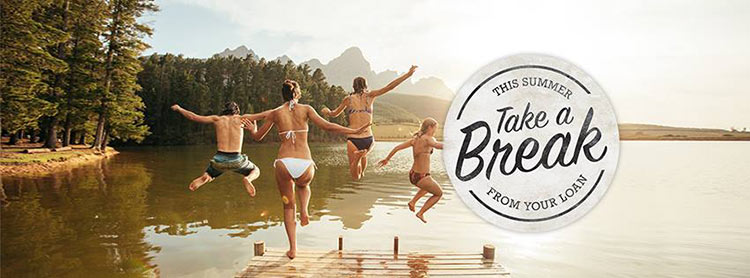
The campaign was titled “Take a Break” and Phase 1 launched at the end of May, alongside the opening of Whitefish Credit Union’s seventh branch. Memorial Day weekend is one of the strongest auto sales periods of the year – according to CBS News, in recent years seeing 1.5 – 1.6 million units sold nationwide, so it made sense to be talking about vehicle loans this time of year. The initial focus was on offering consumers no payments on new, used or refinanced auto or RV loans until September 1st. The campaign asked “What would you do with no payments all summer?” and utilized imagery and narrative to suggest road trips, vacations, relaxation, exploration and outdoor adventure (bike, hike, ride, etc). Elements of this campaign spanned traditional and digital media, starting with print, radio and digital display, later transitioning to television and highly targeted digital – including ad retargeting plus demographic-focused outlets like Pandora.
As the campaign moved into mid-summer, the perceived value of “no payments until September” decreased, so we introduced a cash-back incentive to the campaign in Phase 2. In addition to breathing new life into this campaign at the midpoint, it also allowed us to broaden its reach and appeal. The initial no-payments offer was mostly aimed at Millennials and younger Generation X households (or all of Generation Y, if you prefer the Harvard Center definition over Strauss and Howe). Adding this new incentive helped Take a Break gain appeal with Generation X and even younger Baby Boomers. In addition to the broad-reaching traditional and highly-targeted digital elements, a pair of direct mail pieces were sent to pre-qualified consumers encouraging them to think of Whitefish Credit Union when shopping for a vehicle, and to refinance existing auto and RV loans there, offering the cash-back incentive for each loan moved. For a consumer with, for example, a car loan with a $20,000 balance, a boat with $10,000 and RV with $30,000, this offer could put $600 in their pocket.
To further the campaign’s narrative in late summer, we shifted the focus to making the most of summer and the outdoors. Grid launched the Take a Break microsite to act as a landing page for digital and social campaigns. Lobby displays were created highlighting the giveaways and furthering the message that this campaign wanted to enable members to find their own adventures. Prize packages ranged from a pair of kayaks and mountain bikes, to the ultimate backyard BBQ setup, were on display across all of the Whitefish Credit Union branches, and were showcased in advertising. “Take a Break” could mean to take time to relax with friends in the comfort of your back yard, or taking an epic trip down the Middle Fork of the Flathead River.
In addition to the branch lobbies, Grid helped create a “Take a Break Lounge” at the Northwest Montana Fair & Rodeo – a place where members and non-members alike could get off their feet, charge their phones or tablets, and win cash and prizes. In addition to the seating and complimentary charging in the lounge, it also featured a screen playing a six minute brand video.

We can confidently say this campaign was a resounding success, with our client seeing unprecedented growth in the number of loans originated compared to previous years. This type of multi-channel, highly targeted marketing approach can be effective for most consumer products and services, if planned carefully, executed thoughtfully, and properly tracked. If you’d like information on how a campaign like this could promote your businesses products or services, get in touch!
by on Jul 29, 2016
At Grid, many of our clients are business to consumer – selling products either online or through brick and mortar retail stores. One of these clients, who sells outdoor adventure products, wanted to extend the reach of their sales network and marketing without having to commit to hiring multiple full-time sales associates to travel to every sales territory to drum up business “manually”. They turned to us to review their sales process, brainstorm ways they could extend their markets within their budget, and implement the campaign.
Affiliate marketing can be a very effective marketing strategy when implemented appropriately for the business. It works by partnering with individuals or other businesses who will market your product for you, in exchange for (typically) a commission on those sales (for more information about how affiliate marketing works, check out our knowledge article titled Putting Your Customers To Work, Affiliate and Loyalty Programs).
For this specific campaign, we began by determining what sort of sales increase we were aiming to achieve, and how we could best attain that within the budget available. Next, we worked closely with the client to define what the program would look like: who we would invite to participate, how sales would be tracked, how often the affiliate would be paid (including time frames and payment methods), and what sort of marketing materials would need to be created to support each affiliate. Although this part of the process took a little legwork upfront, by clearly spelling out each detail of the program we knew we were creating a process that would be efficient and scalable with very little ongoing involvement or costs on behalf of the client.
Our next step was to reach out to specific influencers within the outdoor product space, inviting them to become affiliates by reviewing or blogging about our products, or by offering our products for sale alongside their own in their retail or online stores. We provided trackable discount codes and URLs to specifically track every sale made a result of the affiliate’s own efforts. This is where the power of affiliate marketing comes to pay – a few good affiliates would be able to expand our clients reach into spheres of potential customer that we previous did not have access to, or would have cost a great deal in marketing to reach. Through affiliate marketing, we were able to build the reputation of our client and move products, all in one.
Another benefit that affiliate marketing can provide is the ability to better control your brand identity, or the overall look and feel of how your products are presented. When operating under a wholesale agreement with a traditional retailer, you have little to no say over the consumer’s buying experience. You can’t control how your product is displayed, where it’s located on the shelves, the packaging used to ship the product if it’s purchased online, or the level of follow up customer service, which can be a risk to your brand. For example, if your business touts sustainable practices, but then a wholesale partner ships your product in a box full of styrofoam peanuts or excessive amounts of packaging, this creates dissonance between the brand identity you are trying to promote versus what the customer is experiencing. On the other hand, when working with an affiliate partner, you are paying a very small amount to the affiliate for the benefit of driving the sale through your own business channels. This lets you handle the sale, order fulfillment, and overall customer experience, while off-loading some the lead generation to your affiliates.
Lastly, the percentage of profit you give up when offering commissions to an affiliate will typically be much smaller than the percentage you forgo as a result of a wholesale arrangement. A retailer or their distributor expects enough of a discount from you on your products to cover the overhead of housing your product until the sale is made, marketing your product, paying for their personnel to answer questions about your product, cost of processing the sale (including credit card transaction fees), the cost of fulfillment, and even costs relating to returning a product to you if necessary. Because of all of these additional costs, the profit you see as a result of a sale through a retail establishment will almost always be lower than the profit you see as a result of a sale through an affiliate.
As a direct result of the affiliate program we put in to place, our client saw a 20.7% increase in gross sales and a nearly 25% increase in the total number of orders placed.
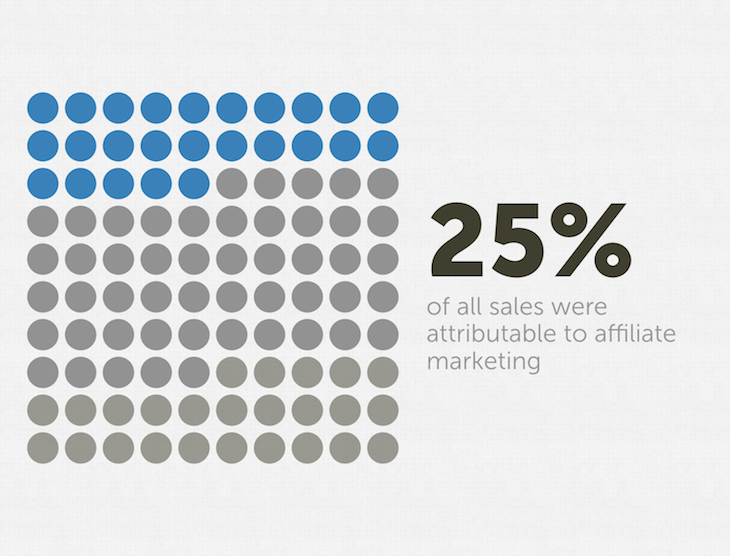
Thanks to the coupon codes and unique urls that we provided to each affiliate, we are able to track on a day to day basis the effectiveness of every affiliate and their efforts, giving us a wide variety of data (such as what regional markets our client’s products are doing well in, what marketing efforts done by affiliates are generating the most sales, synergistic complementary products or retail outlets, and where additional marketing budget may be allocated to improve sales with a specific demographic).
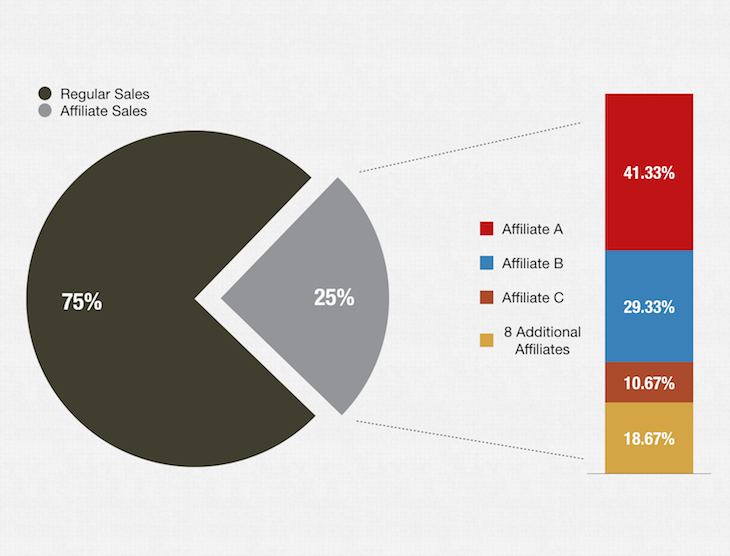
Our client, needless to say, has been very happy with the outcome of the affiliate marketing program and with the increase in returns it has brought to their bottom line. The program continues to run, and in fact has expanded to include almost a dozen unique affiliates include bloggers, online retailers, regional hobby organizations and podcasters.
Photo courtesy of Flazingo.com
by on Jun 26, 2016
Just shy of a hundred years ago, a New York radio station aired the first paid radio advertisement for a local apartment complex, and with that commercial radio was born. At first, radio advertising was limited to commercial businesses sponsoring individual programs, with the classic “this program has been made possible by” book-ending the beginning and ending of each individual show. As the industry grew, large radio stations began experimenting with different formats and eventually landed on the format we know today – with blocks of advertisements coming at regular intervals throughout the programming.
But the pervasiveness of the internet has sent the traditional radio industry into another wave of transition, as they are forced to compete with newer models like satellite radio (SiriusXM) and streaming radio (Pandora, Spotify). The ways that businesses are using radio as part of their marketing strategy are shifting just as quickly.
Terrestrial Radio
Despite newer satellite and streaming radio options, terrestrial radio (another term for your standard AM/FM in-car radio) is still the leading media platform when it comes to reach. According to the 2016 Nielsen Audio Today and Pew State of the News Media 2015, 93% of people listen to terrestrial radio over the airwaves (which is higher than TV viewership at 85%, smartphone use at 74%, computer use at 50%, and tablet use at 29%), and most consumers are listening to terrestrial radio for more than 12 hours per week. Radio’s reach spans from millennials (92% are reached weekly), to Generation X (95% reached weekly), to Boomers (94% reached weekly).
Advertising on terrestrial radio is still an incredibly effective marketing strategy, especially for businesses who are targeting demographics that include commuters heading into or leaving work, such as retail stores or restaurants.
Satellite Radio
SiriusXM, the largest satellite radio available today, was the first disruptive competition to terrestrial radio. They began offering an ad-free listening experience for a flat monthly fee as early as 2001. Despite some rocky years, satellite radio continued to grow in popularity, due in large part to their partnerships with automakers and car dealers. As of April 2016, SiriusXM boasts a subscriber base of more than 30 million listeners.
Despite marketing themselves as being an ad-free listening experience, SiriusXM does have opportunities for advertising through live reads by A-list talent, segment sponsorship, and some standard :30 and :60 second advertising spots on channels that are non-satellite exclusive channels, such as Fox News, CNN and ESPN channels. Although these advertising spots are much more expensive, their reach is often worth the cost for the right business.
Streaming Radio
Sometimes called internet or digital radio, streaming radio is a type of radio that involves using an internet connection to listen to a continuous stream of audio that typically cannot be paused or replayed, much like terrestrial radio. It took streaming radio several years to work through their monetization options, but most streaming radio stations now offer an advertising-supported stream for free and a premium ad-free experience for a small monthly fee. Although streaming radio lets people take their premium radio with them wherever they go, thanks to smartphones and (most recently) data-connected vehicles, there is still the limitation of data caps and connection speeds which has prevented the streaming radio segment from overtaking terrestrial and satellite radio options.
As of 2015, Nielsen reported that 67% of all music listeners access streaming services at least once in a typical week. Although the reach isn’t as large as terrestrial or satellite, streaming radio offers advertising opportunities that are much more targeted. With streaming radio, you can narrow your advertising down to your specific demographic, such as males aged 25-35 who have an interest in going to the movies. This type of targeting makes advertising on streaming radio an attractive and effective form of marketing.
The Process
If you’re ready to dive into the world of radio advertising (after, of course, discussing your strategy with your marketing agency), here is the typical process you will go through.
Radio advertising can be an incredibly effective marketing tool, but it has to go hand-in-hand with the rest of your marketing strategy. If your radio ad is driving listeners to your website, for example, but your website is not user-friendly, responsive or doesn’t contain the same type of language the listener just heard on your ad, you won’t see nearly the returns from your ad that you should. If you’re thinking that radio advertising might be the right next step for your business, we can help you plan and execute a campaign that is right for your needs.
by on May 30, 2016
Mention the word “marketing” and so many people are transported to the world of Mad Men, when print advertising ruled the world. Newspapers and magazines flourished throughout the 1900’s as they brought both fictional and non-fiction content to the masses. These publications became staples of every household, with readers eager to consume the contents of every new issue. Advances in print technology only strengthened the hold that print advertisements had over their viewers; high contrast, four color ads, trick photography and special effects all contributed to print advertising’s growing popularity and effectiveness.
But the all-pervasiveness of print advertising began to slip with the introduction of the television. With television, advertisers were no longer constrained to single images printed often weeks or months in advance. The message in advertisements could be updated, customized and targeted in ways that would not be possible in the print world. Advertisers, and their clients, quickly realized the improved benefits that television advertising brought, but remained committed to print thanks to the lower costs and previously demonstrated returns.
As the years have progressed, our world has continued to move into digital spaces leaving many to discuss what the role and importance of print advertising is in a modern marketing plan. Regardless of your stance on the future of print advertising, the reality is that print can still be (and IS) an effective and cost-efficient marketing strategy when used as one piece of an entire marketing plan.
Newspapers have had a rough time recently as publications grapple with how to maintain their print circulation numbers, while readers continue to flock to digital sources. In the past, a large percentage of the expense of producing a newspaper was covered by advertising revenue. But the amount that a newspaper could charge for advertising space was a reflection of their circulation numbers. More readers meant the ad space was worth a higher price. However, as circulation numbers have decreased, newspapers have had to reduce the cost of the ad spaces, opening the door for a more diverse range of businesses to advertise. Although print ads may reach less readers than they have in the past, the lower ad space rates mean more businesses have the opportunity to advertise for longer periods of time than they did before.
Magazines have seen a decline in readership but at a much slower rate than seen by newspapers. Whereas newspapers cover a little of everything to try to cater to as wide an audience as possible (think the sports section, entertainment section, etc), magazines by nature are already narrowed in to a specific demographic, like knitters, hunters or tech enthusiasts. More engaged readers are going to be less inclined to move away from their previous sources of content than readers who do not feel engaged – leading to a slower decrease in readership among magazines as compared to newspapers. The advantage to placing a print advertisement in a magazine remains the fact that you can find a niche magazine that caters to any and every demographic, giving your ad the most potential to convert a reader into a customer.
While the future of print advertising may seem pretty clear, the current state of print publications means there are still ample opportunities for successful marketing. For example, many publications now offer both print and digital solutions, giving you ad space in both versions for a fraction of what the same kind of coverage may have cost you five or 10 years ago. The key to print advertisement success is to be thoughtful about your publication choice, ad size, messaging, and frequency, while considering what role your print advertisement plays in your overall marketing strategy.
Whether you’re looking to step in to print advertising for the first time, or have been running print ads with no real direction or return, Grid can help!
by on May 30, 2016
Outdoor advertising, also known as out-of-home advertising, is any form of advertising that primarily reaches the audience while they are outside of the home, and often relies on the fact that the audience is in transit to another place. Almost every demographic (gender, age, marital status, education, income level, etc) leaves the house at least once per day, and outdoor advertising relies on this regularity to bring their message to the right demographic at the right point in time. As reported by Arbitron in their 2013 Out-of-Home Advertising Study, the average time spent in transit is over 20 hours per week – that’s almost three hours per day that people are reachable by various forms of outdoor advertising.
Just how effective is outdoor advertising? We’ll let the statistics speak for themselves (all below statistics are from the Arbitron 2009 National In-Car Study):
Although building signage is not the first thing that may come to your mind when we talk about outdoor advertising, it is one of the most influential and important types of outdoor marketing available to your business. Building signage is what gives your location, presence, and placement to someone as they are driving by or as they are trying to find you. Your signage should be big, bright and clear to street viewers, day or night, coming from either direction. Other building signage to consider are parking signs, entrance or exit signs, your office hours on the door, or any special directional placards noting how to reach your main entrance.
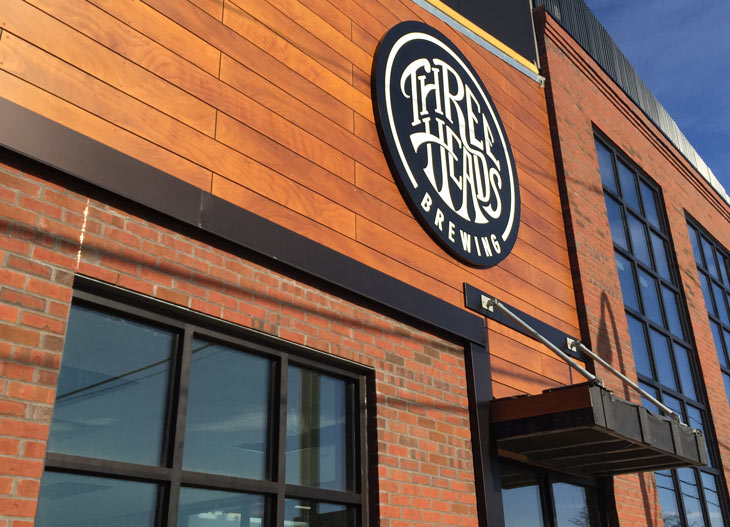
Corporate vehicles can be large mobile advertisements used to keep your business top of mind. The best types of vehicles to advertise on are vans or work trucks, but any vehicle with space on the doors or back windshield can work. When designing for a vehicle wrap or vinyl, it’s important to remember that your vehicle will most often be viewed while moving, so keep your messaging and contact information large, clear and uncomplicated. Other drivers won’t have much time to make heads or tails of your graphics, so make it as easy to read as possible.
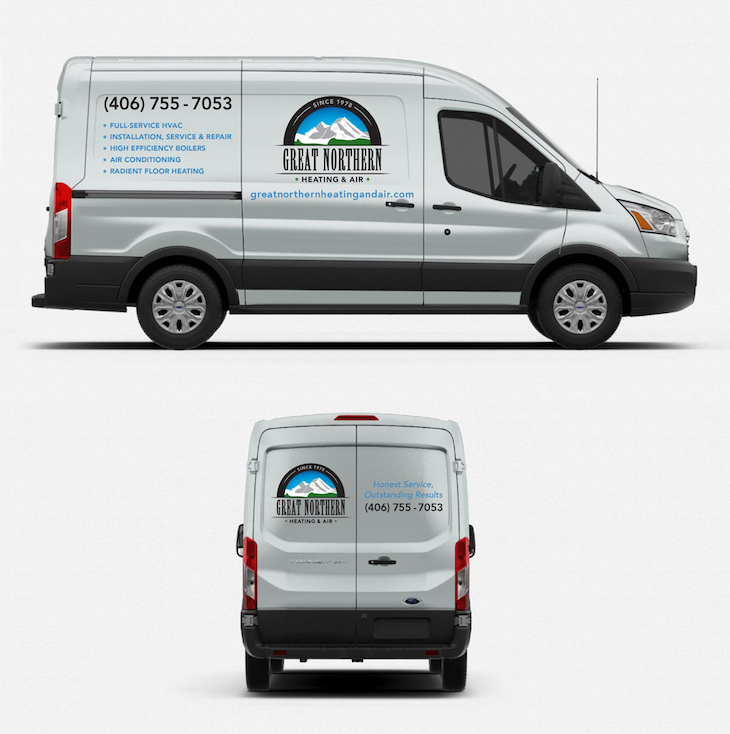
Billboards are the most classic, and most historic, form of outdoor advertising available. According to the Outdoor Advertising Association of America, the first billboards were large format circus posters used in 1835 (followed soon after in 1850 by posting advertisements on street railways). Billboards in a given area are typically owned by one company and are then rented on short term contracts, about two to three months at a time. The cost of a contract varies widely depending on the quantity of billboards, rental length, and the location of the billboards themselves. A good rule of thumb is to estimate about $1,500 per month per billboard in a medium-sized marketplace. Due to their higher cost, billboards should be used as one part of a larger marketing campaign in order to see the most return.
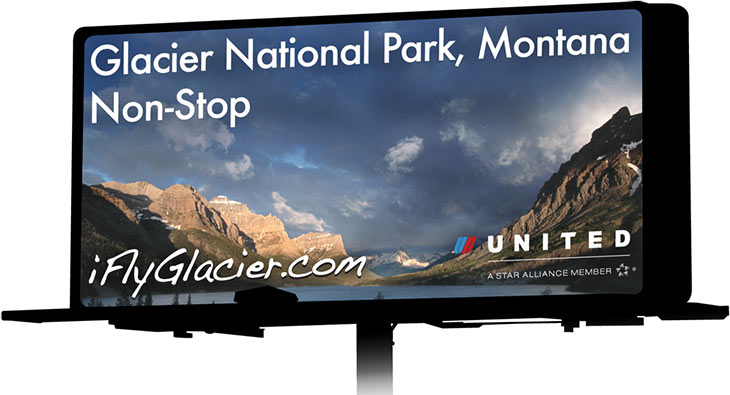
There are a wide variety of additional types of outdoor advertising, which can vary depending on your location. Other examples include:
There are a lot of things to keep in mind when you are incorporating outdoor advertising in to your marketing plan, from a logistics, design, and regulations standpoint.
Outdoor advertising of any type can be difficult to plan and execute properly, whether that’s due to the cost, the size, the contract commitments, the design or the regulations. However, it can be an extremely effective type of marketing when used as one part of your overall marketing plan. If you’re considering how outdoor advertising could perform for your business, reach out to us. Our previous outdoor advertising experience can help you get the most out of your efforts!
Photo courtesy of flickr user Metropolitan Transportation Authority of the State of New York
by on May 30, 2016
Glacier Park International Airport (GPIA) offers convenient access to destinations throughout Northwest Montana, including the “crown jewel of the continent,” Glacier National Park. It also links residents of the area to both major U.S. hubs and international destinations. When we began working with them, the airport had recently started providing Montanans with non-stop flights to several new airports throughout the United States. However, GPIA had historically suffered from a perception issue with local travelers, many of whom felt the airport had few non-stop flights to popular locations. Often, they would travel as far as Missoula for air travel (more than a two hour car ride from Kalispell), also believing flights there to be cheaper, or with less layovers. GPIA also wanted to advertise to travelers in other major markets looking to travel to Northwest Montana. Again, many of these travelers were flying in to the area via Missoula, or even as far away as Spokane, to reach Glacier National Park and other recreational opportunities in the state.
We began working with GPIA in 2005 to promote their offerings in other markets, and in 2007, launched a campaign to help correct these perception issues and increase both local usage and destination tourism from outside the region.
We began by partnering with United Airlines on a co-op campaign between themselves and the Montana Travel & Tourism Board (MTTB). United was offering non-stop service between GPIA and major American cities, such as Denver and Chicago. MTTB wanted to encourage more tourism in Northwest Montana, which at the time, was the state’s second highest source of revenue. Working with the MTTB, we designed billboards, which appeared in both Chicago and Denver, notifying viewers of these available flights. Understanding your audience is a key component of an effective advertising campaign. During our research, we uncovered the fact that parts of Denver suffer from major traffic jams on the highways and frustratingly long lift lines during ski season. Using this information, our Denver-based outdoor advertisements during the winter promoted Northwest Montana’s excellent skiing and easy mountain access. When summer came, we switched the messaging to promote travel to Glacier National Park. We also extensively researched the placements of these billboards in destination cities to achieve the greatest number of views. For example, we found a highly trafficked stretch of highway between Chicago and O’Hare International Airport, where we placed one of our billboards. It read “Glacier National Park, Non-Stop” and featured stunning images of the National Park.

We also used outdoor advertising to help spread the message of GPIA’s many available non-stop flights. In between the skiing and summer seasons, many local travelers believed the off-season had very little in the way of non-stop air travel from GPIA. In reality, these flights were actually readily available throughout the year. To reach local Montanans and help correct this misperception, we designed billboard artwork showing several of the non-stop destinations serviced by GPIA. The ads were simple, yet compelling, imploring viewers to seek out new experiences in these locations. The messaging encouraged them to visit a museum in Chicago or catch a major league baseball game in Denver, each city, of course, being a non-stop flight from GPIA.
In addition to these campaigns, we also worked alongside major airlines like Allegiant, Sky West and United, to announce and promote their new flight destinations from GPIA. To date, most flights are now booked to capacity and the airport has seen an expansion of major cities served – an impressive feat in an otherwise consolidating and shrinking travel market.
by on Apr 26, 2016
Whitefish Credit Union, the largest credit union in Montana, takes pride in the amount of financial education they provide to their members, especially to younger audiences who may be just starting to form a relationship with a financial institution. We worked with the credit union to roll out their new School Spirit Visa® Debit Cards - a series of debit cards that feature the logo of each of the eight high schools in their membership area. This product was a great way to introduce their younger members to the cooperative’s fiscally conservative message, capture nostalgia for parents and grandparents of students and recent graduates, and take advantage of some hometown high school rivalries!
Grid built an extensive marketing campaign around the new debit cards, including print and digital ads, lobby / retail displays with life-size student standees, and geo-targeted social media advertising (including Pandora Radio). All of these marketing pieces featured actual athletes from the many different high schools - a level of authenticity that is needed to resonate with the credit union’s small-town demographics, especially the students themselves. This also meant no stock footage, photography or hired talent when it came to print or television advertising. In towns where local high school athletes can be as well-known as the pros, an unfamiliar face would have stuck out and devalued the entire campaign. It was important that every “actor” and “model” be an actual high school athlete from their local schools.
Right from the start we knew the most difficult part of our work was going to be arranging the logistics for the photo and video shoots for the campaign. Our first step was to build relationships at each of the eight high schools, so we had access to decision makers and the right movers and shakers that could get us the access we needed. Working through their principals’ offices and athletic directors also meant that obtaining the students’ parents’ permission to participate would be easier. Then, we arranged video and photo shoots of each high school’s soccer, volleyball, cheerleading, golf, cross country and football teams, with athletes in full game-day uniforms. For the last steps of the shoot, our film crew attended a number of the sports games to collect candid shots of the students in action. The result was a collection of authentic (but professional) photos and videos that could be used throughout the entire campaign.
Technology plays a large role in any film or photo shoot - but not just on set. From our previous experience, we anticipated that the collection and proper storage of film release waivers for so many students could be a cumbersome task. In preparation, we created digital versions of the waivers that could be signed off via an iPad made available on set to keep the process as streamlined as possible. This bit of upfront preparation saved time and budget down the line by ensuring that our client would not have to try to back-collect releases.
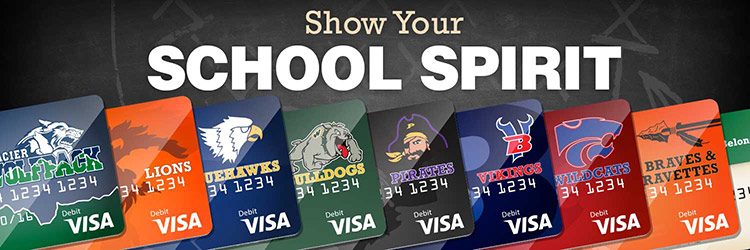
What made this shoot even more impressive from a planning and logistics standpoint is that almost all of it happened nearly a year before the launch of the product. In addition to planning ahead, Grid was able to save Whitefish Credit Union a considerable amount by working these shoots in while also filming a live-action TV spot for another one of their products. Although this meant Grid was juggling a lot of logistics at once, it also meant we were able to cut the client’s video production costs nearly 40 percent.
After shoot, it was a matter of post-production: editing, color grading, music scoring and sound mixing. We were able to use the footage to produce not just the originally planned 30-second spot, but two 15-second spots, YouTube pre-roll ads, and a social media video post.
by on Apr 25, 2016
There’s a buzz of excitement, an almost electric atmosphere, when you’re on a video shoot. It can feel magical when you get a great take, for the people in front of as well as behind the lens. It’s even more thrilling to see that work on television, or to see the view counts rise for people watching it online. But there’s a lot of work that goes into preparing for, shooting and producing a commercial or web video than just “lights, camera, action.”
For weeks (or sometimes even months) before a single frame or pixel is shot, we’re flexing our creative muscles in another way – brainstorming the message we want to convey, writing the script, and drawing up storyboards to visualize our idea. Next, is tackling the logistics – determining where we will film, planning travel, lining up equipment needs, filing for permits, planning access to the location, arranging for power to be available on-site, etc. On a recent shoot in a National Park, we had to submit a lengthy permit request that covered our shoot in detail, including what the extent of our pyrotechnics would be (none), and what our mitigation strategy was for the environmental impact of landing a helicopter on-site (we weren’t). Clearly they thought our shoot was going to be much cooler than it was!
Even if you aren’t filming an explosion-filled cinematic masterpiece, spending the appropriate time on the up front planning and logistics pays off in the form of a better organized shoot. Streamlining your shoot can mean more time available for filming different angles or grabbing more B-roll – all things that can add extra depth to your video.
But the creative process certainly doesn’t stop once you hear “cut!” Footage is first logged, which means someone re-watches all of the footage that was shot and takes notes about the content of each take. The editors then work with the best pieces of footage to construct the appropriate scenes and stories. In some cases, voiceover is recorded and music is mixed. Some projects need to add titles, animations, or composite elements like motion graphics onto a phone or computer screen (screen glare or difference in contrast sometimes makes it difficult to capture the actual screen image), or perform color grading (enhancing the color, also called “color timing”) to enhance the mood and support the story.
The last step is prepping and exporting the video for broadcast or upload. Every television station, cinema, website (Hulu, Vimeo, YouTube, etc), and social network has different file requirements, such as file format, pixel size or audio bitrate. Preparing the files correctly for each intended use makes a difference in the perceived quality by the viewers.
Not every video we plan, shoot and produce is intended to be a television commercial. As online content has shifted and evolved, video shot specifically for viewing via the web or on smartphones has rapidly grown to represent a significant portion of our production work. Online video content can range from your standard advertisements, such as those shown before a YouTube clip or during your Hulu video, to full length web-based shows. Video content has been shown to be more likely to drive engagement on a website versus text alone. According to Forrester Research it is 50x easier to achieve a page 1 ranking on Google with a video. In another study by Forbes, more than three quarters of senior executives said they watch work-related videos at least once per week, and 59% said they would rather watch a video than read text. Videos often translate into viewers taking action, whether that’s visiting a website, contacting a company, or making a purchase. If, as the saying goes, “a picture is worth a thousand words,” it may be more beneficial to present your information by video rather than by text.
When we approach a project, we keep in mind the myriad of different ways video content can be consumed in today’s marketplace. By doing so, we are able to plan for, film, and edit together various versions of a single spot that are the appropriate length for different media outlets. This could mean producing a 1-2 minute long video for a company website, a 30-second commercial version for television, and a 10-second version for a YouTube pre-roll video. The small amount of additional work needed to plan for these variations in advance is far less than trying to do several pieces stand-alone, and ultimately gives our clients more content for their money – and much further market reach.
You would be surprised at how affordable it is to produce excellent quality, engaging video content, especially with the web as a distribution platform. With the right amount of planning, we can help you produce videos that keep your product or company’s message fresh and relevant.
by on Apr 21, 2016
Presentation; just the word can strike fear into the heart of even the most experienced professional. While there are many reasons to dislike giving presentations, such as anxiety over public speaking or concern that technology may leave you hanging, adequate preparation may be the saving grace to get you through. Whether you’re a battle-hardened presentation pro or a nervous newcomer, having a professionally created presentation deck at your finger tips can make the entire experience less stressful for you and more engaging for your audience.
A presentation deck is a set of pre-designed presentation slides built into a single file, most commonly in Apple Keynote or Microsoft PowerPoint software. These slides represent a wide variety of different ways you might present information for the purposes of a presentation, such as one column of text, two columns of text, a pie chart, or a bar graph. The goal of having pre-designed slides in a deck is to save you time when it comes to putting together an actual presentation. Instead of having to worry about how you are going to style a table or a bar graph, you just have to enter your content into a slide that has already been created for you. It also helps ensure your presentation stays on brand, and looks as polished as possible.
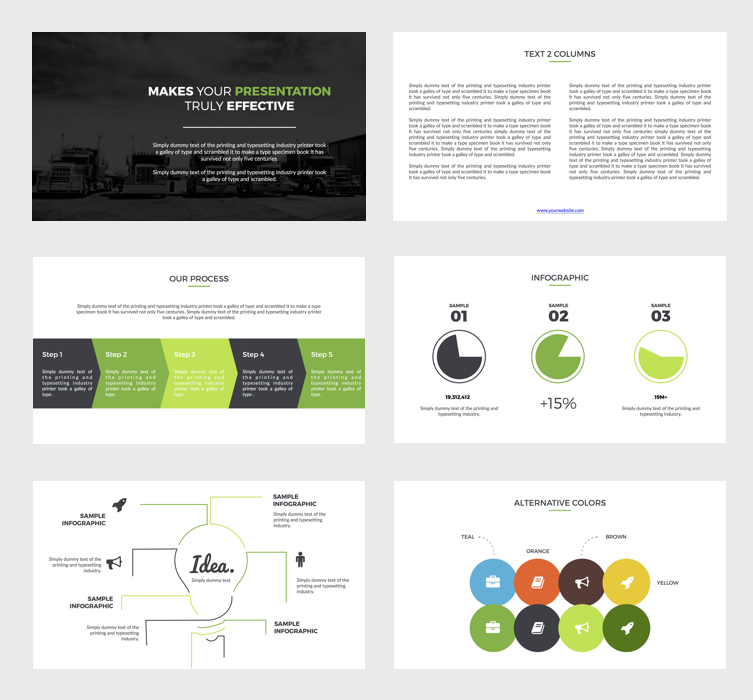
A presentation deck should include any type of slide that you foresee yourself using in the future. Although far from a complete list, here are the most common types of slides that we include in every one of our presentation decks:
Although a well-defined presentation deck can be a hundred slides or more, your deck should be customized to the specific types of presentations and content that are unique to you or your business. If your deck only needs ten different slides, don’t feel forced into creating more for the sake of quantity.
Through preparing presentation decks for a number of clients, we have discovered a broad range of uses for a presentation deck that you might not think of right off the bat! Our clients have used their presentation decks for printing marketing booklets for potential clients, putting together looping video content for displays in their trade show booths, making unique content available for download on their website, preparing digital versions of their press kits, and creating training documentation.
The first step to designing a presentation deck is to evaluate your previous and/or upcoming presentation needs. Every presenter (and thusly, every presentation) is unique, so your presentation deck should be set up in a fashion that best suits the needs of your content and your presentation style. Are you the type of presenter that likes to include video or audio files? Do you typically showcase tables of data? Or are your slides primarily text based? By evaluating the most common types of content that you include in presentations, you’ll have a better idea of the types of slides to include in your deck.
Next, think about the types of people you will be presenting to. Are your audiences typically executives or upper management? Are they potential investors? Current customers? Your demographic should play a big role in the way you decide to present your information. An older demographic may need a larger font size, while management may want to see more tables of facts and figures. Remember that the visual portion of your presentation should be a compliment to the verbal, and should thus cater to the people in attendance.
With all of the above in mind, it’s time to start designing your actual slides. The most important thing to remember during this step is that the design of your slides should be consistent and on brand. The green you use on slide one should be the same as the green on slide nine. If your photos have square corners, don’t switch to rounded halfway through the deck. Ideally, use a font that is specific in your brand style guide (you have a brand style guide, right?), or choose one that compliments your brand. You can also choose to partner with a professional agency, like Grid, to handle designing these slides for you. This is often the most cost and time efficient way of preparing your presentation deck.
You’ve finished preparing your presentation deck just in time to be asked to present at your next networking event – fortunate timing! So how do you use this presentation deck to save yourself some time and hassle? The first step in preparing any presentation (with or without a deck) is to outline the topics that you want to talk about. Once you have that outline established, scroll through your presentation deck looking for the types of slides that would most likely compliment the topics you plan to cover. Don’t hesitate to select two or three possible options – you can always narrow them down to one slide as you finalize the content of your presentation. Assemble a new presentation file that uses copies of your slide selections – in most software it’s as easy as using copy and paste from your presentation deck into a new presentation file. Continue working on your presentation, using your new presentation file as a guideline. You may find that you are able to more quickly flesh out the contents of your presentation, because you aren’t distracted by trying to design each slide at the same time!
Preparing a presentation deck can seem like an overwhelming task at first. But, as is the case with all marketing, time spent in preparation is time saved in execution. Preparing a deck can not only help cut down the time, effort and stress that come with putting together a presentation, but it can also help save time on future marketing efforts, like your trade show display or printed marketing collateral. Every presentation you give is a window into who your company is – make sure you’re portraying yourself professionally, consistently, and on brand.
Photo courtesy of flickr user Mike Deerkoski.
by on Mar 23, 2016
Take a look around your office. Chances are you’ve got at least one promotional product hanging around – a pen, mug, mousepad or hat imprinted with another company’s logo. You may have gotten it at a networking event, trade show, in the mail or when a representative from the company stopped in. Promotional products have long been a way to keep a business top-of-mind with potential or current customers (the earliest US accounts of which date all the way back to George Washington’s 1789 election), but just as with all marketing efforts there is a bad, good and best way to make promotional products work for your company.
The bad way always starts with the best intentions. You’re the owner of an accounting firm, who has been trying to increase your corporate clients. You’ve gone to a few networking events and see other businesses like that big name bank or the chain oil change shop handing out pens and keychains to everyone they talk to – sometimes two or three at a time. Well, you certainly don’t want to stand out from these guys, so you decide it’s time to get some promotional products for your business.
You hop online to find the cheapest per-piece product you can. You find a place where you can get plastic luggage tags for a fraction of the cost of anything else. Your brand colors are red and gold, but you choose the green luggage tags because it’s the cheapest color option available. They offer to imprint your logo onto the tags, but that’s an extra setup fee so instead you ask them to just type your business name across the tag instead. You’ve decided to order five hundred tags, but decline to have a sample mailed to you for review before they do the entire run.
You place your order and wait several weeks for the final product to arrive. When you finally get a look at how they turned out, you realize they’re a lot smaller than you expected, and the plastic is really flimsy. Would this even stand up to the abuse luggage can go through at an airport? Regardless of your worries, you grab handfuls of them and take them with you to your next networking event, eager to join the club of having free stuff to give out. You’re handing luggage tags out to anyone and everyone – your coffee barista, your mail carrier, you drop a few off at your parents house, you put them out at the reception desk for people to grab as they come in or out. You know for sure that next month’s sales are going to be through the roof.
At this point in our narrative we’ve thrown up a number of red flags that make this situation “the bad”. Did you catch any? Let’s review:
Now that you’ve seen the red flags, let’s retell our same narrative the “good way”.
You’re the owner of an accounting firm, who has been trying to increase your corporate clients. You’ve gone to a few networking events and see other businesses like that big name bank or the chain oil change shop handing out pens and keychains to everyone they talk to – sometimes two or three at a time. Well, you certainly don’t want to stand out from these guys, so you decide it’s time to get some promotional products for your business.
You hop online to find a promotional product that people might actually find useful. You find a place where you can get branded coasters for a reasonable cost. Your brand colors are red and gold, so you choose the red coasters with a white imprint of your logo to match your brand as closely as possible. You’ve decided to order 250 coasters, but decline to have a sample mailed to you for review before they do the entire run.
You place your order and wait several weeks for the final product to arrive. When you finally get a look at how they turned out, you realize they’re a lot thinner than you expected, and the red is more of a maroon than it looked on the screen. You grab handfuls of them and take them with you to your next networking event. As you talk with people who seem interested in the services you provide, you give them your business card, a brochure about your services, and a coaster for them to take back to their office. “Sit back and enjoy that cup of coffee knowing your corporate taxes are being handled properly,” you say with a smile. You know for sure that next month’s sales are going to be through the roof.
How did we do this time around? Definitely getting better! This time we chose a product that might actually be useful for our specific demographic, and we did our best to brand it to our company colors. The color may not have been a perfect match (we should have asked for a sample!), but it’s the closest we could have come with the options available. We’re pre-qualifying people before we give them a coaster, and we’re making sure to pair the coaster with a clever slogan and a piece of marketing collateral that they can use to learn more about our services.
Let’s do this once more, but this time making all of the best decisions we can for our situation.
You’re the owner of an accounting firm, who has been trying to increase your corporate clients. You’ve gone to a few networking events and see other businesses like that big name bank or the chain oil change shop handing out pens and keychains to everyone they talk to – sometimes two or three at a time. Well, you want to make sure the people you give promotional items out to remember who you are, and won’t just throw your product away the next time they come across a trash can.
You hop online to find a promotional product that would most appeal to your target demographics. You find a place where you can get branded calculators for a reasonable cost. It’s definitely more expensive per piece, but you know that you’ll only be giving these to people who are in a decision making role, and they are worth the cost for that sort of good will. Your brand colors are red and gold, so you make sure to choose the gold backing plate instead of the silver or black. You also spring the extra setup fee to have your logo and the slogan “Working with us just makes cents” engraved onto the backing plate. You’ve decided to order 100 calculators, but reach out to the company first to request a sample. When it arrives, you approve of the quality and durability, meaning you feel comfortable about the product you’ve chosen.
You place your order and wait several weeks for the final product to arrive. They look great, but of course you knew they would! You don’t take any of them with you to your next networking event. You talk with people who seem interested in the services you provide, and invite them in to your office to meet your staff and see how you operate as a team. At your meeting, you offer them a calculator as a thank you for stopping in. You also offer to add them to your email list to get timely reminders about upcoming tax deadlines, which they eagerly agree to. Your next monthly email campaign goes out, and when it arrives in that potential customer’s email inbox, they remember how great it was seeing your office, and what a nice gesture that calculator was. In fact, it’s sitting right next to their keyboard for those quick calculations! You know for sure that next month’s sales are going to be through the roof.
Promotional products, like all marketing efforts, come down to finding the right solution for your specific business or marketing goals and your target demographics. If you’re interested in finding out more about how promotional products could work for your company, reach out! We’d be happy to work with you to evaluate your situation and make the best recommendations.
by on Mar 18, 2016
Trade shows (also called trade fairs, exhibitions or just expos) are organized events where companies within a specific industry show off their products and services, and meet with current or potential customers. Although attending a trade show can be beneficial for finding new vendors or building partnerships, exhibiting at a show (when done right) can be a huge opportunity for your company to build brand awareness, generate leads, and get all-important face-to-face time with potential customers, all at the same time.
Attending a trade show is a no-brainer for your sales team members. By choosing to exhibit at trade shows that cater to your target demographics, your sales team gets to work directly with large numbers of pre-qualified visitors, meaning your sales people can do what they do best – generate leads. The one-on-one nature of a trade show lets your team members have more meaningful interactions with potential customers, leading to a more memorable experience (which has a higher likelihood of converting to a sale).
Trade shows also give direct access to a greater number of decision makers. A recent survey done by Exhibit Surveys, Inc. shows that 67% of trade show attendees represent a new potential customer for exhibiting companies – meaning they have a problem to solve and are looking for someone to help them solve it. In another study done by the Center for Exhibition Industry Research, 46% of trade show attendees are in executive or upper management roles, giving them the power to make decisions right there on the spot.
Let’s not forget about current customers. Trade shows give your sales team opportunities to advance the sales cycle with customers who may have been on the fence about signing with you, or even upsell to existing clients who stop in to say “hello”.
Your marketing team should be all thumbs-up about attending trade shows. They are the perfect opportunity to manage the perception of your brand and build its credibility, or to introduce brand re-positioning to a large number of people at the same time. They can also give you a way to humanize your brand, by letting potential or current customers meet face to face with the people behind the scenes, ask questions, and generally learn more about what makes you the company you are.
Don’t underestimate the level of access that a trade show gives your marketing team to solicit feedback and opinions from potential or current customers. You can use them as an opportunity to learn about objections to your products or services, identify weaknesses in your messaging, or to generally gauge the public perception of your brand.
If news or publicity about your company has been slow, attending a trade show also gives you another reason to reach out to media to reinvigorate interest in your company.
Many companies use trade shows as a way to introduce new products into the marketplace to capitalize on the press and buzz that inherently surrounds the show itself. They can give your product team the opportunity to demonstrate your new product directly with potential buyers, answer questions, and even solicit feedback for future iterations.
Your product team can also use trade shows as a way to research your competitors latest products, services, and messaging, using them as a way to improve the work they are doing “back in the office”.
From a ten thousand foot view, trade shows give your management team a way to assess the current state of the industry, including identifying emerging trends or new demographics that may be entering the marketplace. They can see if your company is keeping pace with competitors, or if you are starting to fall behind in terms of innovation or positioning. They also give members of the management team a way to identify other businesses that may be beneficial from a partnership or alliance standpoint.
You’ve decided to make the leap and attend a trade show this year. Great! Now what?
Exhibiting at a trade show is a big deal for your company, and should be treated as such. Team up with an experienced marketing agency that understands the intricacies of trade shows and the associated marketing – one that can produce a consistent booth experience, and help with your post show promotions.
Part of selecting your professionals is identifying the right staff members to man your booth. You want to select people who are interested in participating, are approachable and comfortable speaking with potential clients, and who have a good understanding of the product or service you are offering.
If you’ve attended any sort of trade show before, spend time evaluating your previous goals and making realistic assessments about your level of success. Who did you target? How many people did you have visit your booth? Were your collateral pieces successful, or did you find them littered on the floor at the end of the event? Use any previous information you have to set new objectives for your upcoming show, being sure to keep your business goals and marketing plan in mind. How will you measure these objectives? How will you determine if your attendance was successful?
In a best case scenario you’ve already sat down and devised a budget for your trade shows for this year, so this step should be an easy one to cross off. If, however, you have neglected to answer this question in advance, now is the time to give it some serious thought. Your trade show budget should be based on a number of factors including the size of the show you are attending, your current financial situation, your objectives for the trade show, and what sort of collateral you’ll need to help you reach your objectives. Don’t forget to consider the costs for travel and lodging for shows outside your regional area, staffing costs, print collateral, pre and post show promotions, and any items you plan on giving away.
The most important step in attending a trade show is to choose the right trade show to attend. Think back to your target demographics and choose events that they would be most likely to attend. If your target demographic is sports-loving men, a booth at the annual Diamond and Gemstone Expo would probably be a miss. Be willing to adjust your trade show plan every year; if you haven’t seen good results in previous years at the same trade show, consider branching out.
Now that you know who you’re talking to (the attendees of the trade show you’ve chosen), what are you going to say? Your messaging may make or break your overall trade show experience, so spend the time to get it just right. Remember your visitors will probably spend only a few minutes at your booth – what is the major takeaway you want them to have? Is it about your company’s history and values? Is it that you have the coolest new tech in the marketplace? Is it that your products are made in America? Limit your messaging to one important takeaway, and make sure all of your talking points support that message.
If you have a previous display, does its design and setup support your new objectives? If not, change it up. If you don’t have a display, work with your professionals to design and produce a display that focuses on bringing your selected messaging to the demographics at the show. Make sure your display reflects who you are as a brand, is visually appealing and welcoming, and provides room for your team members to interact with visitors.
Well in advance of the show, reach out to your current and potential customers and let them know you will be in attendance. Invite them to join you for refreshments, a giveaway, or to learn more about the products and services you offer. Decide when and how you plan to follow up with your booth visitors so you have a plan in place for collecting their contact information.
Finally, train your staff on all parts of the trade show experience, including how to assemble and disassemble your display (if necessary). It’s great to give them a heads up about what other competitors may be in attendance or what business will be on their sides or across the aisle, to prepare them before they arrive. Simulate scenarios where your booth visitors have already talked with competitors, or have objections to your messaging. Make sure your team understands the main messaging takeaway that you’ve defined.
We’ve all seen some bad trade show setups, or had bad experiences in trying to interact with specific businesses on the expo floor. Here are some of the most common trade show mistakes:
Exhibiting at a trade show can be a major investment, but when done right can also provide incredible returns. A professional, engaging booth can do everything from promoting your overall brand and raising awareness about your products and services, to generating leads and even closing sales right there on the spot. If you’re ready to make the investment, we’re ready to help!
by on Feb 24, 2016
Business collateral is an, admittedly, fairly vague term used to reference a wide variety of printed or digital pieces of marketing material, and is often referred to by similar names such as marketing collateral, sales collateral, brand collateral or identity collateral. The one consistency between these names is the term “collateral” (meaning ancillary or accompanying), which is important because it drives home that these marketing pieces are not meant to stand on their own, isolated from the rest of your business processes or other marketing efforts. They are individual pieces that may build a brand, introduce a product, explain a service, strengthen credibility, or guide a decision, but can’t (and shouldn’t) try to do it all at once.
Although by no means complete, here are the most common types of business collateral seen in today’s marketing landscape. In addition to this list, some industries have their own unique types of business collateral, such as deposit or withdrawal slips for a financial institution, estimate forms for a landscaper, or restaurant menus.
When you’re ready to introduce business collateral into your business, sales or marketing processes, remember that not every piece of collateral is created equally or is appropriate for the same purpose. You should never produce a piece of collateral because “everyone else has one”. Every piece of collateral should have a clearly defined purpose (extra points if this purpose is spelled out in your marketing strategy), whose format and content is chosen specifically to support that purpose. For example, you may find that you make a great connection with potential customers when face-to-face at a business networking event, but struggle to get people to contact you down the line. Start by evaluating your business card design (you are handing out business cards, right?), then move into considering a piece of easy to hand out collateral, such as a tri-fold brochure or postcard. Your contact information should be featured prominently, along with a strong call to action that tells the reader why they should reach out to you now or in the future. This simple piece of collateral could be the bridge between your initial connection with a person and thinking of you when they have need of your products or services in the future.
Business collateral can serve a variety of purposes, but some of the most common reasons include:
Just as every business is unique, so, too, is every piece of business collateral, and this uniqueness makes it impossible to define exactly what makes a piece of collateral successful. There are, however, some common elements that will contribute to the overall success of your own collateral. Successful business collateral should be:
It’s easy to produce business collateral – it’s difficult to produce it right. If you want to introduce the right business collateral into your business, sales or marketing processes, or if it’s time to rethink collateral you already have, let us help steer you in the right direction!
by on Feb 18, 2016
“If you build it, they will come” makes for a great movie catch phrase, but it’s horrible business advice. Something more close to the truth would be, “If a tree falls in the forest and there’s no one to hear it, does it make a sound?” No matter how innovative, game changing, well priced or flashy your new business (or product or service for an existing business) is, if no one hears about it, you’re sunk before you’ve started.
A launch plan is often overlooked, especially in today’s digital age where business owners love to believe that word of mouth, referrals and “going viral” will be their main avenues of driving awareness. If this were true, companies far larger (such as Apple, Microsoft and Google) wouldn’t be spending money on advertising at all; they would be able to rely on their name and brand reputation alone to drive all of their sales. Instead, what you find with these companies are hyped up launch events that make people want their new product, followed by persistent and engaging marketing campaigns that run before the product has even hit the shelf. These companies are proof that having a solid launch plan in place can make or break the viability of a new business, product or service.
So what goes into a launch plan? Do they all include gala events, press conferences, and presentations at the largest business conferences on the planet? For the big guys the answer is yes, because their demographics are world wide. But for those playing on the local, regional, or national level, a successful launch plan all comes down to knowing your demographics, defining your message, communicating through the appropriate channels, and, most importantly, following through.
When planning for a launch of any kind, there are at least three target demographics that you need to consider. The first, and most obvious, are your potential customers. You should be able to define their gender, age range, income level, communication preferences, and any other personal information that may play a role in their decision to purchase from you. For example, if you are an auto repair shop who is adding detailing to your list of services, your potential customers should own at least one car.
The second demographic are your current customers. Even if you’re launching a new business chances are you’ve offered your product or service to someone in the past. What do your customers look like? Again, think in terms of gender, age, income level, communication preferences, and any other factors that may relate to your specific industry. Make sure to consider how your current customer demographic compares to your potential customer demographic that you just defined. If there are major differences between the two, spend time to honestly evaluate why who you think you are going to be selling to is different from who you are currently selling to. If you can’t easily explain why your two demographics are different, you may want to re-evaluate how you’ve defined either or both of those demographics.
The third demographic to be considered is the press. Ideally, you should select two to four publications (print, television or radio) that reach a demographic that closely matches your potential customer demographic. Identify reporters, writers, bloggers, or radio personalities that might be interested in what your launching, and keep them in mind as you work on the next stage, defining your messaging.
Why should people care about what you’re launching? If you can’t easily answer that for yourself there’s no way you’re going to be able to accurately convey it to each of your target demographics. As part of your launch plan you need to define exactly what your business, product, or service is, and why people should care.
To start this process, evaluate your competitors and their messaging. What values are they selling their business on? Are they selling on price, customer service, something else? What objections are they facing (Facebook, Twitter and Yelp are great spaces for this research), and how are they overcoming those objections? Will you face similar objections, and how do you plan to respond?
Be realistic about how you fit into the marketplace. For example, accounting firms often compete against dozens if not hundreds of other firms. Instead of positioning yourself on the same topics as everyone else (such as your corporate tax return services or financial planning work) try to find a niche where your marketing voice can be heard. This might be a focus on your non-profit experience, a flat monthly rate option you provide, that your clients can reach you directly and don’t have to go through an automated phone system, or even that you have lived in your community for many years and have a unique dedication to local clients.
Your messaging can (and should) be slightly different for each of your demographics, but they should all ultimately tie back to a larger story. Messaging to one demographic should be supported by, not undermined by, your messaging to another demographic.
One of the most overlooked areas of messaging is the communications you share internally. If you have coworkers or employees, make sure everyone is on the same page about how to present your business, new product or service. Everyone should be clear on the ‘how’ and ‘why’ behind your messaging so that everyone is building on the same message (instead of creating their own!).
The next step for launch planning is to determine how you are going to convey your messaging to your specific demographics. Through your work on your buyer personas you should already know what media platforms your target demographics interact with the most. This could be newspaper or magazine print ads, television ads (make sure you know whether this is on local, cable or satellite, terrestrial radio, streaming radio, online videos, social media, etc. When it comes to communication, it’s all about your demographics and where they want to communicate with you, not whereyou want to interact.
As you lead up to your launch, build anticipation about what is to come by sharing information without giving away the whole idea. Use people’s natural curiosity to help drive further interaction or create brand followers. One way to do this is by sharing pieces of information that your potential customers would be interested in. If you are opening a new cupcake shop, you could share zoomed in photos of your baked goods and having people guess what they are looking at, or hype up the different types of daily specials you are going to offer. On the flip side, you want to avoid frustrating followers by dragging the anticipation out too long, sharing information that doesn’t seem to make sense in the context of what they already know, or not sharing information on a regular schedule.
During this ramp up phase you should place a high priority on collecting contact information from the people who show interest in what you are launching. Make it easy for them to hear more from you by collecting their contact information and sending out regular updates, or asking them to like your Facebook page in return for seeing launch related posts. Another avenue for building anticipation is leveraging groups of your target demographics that already exist. Think online bloggers, product reviewers, community groups or businesses. Work with these established groups to help get your message in front of a group of your target demographics that you may not have had access to prior.
When it comes time for your reveal, go big or go home. You will not have a better opportunity to announce your new business, product or service than you will when you launch it for the first time. If you aren’t willing or able to invest a significant amount of time or budget into the launch, you may want to consider postponing until you are able to capitalize on the opportunities that a launch provides you. Although budget and time investments look completely different for every launch, you should be able to determine a rough expectation as you move through the planning stages as discussed above.
Congratulations! You’ve seen your launch all the way through, and have had some great success! So what now? A business, product or service launch is not a long term sales leader; it’s a top of mind effort to get people thinking about you. Make sure you have marketing campaigns in place that focus on turning this top of mind interest into sales down the road. Make sure your marketing collateral (such as your website, business cards, brochures, etc) are on point for your demographics and messaging. Make sure you give people a reason to come back, such as releasing updates, news, adding features, etc. Lastly, make sure you review the data that you collect about your campaigns, and don’t be afraid to adjust your approach or introduce a new approach based on your results.
A new business, product or service launch should be considered as one piece of your overall marketing strategy. A successful launch can give your business a leg up, but your long term success is ultimately tied to how well you can capitalize on the opportunities that a successful launch can provide. If you’d like help putting together a launch plan for your own business, we’ve successfully brought a number of new businesses and products into the marketplace. We’d love you to be our next success story!
by on Jan 27, 2016
It began with a phone call received at noon on a Wednesday afternoon. Corporate Air Parts, our client who specializes in corporate aviation equipment and safety training, was in a bind and needed our help. That upcoming Saturday, two members of the Corporate Air Parts team were scheduled to travel from California to Florida to attend one of the largest annual aviation conferences held in the US, the National Business Aviation Association’s 2016 Schedulers & Dispatchers Conference. This conference was a staple event for Corporate Air Parts, who has been a sponsor and booth presenter for the last several years. Of the two people who were slated to be Corporate Air Parts representatives at the show, one was a recent hire who had not yet received business cards, and the other, their Director of Operations & Development, needed to update his contact information on his current cards.
For weeks Corporate Air Parts had been in communication with the graphic designer who had originally produced their business cards. Despite multiple assurances that the cards were “in the works”, it was now the Wednesday before they were scheduled to leave and they had yet to even see a proof of the updates they had requested. With only two days to go before their flight out of state, Corporate Air Parts knew it was time to call in the professionals!
We had already worked with Corporate Air Parts on other collateral for this specific trade show. We created an email campaign that they used to notify their followers of their attendance at the show, produced an email signature graphic highlighting a three-piece luggage giveaway that would be happening at their booth, designed and facilitated the production of branded luggage tags to be given out to attendees, and designed name tags to help clearly identify who was a Corporate Air Parts representative.
From this most recent round of work, plus our assistance with producing collateral for Corporate Air Parts in previous years of attending this show, we knew what a significant event this was for their business. There was no way we were going to let them attend that show short on business cards!
We faced two specific hurdles for this work. The first was that the business card artwork files were not available from the original graphic designer. Using a PDF proof of the front of the business card that the client had received during the original design process, and a scan of the back of one of their few remaining cards, we got to work. The digital version of the Corporate Air Parts logo, which we already had on file, utilized some unorthodox approaches to shading and gradations that would not have worked well for the purposes of the business card design. The original business card designer had thus made slight modifications to the logo to improve the quality of the eventual print job. Instead of replicating these modifications as a way to force the logo to work for this situation, we opted to improve the quality of the digital file itself by standardizing the shading and gradations approach, ensuring that we would not run into this issue again. Our next step was to identify the fonts being used on the card – no small feat when you consider the shear number of fonts available out in the wild! Thankfully, our in-house graphic designers were able to pool their collective knowledge and narrow the field down to a handful of possibilities. They were then, through trial and error, able to determine exactly what font was used. Lastly, for the back, we completely recreated the design from scratch using branding assets that we pulled from our previous work with Corporate Air Parts. These perfectly matched the scan they provided us.
The second obstacle was the turn around time. As soon as we knew the details about the situation we reached out to one of our most trusted local print partners and explained the situation. Together, we strategized a design and print schedule that would give us the time needed for creating the files, while giving them the time needed to print and cut the cards. To further save on time, we jointly arranged to have the finished product packaged and shipped directly from the printer to doubly ensure sure we would meet the overnight delivery cutoff.
Between our level of graphic design experience, which let us recreate the Corporate Air Parts business cards rapidly, our relationship with a local printer that allowed us to arrange a rush print job, and our client’s diligence in getting us the feedback and approvals we needed in a timely fashion, Corporate Air Parts had their business cards in hand on Friday afternoon. It was a win for everyone!
Thanks, guys. You are really incredible. I really appreciate it, especially since you mentioned your busy schedule. I won’t be using anyone but you for all marketing material and printing.
- Earl Marchesi, Director of Operations & Development
by on Jan 26, 2016
In order to truly understand what website hosting is and how it works, it’s important to first understand more about what a website is. A website is a set of interlinked files, each containing different types of code, such as HTML (Hyper Text Markup Language), CSS (cascading style sheets), Javascript, PHP (Hypertext Preprocessor) and other assets like images or video. When you load a website, your browser reaches out to the computer that holds these files (for more information on how your browser knows which computer is holding those files, read our article, “Much Ado About Domains”) and requests the website assets. The hosting computer and your browser work in conjunction to read through the website files, interpret any code, and present the results to you. Anyone that wants to view your website has to be able to connect to the computer hosting the files, and, often, this means that computer has to be able to handle many simultaneous connections and communications with multiple viewers. It would be impractical, not to mention unsafe, to use your personal or work computer as the hosting computer - that would mean your computer would have to remain accessible at all times to anyone from around the world for the purpose of sharing those files!
Instead, as the number of websites grew, businesses popped up that offered space for rent on specialized computers that did nothing but host website files. This meant those computers could be configured in specific ways that would be most beneficial to the purpose of hosting website files, resulting in more security, quicker load times, and more consistent up-time (if your website was hosted on your own computer, people would only be able to access your website while your computer was turned on and connected to the Internet, and not busy with other tasks).
These specialized computers, called servers, are most often physically stored in specialized facilities called data centers. Data centers house hundreds if not thousands of servers, all in power-regulated and climate-controlled environments. This ensures they have the optimal conditions needed to guarantee the up-time of the millions of websites or other systems they host (more about software-as-a-service hosting below). In the event that something fails, they have round-the-clock, local staff who can respond on-site and troubleshoot immediately, making this a costly, but sometimes very necessary, solution.
When it comes to website hosting there are a myriad of different types of solutions, with the distinctions between each type rapidly blurring as computer and hosting technologies evolve. To understand the intricacies of how modern hosting solutions work, we need to first cover the three major types of hosting solutions that were originally the staples of the industry. While one or more of these solutions are still present in the market today, they rely on older concepts of hosting that don’t capitalize on modern advances in technologies, which allow for more flexibility, lower costs, and improved security. This has left openings in the market where we have seen things like cloud computing disrupt the industry.
With a shared hosting solution (also called multi-tenancy hosting), your website’s files are stored on the same physical server as many other websites, and you may even share (and fight for) resources with the software applications that manage the server itself. Shared hosting is usually very low cost, since many website owners are sharing the cost of a single server spread between them. But it also means you are sharing the finite amount of available resources of the server itself, like its storage space and computing speed. If the server has to allocate a majority of its resources to another website on your server, the load time of your website might slow to a crawl, or, even worse, not load at all, potentially putting you at the mercy of every other website you share space with. Similarly, your website is exposed to a greater number of security risks, purely because there are more points of potential access for ne’er-do-wells. Although there are security features that can be put in place, it is up to the shared hosting provider to install, monitor and update those features on a regular basis - you have no access or oversight into the application of those features. Due to the low cost, when compared to a majority of other hosting solutions, shared hosting is still one of the most popular hosting solutions used today. But the cost comes with a severe trade off of security, reliability and flexibility.
Under a dedicated hosting solution, your website’s files are the only ones present on the entire server, ensuring that your website has access to all of the available resources. Although dedicated hosting gives you a higher level of performance and customization (since you have full access to managing the server yourself, including security and maintenance), it also requires a level of technical expertise that is usually outside the range of knowledge for the average website owner. The cost is also typically much higher than shared hosting, since you aren’t splitting the cost of the server with anyone else. Dedicated hosting solutions are becoming less common as more cost-efficient options have become available in the recent past. However, they used to be the go-to solution for large businesses with unique security requirements, intense resource needs, or an in-house system administrator.
Virtual Private Servers (VPS, also called Virtual Dedicated Servers) is a hybrid solution found between shared and dedicated hosting. In this type of solution, a hosting provider takes a single server and allocates specific amounts of its resources to several “virtual private servers”, each hosting only one website. This type of solution can be very attractive, as it combines the cost benefits of shared hosting, with the security and insulation of a dedicated solution. In the past, hosting providers were limited to allocating only the specific amount of resources physically installed on the server itself. Since every VPS was pre-allocated a set amount of resources, unexpected increases in resource needs could not be handled gracefully or quickly, and often meant websites were taken offline during peak times of interest because their hosting solution didn’t have enough resources to serve the website files to everyone requesting them at the same time. VPS hosting solutions have really benefited the most from advances in modern hosting technologies, and while there are hosting providers that still offer physical VPS solutions as described above, many providers have morphed their offerings into Cloud Hosting (covered below).
Over the past few years, you’ve probably heard the term “cloud” being used for everything from website hosting, to your accounting software, to your smartphone’s backups. The concept of the “cloud” isn’t all that new, but the term has recently increased in popularity to such an extent that it’s sometimes used synonymously with the “Internet” itself. Let’s clear up exactly what cloud computing and cloud hosting are, so you can better understand how it has improved the capabilities of hosting in today’s technological environment.
The concept of the “cloud” originates from the early days of computing itself. In the beginning, a single computer was the size of an entire room. A “dumb terminal”, comprised of a keyboard and a display, was used to connect to the actual computer to pass on a request, instead of processing information at the user’s desk. The centralized computer would perform the computation and send a response back to be displayed on screen. This in and of itself was a bit like cloud computing - passing a request from a terminal to the computer, having the computer perform the request, and then hand the resulting information back to the terminal. The important step that makes this a “cloud” setup is that most (if not all) of the computational processes were happening on the computer that was separate from the terminal.
As computer hardware became more powerful, less expensive, and the overall size of computers shrank, the computational power was able to be shifted to the user’s desk where the terminal used to sit, creating what we now know as desktops (and eventually laptops, tablets and smartphones) - computers or devices that can exist isolated from other devices in terms of their computational processes. Each device was now capable of performing all of their intended functionality utilizing its own hardware. The software industry thrived on this model of self-hosted software, which allowed a business to install and manage their software and files on their systems. Eventually, however, the pendulum started swinging the other way - as the costs and staff requirements for managing these processes in-house inflated, businesses began to shift again to centralized systems via cloud computing (or at least, a variation on the original concept). This system became known as SaaS (software-as-a-service).
SaaS (not just a sassy acronym) stands for Software-as-a-Service, and describes a model in which software (like your online accounting software, web-based customer relations management system, or even your online payroll platform) is licensed on a subscription basis, and whose data and application are hosted on an off-site server and accessed remotely, typically via a web browser. By using SaaS, business are no longer locked into the commitment that came with self-hosted software. They have the freedom to scale their business up or down as needed, they are free from typical maintenance, and do not have to worry about managing security themselves.
So what does this mean for cloud hosting? Cloud hosting takes elements of the original types of hosting solutions (shared, dedicated, and especially VPS), and combines them with the concept of cloud computing and SaaS. Cloud hosting utilizes a team of servers that work together to host a group of websites. This team of servers can be unlimited in size, can be added to or subtracted from as needed, is most often spread around the world, and can offer a level of speed and efficiency unheard of in hosting solutions of the past. Cloud hosting provides a plethora of benefits:
Similar to VPS, each websites is separated into its own virtualized computer system (or VM, short for Virtual Machine), but instead of being limited to a set amount of allocated resources dictated by the resources available on a single physical server (like a VPS solution of the past), each website can now draw on the available resources of the entire team of servers that are working together. As your business scales up or down, the resources made available to your website can be adjusted quickly and easily.
Cloud hosting also reduces downtime due to system failure. Since your files are made available over several servers, applications and websites can be configured to “fail over” to different servers located around the globe if necessary. By utilizing this idea of redundancy, your website is protected against having a single point of failure like the hardware on a single server, and can even survive a major catastrophe like an entire data center being taken offline due to weather, power outage, or damage to its Internet connectivity.
Unlike shared, dedicated or VPS solutions, cloud hosting capitalizes on the computing power of multiple computers processing information in coordination. Because of this, tasks are often able to be processed in parallel - that is, many at a time, instead of waiting for one to finish before starting the next. For a website owner, this means your website is able to handle website viewers quickly and more efficiently, providing the end user a better viewing experience.
The resources made available to your website are not limited to the capacity of a single physical server. It also means that you are not under or over allocating resources based on guesstimates. With cloud hosting, you are able to provide the exact amount of needed resources at every given moment.
At Grid, we have partnered with Webhost.io, an experienced hosting solutions provider. They have customized their hosting solutions to take full advantage of the latest hosting technologies, while also looking forward into the future of what hosting solutions may become. This approach better serves our individual clients and provides hosting solutions that will remain viable for years to come. Our decade-long relationship provides our clients with additional benefits that may not be available to them through another hosting solution, including increased response time, flexibility, scalability, reliability, level of access, and security. For more information on our specific hosting solutions please get in touch!
It’s very easy to make a hosting provider decision based on cost alone. But with the level of impact that a hosting plan can have on your website (which is an invaluable tool for the operation and promotion of your business), it’s incredibly important that a website owner understand fully what they are getting with their individual plan. As technologies continue to advance, we at Grid fully expect the different hosting solutions available to change greatly over the next five years. We look forward to remaining on the cutting edge of these new technologies to continue offering our clients the best possible hosting services.
If you’d like to know more about website hosting, how Grid’s hosting solution takes full advantage of current technologies, or if you need help understanding your current hosting plan, get in touch!
by on Jan 26, 2016
If you’ve ever gone through the process of launching a new website, or even taking over the management of an already established one, you’ve probably been faced with conversations or decisions about your domain name, domain registrar, IP addresses or DNS. In this article, we’ll explain what each of these terms mean (as well as a few others), and what role they each play in bringing your website to “life”. After we’re done, we hope you’ll feel more empowered to make important decisions regarding your domains in the future.
Domain names (sometimes called a website address, url or just a domain) are comprised of two parts, the actual domain itself and the TLD (Top Level Domain). In our domain, “gridnewyork.com”, “gridnewyork” is the domain, and “.com” is the TLD. In addition to the most popular TLDs (such as “.net” and “.org”) there are also a number of lessor known variations, such as “.attorney”, “.dance” and “.agency”. New TLDs can only be created by ICANN, the Internet Corporation for Assigned Names and Numbers, a regulatory agency that we will cover in more depth below.
In some cases, websites can have “subdomains,” which are smaller portions of a larger domain. Some very common subdomains are “calendar.google.com” – “calendar” is a smaller subset of Google’s services, but still falls within the “google.com” domain. Many cloud-based service providers set you or your organization up on a subdomain of their own domain. This can be useful when, for example, separating eCommerce from “brochureware” content sites by using store.yourdomain.com as a subdomain.
To understand how domains work, it’s important to start at the beginning: IP addresses. An IP address (or Internet Protocol address) is a technology that allows a networked device, such as a computer or smartphone, to communicate with another device via the Internet. In this way, IP addresses are very similar to your phone number – anyone in the world who has your specific number can communicate with you by dialing that number.
You may have heard over the past few years that devices have been migrating from using IPv4 (Internet Protocol version 4) to IPv6 (Internet Protocol version 6). Under version 4, IP addresses consisted of four sets of numbers that range from 0 to 255. An example of an IPv4 address would be 72.21.211.176 (Amazon).
However, with the growth of the Internet, the number of available IP addresses has steadily decreased. In anticipation of a predicted depletion of available addresses, a new version of IP (IPv6) was developed and is increasingly becoming the standard for the issuance of IP addresses. An IPv6 address consists of up to eight sets of up to four alphanumeric characters. An example of an IPv6 address would be 2a03:2880:2110:df07:face:b00c::1 (Facebook). The expansion from IPv4 to IPv6 increased the pool of available IP addresses from 4 billion to 340 trillion, trillion, trillion, which allows every person on earth to have billions of addresses for every device they own.
The files that make up your website are all hosted on a physical computer or virtualized server located at your website hosting provider. (For more information on how website hosting works, check out our related article, Hosting: Your Website’s Home on the Web) That computer or server has its own unique IP address(es) that other devices (such as your customer’s desktop computer) need to use to pinpoint the location of your specific website files.
Very early on, people realized that it was difficult to remember or share their IP addresses for these communication purposes. Domain names were created as a way to map a human-friendly name to an IP address for easier access. This mapping between domain names and IP addresses is managed by the Domain Name System, or DNS. The entire job of DNS servers is to route any website viewer looking for “gridnewyork.com” to the appropriate IP address – which certainly makes viewing websites a lot easier! In that sense, when we dial a phone number on our smartphone, we typically do it by finding a name in a directory – DNS works much like that, translating easy-for-humans names and words into numbers.
The second benefit to this system is that it means that your domain is not forever tied to the specific computer that your website is hosted on at this point in time. The mapping between your domain name and the IP address of your website hosting location can be changed quickly and easily. DNS servers “refresh” their domain-to-IP associations within 48 hours of the change being made!
Formed in 1998, ICANN is a not-for-profit partnership of people from around the world who are responsible for a number of high level Internet operations and responsibilities, including coordinating the Domain Name System, introducing new TLDs, and the assignment of IPv4 and IPv6 address blocks (ranges of IP addresses) to regional Internet registries (who in turn provide them to local Internet service providers, such as Time Warner Cable and Greenlight Networks, who then assign them to their customers).
On the local level (you and your business), domains are registered through any number of available domain registrars, such as eNom, Network Solutions, or GoDaddy. Domain registrars are accredited, commercial businesses that manage the reservation of domain names. When you choose a registrar, you are certifying that specific registrar to be the only registrar that can modify your domain registration information, including which domain name servers to use for mapping the domain to an IP. Transfering domains between registrars is incredibly common, although the process varies between individual registrars.
When you register a domain name, the registrar has to pay an annual fee to whichever registry operator manages your specific TLD (for “.com” addresses, this is currently VeriSign), plus a smaller annual administration fee to ICANN. These costs are passed on to you by your registrar, and must be paid either annually, or for several years in advance. If they are not paid, your registration of the domain may lapse, putting your domain at risk of being deleted or even registered by another party.
Before making any updates to an existing domain’s DNS entries and settings, we highly encourage you to contact your hosting provider, IT department, marketing agency, or whoever has been managing your website. It is also important that you keep records of who your registrar is and maintain control of the login for your account (including using a secure password to prevent unauthorized access). More information about making modifications to your specific domain should be available directly from your registrar or hosting provider.
If you are interested in purchasing new domains or managing your current domains, we can help! We’ve assisted hundreds of clients with the management of their website and website-related services, including domains, website hosting, and traffic generation.
Photo courtesy of flickr user Ged Carroll.
by on Nov 25, 2015
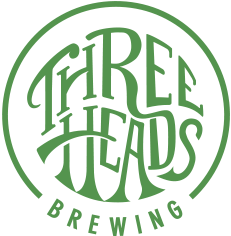
With their new location almost finished and ready for operation, Three Heads Brewing, a craft beer brewer in Rochester, N.Y., wanted a fresh new logo to go along with their change in location. Over the years their old logo had been adapted into several different versions, some shortened, others more stylized, which created inconsistency with their brand. They felt the move was a good time to create a single overarching logo to accurately represent their brand.
Anytime we take on work for a client, we like to begin with a question and answer session to discuss their thoughts, ideas and expectations for the finished product. We want to make absolutely sure everyone is on the same page as we begin the process, especially when creating something as personal and forward facing as a company’s logo. During our meeting with Three Heads Brewing, they explained to us they wanted their logo to be in a style reminiscent of the colorful and highly-stylized art of the psychedelic era. They also wanted it to incorporate a local Rochester element to show their hometown roots.
Knowing the direction they wanted to take, we began the research stage of the project. We looked at competitors, other beer company logos, and the beer industry as a whole to get an idea of current trends and where Three Heads Brewing might fit in the mix. This involved several trips to local beer stores (for research purposes, of course) to see how beer brands from across the country market their products. Next, we created an inspiration board filled with various examples of psychedelic imagery. This included rock concert posters from the 60’s and early 70’s, vintage clothing, and logos from the era, along with Rochester landmarks and themes we felt would be appropriate for a logo. We presented these examples to the client to find which ones resonated with them, and which examples they felt were heading in the wrong direction. After a few rounds of back and forth, we felt we had a solid understanding of the client’s preferences.
Next it was time to put pen to paper and start developing rough logo concepts. This is the phase where our designers really get to flex their creative muscles! We started with pencil sketches outlining a few logo directions, which we presented to Three Heads Brewing to see which sketches best captured what they were looking for in a logo. Then, we made digital versions of several logo options to continue tweaking using graphic design programs.

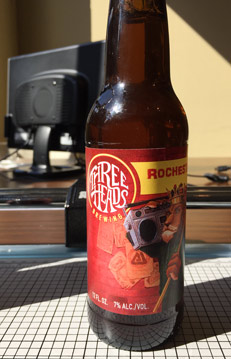
This also let us print the logos in a life-size mock-up to determine how they worked on individual bottles, boxes, and anywhere else it might be used. Our designers literally took printed logos and taped them onto glass beer bottles, then took pictures from several different angles to see how much information was still visible. This let us see if the logos were legible, how they looked from different angles, and what they would look like among other bottles on a shelf in a retail store location.
This is an important step in the design process, as logos can appear very different in the real world once they’ve left the computer screen. For example, when a customer is holding the bottle in their hand, do their fingers cover up any important information? If they’re obscuring part of the logo, does it change its meaning? It’s important to remember your business has little to no control over how your product is presented on store shelves, so making it work in as many situations as possible is a must.
Our earlier research indicated that Three Heads Brewing’s customers were more than just casual beer drinkers. They took into consideration the brewing process, ingredients, style, IBUs and more when deciding on a beer to purchase. As was just mentioned, it’s impossible to know just how every store will display your products, so it’s essential to clearly display important information. In this case, both the alcohol by volume and IBU numbers were factors that had an influence on customers’ beer purchasing decisions. We found that if this information or the beer’s style was placed too low on the packaging, it could potentially be obscured by the shelf edges in retail locations. A little information loss at the point of sale might be OK for brand loyalists who instantly recognize their style’s packaging and were going to make that purchase anyway- but when trying to appeal to new consumers, you only have a few seconds to make an impression on them as they scan store shelves bursting with competitor’s offerings.
We also had to consider the prominence of the artwork used on Three Heads Brewing’s individual beer styles. Each painting is made by a local artist who incorporates various Rochester landmarks and themes into them. They’re typically very colorful and filled with lots of information. We wanted the artwork to be as large as possible (‘leading the dance’ on each bottle), with the logo making a nice complement to the overall presentation. We made their logo work in tandem with each different piece of artwork by creating a part of it that could change colors depending on where it was used. If the artwork had a red theme, the logo could take it on in this changeable element. This lets their logo accompany almost any imagery and still look good.
As mentioned earlier, Three Heads Brewing originally wanted a Rochester element to be part of their logo. We presented them with several designs featuring local buildings, bridges, and other landmarks. What we discovered during this phase of the process was that these elements were simply too generic when made small and included in the logo. We also felt their use complicated the logo and added too much visual information for a simple logo. After several revisions and meetings with the client, we decided to scrap that part of the design. Sometimes less truly is more, and in this case brand clarity trumped the desire for brand history.
A logo may be the first thing about your company a person sees. Their first impression of it could forever shape their opinion of your brand. A good logo should work in all different sizes. Whether on a business card or the side of a bus, it should always be legible and convey the same message anywhere you use it. After mocking up the logo on beer bottles, we did the same for everywhere else it would be used by Three Heads Brewing. This included placing it on six packs, 12 packs, bombers, their website, social media pages, etc. to ensure it worked across a spectrum of uses.
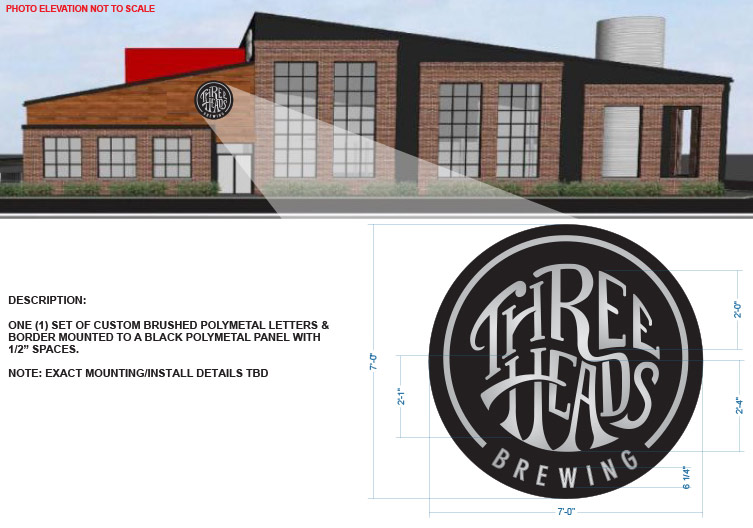
In the end, we provided Three Heads Brewing with a strong logo that stands on its own as an independent brand piece. Our work has helped to evolve their brand, helping to establishing them as a serious player in the craft beer marketplace.
by on Nov 25, 2015
To be successful in business you have to have an understanding of your own products or services, your customers, your competitors, and your industry. Market research is the process by which you gather, analyze, and interpret information, such as economic shifts, current market trends, and the spending habits of your customers, in order to validate or improve your position in the market. It helps you determine how and where to market your business, to whom, and at what price point, before committing substantial resources on what may turn out to be a lost cause. When performed on a regular basis, market research can become a line of communication with your customers, telling you how your customers perceive you, and minimizing potential business loss by identifying objections or issues before they can arise.
The process for performing market research differs based on a variety of factors, including what information you have available from previous research, how long it’s been since you completed previous research, how long you have been in business and what data you have available about current customers, what specific information you are looking for, and the industry you are in. If you’d like to discuss the specifics of your business situation and learn more about how market research can improve your position, please contact us!
Here are some of the major goals of market research. Although this is by no means a complete list, it should give you a good idea of why market research is invaluable for every business.
Whether you are a business about to launch, or a business that has been established for years, it’s incredibly important to understand exactly who your target demographics are and what their lives look like. When you can clearly define who you are trying to reach, and how they want to be communicated with, you can strategize marketing campaigns that are more efficient, cost effective, and ultimately realize more sales. During this process, we work to identify characteristics about your potential customers such as gender, age, household makeup, relationship status, income level, geographic location, communication preferences, other brands they gravitate towards, media they consume, and values they identify with.
If you are an established business, you should be actively reviewing any data you have about your current customers. Market research can help you identify how your customers learned about you, why they chose you over a competitor, what resources influenced their decision, if they would recommend you to friends and family, and what it would take to keep them loyal to your brand.
It’s important to establish realistic business goals to continue to drive your business forward. As you collect information through market research, you’ll have a better understanding of what those realistic business goals look like for your specific business situation. These goals may be areas of potential growth (geographic or product/service niches), revenue targets, budgeting numbers, positive public recognition, or customer acquisition goals.
Using the shotgun approach for your business’ marketing is often wasteful and ill-informed. The more targeted you can make your marketing campaign, the higher the chance you will not only see a return on your investment, but tap into the customer base that is most likely to become brand fans. From your research, you’ll justify how to price your product or service, what target demographic will be interested in your product, what messaging they want to hear, and what media you should use to reach them.
If your business is facing a hardship, such as a decrease in sales, market research can often help identify where the issue lies. You may find that brand awareness within your target demographic has lessened, a new competitor has entered the market, or an alternative product has become available. Market research can even help you understand the motivations and challenges facing your employees or management.
When your business is ready to strategically grow, market research can help you determine the best place to open a new retail store, how your customer base will respond to a new loyalty program, if it’s the right time to enter the online marketplace, or the market’s readiness for a new product or service. There are also opportunities for examining your competitors’ strengths and weaknesses as they grow or adapt to industry changes.
As a result of your research, you may find new areas of opportunity with your target demographic that are either not being filled, or are being filled poorly by a competitor. The sooner you can identify these opportunities, the sooner you can put a plan into place to capitalize on them, giving you another differentiator from your competitors.
Market research is an important component to business strategy, and should be done throughout the life of your business. Investing in market research will allow you to make business decisions founded in the realities of your specific business, not just generalizations about what you think may be a good decision.
If you’d like to learn more about how market research could move your business forward, contact us today.
by on Nov 24, 2015
A logo (which is an abbreviation of “logotype”, meaning “word imprint” in Greek) is a graphic emblem used by organizations to promote public recognition. What we understand today as a logo is the culmination of numerous branding and identification processes that can be dated back to 3500 B.C., and the discovery of engraved cylinder seals that were used as a form of signature. The concept of a logo as a validation or authorization can be seen across a wide spectrum of history, including currency (printed impressions on coin faces identifying the country of origin), genealogy (unique coat of arms for each individual household), and printing (mill identification watermarks embedded in paper).
In today’s marketing world, many people incorrectly interchange the words “brand” and “logo”, using the two to mean the same thing. To better understand the role of a logo for an organization, it’s important to differentiate between the two concepts.
When we talk about a brand, we are talking about the overall “look and feel” that people have when they come into contact with a specific business. It’s the sum total of all of the experiences, impressions, and knowledge that a person has about the business and its products or services. Many different elements go into building this brand, including the business’ positioning, messaging, language, visual aesthetic, voice and culture.
A logo is one design element (albeit a very important element) of your business’s brand identity that helps people recognize who you are, differentiate you from your competitors, and recall why you are important. It expresses the characteristics that you have built up as part of your brand.
As the face of your brand, and as a reflection of the value and quality of your business itself, it’s important that you invest the proper time and resources into the design of your logo.
There are three major types or styles of logos: typeface-based, icon-based, or a combination of both.
Typeface-based logos use only letters to spell out the business name.

Although this style of logo can appear to be the most basic, and perhaps even the easiest to design, in reality it is the most difficult to get right. As we discussed in “Brand vs. Logo”, your logo is the visual representation of your brand to the public. Typeface-based logos have fewer design elements to work with than other styles, and therefore have to rely heavily on choosing the font and colors that accurately convey the brand’s messaging. You also have to consider how the logo will adapt to other alphabets, as the business expands internationally.
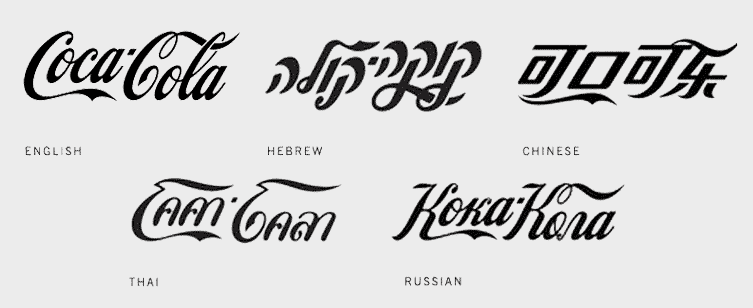
Icon-based logos use only an abstract icon to represent the entire brand. Most businesses do not start out by taking the icon-based approach. In fact, many of the most well known icon-based logos have evolved over time into the forms we see now. This is primarily because these brands have become so well known in the public consciousness that they have cemented the association between their icons and the brand itself.
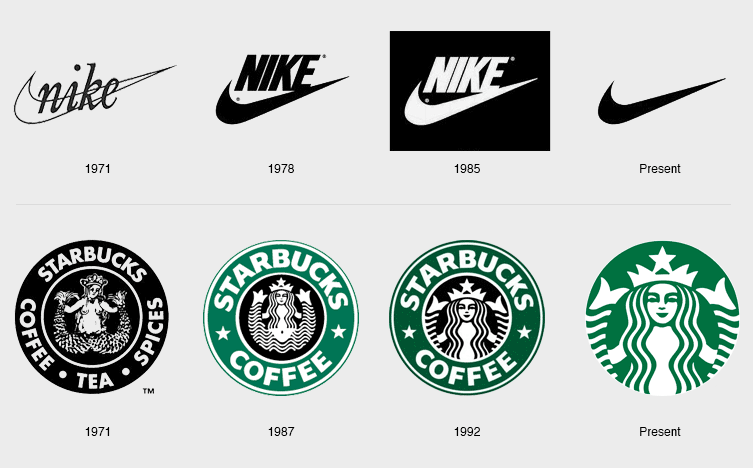
For this reason, it is not recommended that any new business start by trying to take the icon-based approach, unless you are going to support the effort with a healthy marketing campaign aimed at creating that association.
The last logo style is a natural extension of the previous two, and is the most common style seen in the modern business world. The combination style uses both a typeface to spell out the business name and an icon that somehow represents the business or its brand.
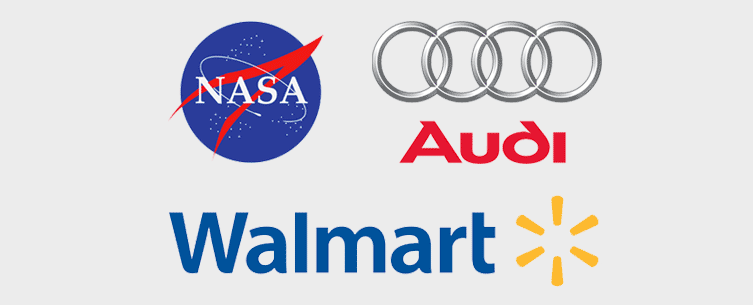
There are five generally agreed upon principles when it comes to the design of a good logo. These are:
Given the importance of your logo for the overall recognition and brand establishment for your business, this article would be remiss if it did not mention a few “do nots”.
The logo creation process is often a very personal process, different for every designer. But there are some major milestones that every professional designer worth their salt will address:
Most people understand the importance of a strong brand, but often eschew investing in the professional creation of a logo that supports that brand. Whether you’re starting a new business from the ground up, or think it’s time to re-approach the logo you already have, get in touch. At Grid, we have extensive branding and logo experience that can help you put your best business face forward.
by on Oct 27, 2015
Every effective marketing campaign begins by asking three questions:
Our client Yarn Culture, a high-end yarn store in Fairport, N.Y., that specializes in unique and hard-to-find yarn, approached us about an upcoming retreat they were hosting at the Corning Museum of Glass, called “Wander / Wool”. Yarn Culture already understood the message they were trying to promote - that this was an amazing, multi-day opportunity for knitting enthusiasts to expand their horizons in the fiber arts - but they needed some assistance in defining who exactly was their potential attendee. Yarn Culture has a large list of past, present, and potential customers, but they needed to determine which of their fans would be the most responsive to the marketing for this retreat. This targeted, more qualified approach would require a bit more work upfront than just blasting the information to their entire customer base, but Yarn Culture understood there would be more potential for sign-ups by focusing on their most likely opportunities.
A car insurance company may be offering the best rates in town for young drivers, but if their marketing is catered to teens (and not the teens’ parents, who often make these insurance purchasing decisions), the message will go unnoticed. It’s the same idea for every business, and every marketing campaign: for the best results, you should be targeting your marketing message to the most receptive audience.
Specifically for Yarn Culture, we knew that we wanted to send an email campaign all about the Wander / Wool retreat to the most qualified customers. We began the work to define this target demographic by reviewing Yarn Culture’s website traffic data through Google Analytics. In conjunction with Yarn Culture, we identified products or information available on the Yarn Culture website that had a relevance to the designers, teachers, or knitting methods that would be featured at the Wander / Wool retreat. With those pages picked out, we evaluated the user flow of viewers that passed through these pages during their visit to the website (“user flow” is the virtual path a user takes as they navigate through a website - what page of your website they load first, each subsequent page they visit, how long they stay on each page, which page they’re on when they eventually close the website while viewing, etc). This information showed us which customers (based on their previous purchases) would most likely be interested in the Wander / Wool retreat - all specifically based on Yarn Culture’s customer data.
We also selected previous customers that had shown consistent interest in new or previously-hard-to-find products, since the Wander / Wool retreat would feature unique fiber arts techniques and artists.
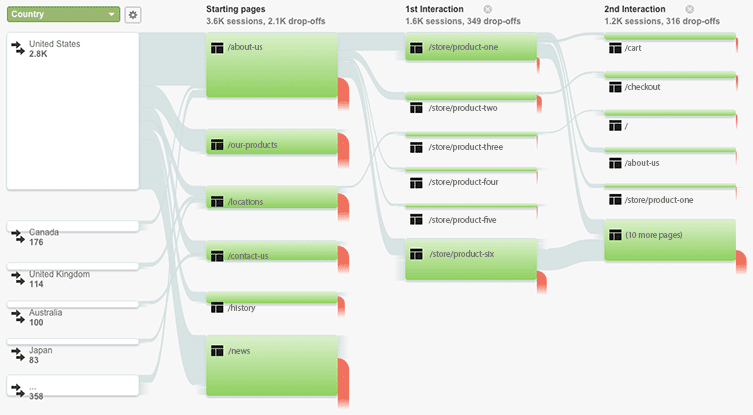
We had already designed Yarn Culture’s informational brochure and takeaway postcard that highlighted the retreat, which they had given out in-store and at their trade show booths. We worked directly with photographers and the Corning Museum of Glass to incorporate attractive, high quality, inspiring photography and design elements that brought out the character of the retreat itself, while staying true to Yarn Culture’s overall brand aesthetic.

We also paid particular attention to the copywriting for these pieces. It was important that the voice, tone, and style appealed to the target demographics, using terminology they understood, that they associated with, and that would position Yarn Culture as an expert in their field.
With the target demographics clearly defined (even down to the specific customers we wanted to reach out to), the overall aesthetic decided on, and the copywriting approach finalized, we moved into designing and developing an email marketing campaign that would support the other marketing efforts, and would send a direct call to action in to the inbox of their most qualified demographics.
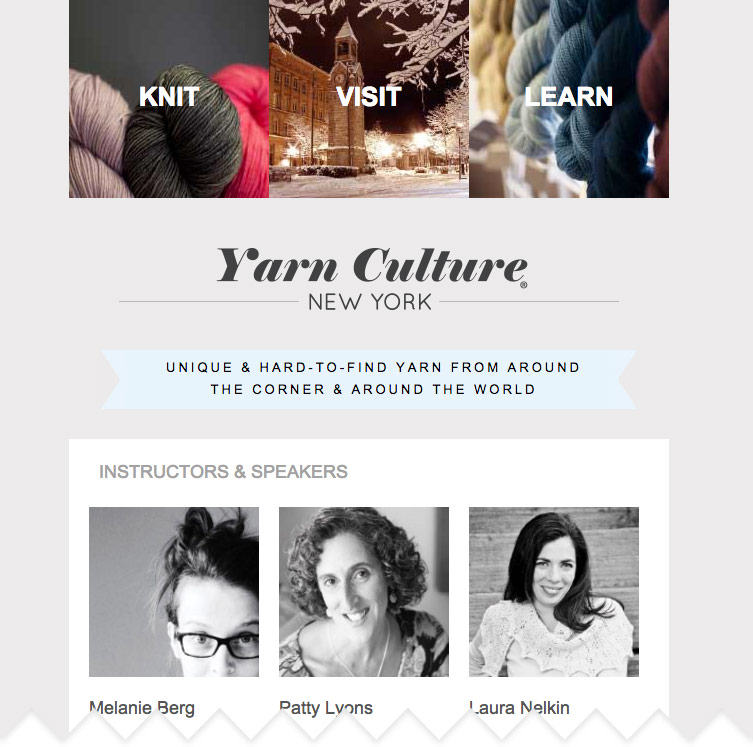
Our approach identified just over 1,000 individuals that we felt would be the most interested in learning about Yarn Culture’s Wander / Wool retreat. Within the first hour of sending the email campaign, more than 40% of recipients had opened it, while a week later, the campaign’s open rate topped at just over 70%. The click-through-rate, which is the percentage of people who opened the email and then clicked a link for more information, was just under 35%. Although email campaign results can vary wildly (based on industry, day of the week, time of day, season, etc), any campaign that sees an 18-23% open rate, or 2-5% click through rate, is considered a success. Comparatively, Yarn Culture’s Wander / Wool email campaign was a home run!
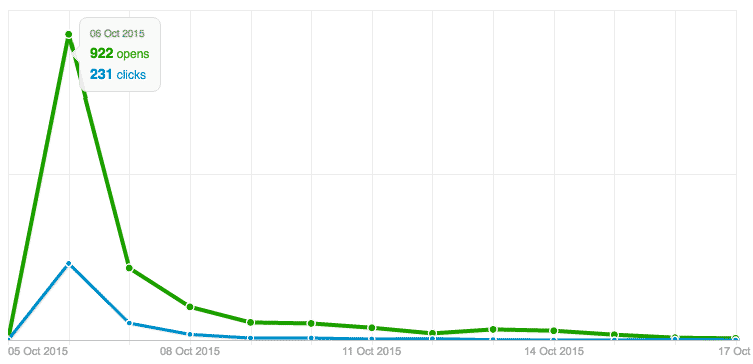
The importance of positioning the right message in front of the right demographics cannot be understated. Yarn Culture’s email was so effective because they utilized data they had available to make the best marketing decisions, and therefore maximizing their return on investment. Our work with Yarn Culture on this campaign, from Analytics analysis of their website traffic, to graphic design, copywriting, and development of their informational brochure, postcard, social media graphics, and email campaign, supported Yarn Culture’s overall brand and industry positioning, and delivered exceptional results.
by on Oct 21, 2015
Google Analytics is far and away the number one analytics tool in use on the web today. In 2014, it was reported that 67% of Fortune 500 companies use Google Analytics, with somewhere in the range of 29.5 million total websites using the data platform. So just what is Google Analytics, why has it seen such a high rate of adoption, and what can it do for you? In this article, we’ll cover all these questions and more, to show you in what ways Google Analytics can help you get more out of both your website and your overall marketing efforts.
Google Analytics is a free but comprehensive web-based program that tracks a wide array of data about almost every visitor to your website. You may be familiar with “counter” programs of old, which tracked each individual “hit” to your website. We felt pride and joy every time we visited our website only to see our counter had gone up by two, five or ten hits since last time we checked!

These counters were the early pre-cursors to the more feature-rich analytics programs of today. To implement a counter you copy and pasted a few lines of code into your own website’s code that ticked up one every time someone reloaded your page (including every time your Aunt May in Ohio refreshed the page to see anything new you added). These gave you a better understanding of how popular each page of your website was, but lacked more specific capabilities, such as seeing how many people were first-time visitors, or what region of the world your visitors were located.
To get started with Google Analytics, you begin by creating a Google account (or logging in to an account you already manage) and going through a series of setup steps that help Google identify what website you want to track. Google. Google does some behind-the-scenes verification to make sure you are the owner of that website, preventing you from tracking information for a website that you are not affiliated with. Once your account is set up, Google provides you with a snippet of code (similar to the one in the image below) to be copy and pasted into the code of your own website.

This snippet should be added in a specific place within the overall structure of your website’s code. For this reason, we suggest that you consult with a developer (like us!) to ensure that your Analytics code is incorporated in the correct place. Within 24 hours, Analytics will begin collecting data about almost all of your website visitors.
Almost all? Although Google Analytics can paint a much more detailed picture of your website traffic than you’ve been able to see before, there are several reasons (some fixable, some not) that may prevent you from receiving some or all of your data.
At this point in the article you may be worried that your Analytics data will be so different from your actual traffic that it may not be worth reviewing at all. That’s far from the case! Although each of the above scenarios are common occurances, they are not absolute roadblocks that prevent you from making informed decisions based on the data you are seeing. They are simply important pieces of information to keep in mind as you are analyzing your own data.
Now that you have Google Analytics up and running, what types of data will you start to see?
Acquisition - how viewers found your website, where they are coming from (such as a search engine, an affiliate website, an email campaign, one of your social media pages, etc.), what keywords they used to find your website, if they came to your website by typing in your url directly, etc.

Demographics - age, gender, interests, device (such as mobile or desktop, and even more specifically, which mobile device model), browser and version, internet provider, geography, language, and more.

Behavior - what day and time they visit, what pages they view and for how long, what page they are viewing when they close your website, if they have been to your website before, etc.
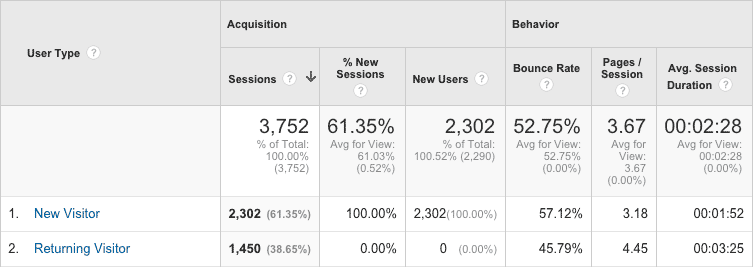
Conversions - if set up, you can see the exact behavior flow of people who complete a “conversion” of your choosing, such as making an online purchase, filling out a contact form, or downloading a white paper.
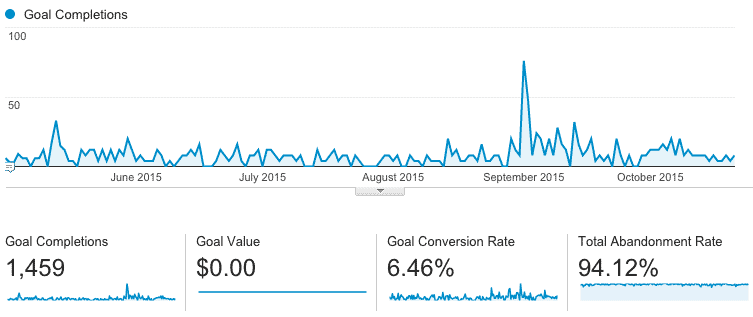
Although it’s helpful to see each individual piece of the above information, the real power of Analytics comes from evaluating all of this information together, especially by considering them in the context of your business goals or marketing objectives.
One of the first questions we get after someone views their Analytics for the first time is, “is this number good or bad?” It’s important to remember that each piece of data you collect is neither good nor bad in and of itself. Knowing you receive five daily visitors or 500 doesn’t mean much until you consider it in the context of who this traffic is, what they viewed, and what the outcome of their website visit was. Five daily visitors who convert to sending you an email is a far better statistic than 500 viewers who bounce off the homepage right after loading it.
Here’s a more detailed example. You are given access to a website’s Analytics, and see that 5% of all website traffic is between the ages of 45 and 55. Would you consider that to be good or bad? It depends, of course! Without taking into consideration what the website is about, or who their target demographic is, you can’t make the determination if 5% means their website is performing the way it should be.
Let’s say the website is for a travel agency, who specializes in bucket-list, around-the-world adventures. You’d expect to see more traffic from people in the age range of 45 to 55, meaning this travel agency may not be reaching the right demographics with their marketing efforts (since such a small percentage of all of their website traffic is in that age range). Alternatively, you may find out that this travel agency has been running a big marketing campaign to promote the idea that bucket-list travel is for people of all ages. In that case, the seeing “only” 5% for that age range means that many other age ranges may be represented, and may signal a success in terms of their marketing efforts for that particular campaign. This is why it is so important to define your business and marketing goals before you try to ascertain how your website traffic is performing against those goals.
Similarly, reviewing your website traffic may give you a more accurate representation of what your demographics look like, versus what you think they look like. They can show you what your website viewers want to read or interact with, as opposed to what you think they want to read or interact with. Analytics can provide you with the information needed to bridge the gap between what you think about your customers versus who they really are. Without truly understanding who your customers are, none of your marketing efforts will be as successful as they could be.
Lastly, your Analytics may give you insights into potential avenues of additional revenue that you may not have recognized before. Our travel agency may note that 15% of their website traffic is made up of female seniors, ages 65+, who are cooking enthusiasts. This may spur the travel agency into putting together a food-related travel adventure that takes into consideration limited mobility. Without having the Analytics to identify this niche group, this travel agency may never have recognized that this type of opportunity within their potential customers existed.
Although the number of examples of what you can infer from your Analytics are endless, the takeaway should be that Analytics provides you the opportunity to make better business and marketing decisions - ones that are based specifically on activities surrounding your business that you may otherwise never be able to quantify.
If you need help setting up Google Analytics, have more questions about how it works and what it can do for you, or would like assistance in analyzing data you’ve already collected, we welcome you to reach out.
Photo courtesy of flickr user Roel Willems.
by on Oct 6, 2015
A marketing plan is an essential road map for your business, and is as critical to your success as hiring talented and motivated team members. Your products and services will not sell themselves. And all too often we hear of businesses forgoing marketing altogether simply because they are “doing well now”. The goal of marketing is to ensure long term success. It is not purely about bringing new sales through the door, but also making sure that the customers you have now are still with you three, five, or 10 years down the line. By ignoring marketing, or by participating “on the fly”, many businesses risk hitting a brick wall and failing simply because they do not have enough time to let an effective marketing campaign come to fruition.
Let’s take a look at three fictional cases, from best scenario to worst, to identify where you and your business may be starting at.
Best Case - You have spent the time necessary to define specific business goals that you want to achieve, and have developed a detailed road map to reach them. You recognize that the time you invested in your marketing plan is essential to the health and viability of your business, as it will guide you and your team’s efforts from here on out. You have established how you will measure your results, and set out a regular schedule for reviewing and analyzing your progress so far. As a result, you know exactly what does and does not work for your business, and can make adaptations to ensure the success of future efforts.
Neutral Case - You’re very busy, so it’s hard to dedicate the time necessary to building a marketing plan. Instead, you have examples of marketing plans that you found online, on which you’ve jotted a few loose goals and ideas as to what you would like to do over the coming year. You have a rough dollar range for your budget, but intend to keep your spending to the lower end no matter what.
Worst Case - You don’t have a marketing plan, nor have you considered a budget. If you need something, like more business cards, you’ll invest the money, but anything else feels superfluous. After all, marketing is something only “bigger” companies do, right? You probably tried “marketing” at one point (remember that eighth page ad you put in the newspaper that one time five years ago?), but you didn’t see any results. In fact, you’re not really sure what results you had, because you weren’t tracking the response very diligently.
Feeling overwhelmed at this point? Don’t! At Grid, we can walk you through every step to create the perfect marketing plan for your business. Get in touch with us by clicking here. Ready to tackle this on your own? Great, let’s get started!
What are the goals that you want your business to achieve? When you set out to answer this question you may find yourself being too vague or non-descriptive. It’s incredibly common to see a business owner go through three or four rounds of revisions until they have their goals spelled out carefully enough. “Increase sales”, for example, is not a descriptive enough goal to use for laying out a marketing plan. Although far from all-inclusive, here are some questions that may help you define your own goals:
Although many of your goals may be quantitative in nature (such as increasing revenue, total number of customers, or units sold), don’t forgot the importance of strategic goals (increasing awareness of your brand, improving public perception, or cultivating brand loyalty).
Lastly, remember that it’s normal to have several business goals - some longer term than others. You will be reviewing these goals regularly, and their priority in relation to each other can, and will, shift.
If you haven’t already, it’s important at this time to build out three to five buyer personas that represent who you need to market to in order to reach your business goals. Buyer personas are a set of semi-fictional representations about your ideal customer based on market research and real data, including things like age, sex, income, family makeup, motivations, buying patterns, and goals. When considering your newly defined business goals, it may be necessary to go back and adjust your already-established buyer personas - adding or subtracting pieces of information (or personas as a whole) as you feel necessary to reflect the current state of your business. Make sure you consider things such as how much money each persona has to spend on things like your product or service, what other brands they typically buy from or gravitate to, where they get recommendations before they purchase, and how long their typical buying cycle is. By the end of this step, you want an accurate portrayal of the types of individuals (or organizations, if you are business to business) that will be the intended recipients of your marketing.
You can lead a horse to water, but you can’t make it drink. For every marketing effort that you consider launching, perform an audit of your available internal resources that would be involved in following up with a lead, closing the sale, and performing the work to completion. If your marketing campaign is successful (as we hope it will be!) will your processes and personnel be able to not only meet the demand, but perform to the level of quality that you expect? When making these considerations, it’s important to be critically honest with yourself about the systems you have in place. It’s better to find potential points of failure while you have time to rectify them rather than when you are full swing into a campaign.
Before you can create a marketing plan you need to have a firm understanding of why a potential customer should choose you over the hundreds or thousands of competitors in your industry. Competition is healthy, and pushes us all to be better people, businesses, and organizations - but if you can’t clearly (and succinctly) describe what sets you apart, you’ll never be able to convince a potential customer of the same (and they’ll happily move on to a competitor who can). Your differentiator can be any number of things: price, level of customer service, previous experience, industry knowledge, area of coverage, follow up support, extent of community involvement, use of technology, etc. Always keep your differentiator in mind when determining when and how you should be marketing your business to your target demographics.
When you are ready to begin your budgetary considerations, do yourself a favor and be fully up-to-date on your financial information so you know exactly what you are working with. Familiarize yourself with both historical data, such as previous year sales and gross revenue, and any projected data you may have available, such as sales projections or growth plans. If you are not thoroughly grounded in the realities of your current financial situations you will not be able to put together a realistic marketing plan - and that may be the only thing worse than not putting a plan together in the first place!
There are several oft-repeated “formulas” for determining what your marketing budget should be, such as 2-5% of your projected gross revenues, or anywhere from 3-10% of your annual operating budget (depending on your current stage of growth). In reality, the only “right” answer to the budget question is that you should have a budget in the first place. Your business and business goals are unique to you and you alone. Your budget should be a reflection of your goals and timeline, as opposed to a number run through a formula.
As you consider your marketing budget, there are a few things you should remember. First, it is critical to understand that your marketing budget should not just be based on what’s left over once all of your other business expenses are covered. Marketing IS a business expense, and it should be one of the most important expenses you allocate for considering it has a direct effect on your bottom line.
Second, you should invest as much as you can into marketing, especially if you are in the first few years of business, or in the first few years of making a marketing push. Many times campaigns can continue to grow off of themselves, meaning you won’t have to invest as much in the same campaigns as you move along. If you invest heavily from the get go you can plan to ride the wave of a long tail of results.
Third, what are your competitors spending? You obviously aren’t going to have insider information into their financials, but you can get a general idea of what sort of budget it will take to compete on the level they are. Do you see their billboards and print advertisements all over the place? Do you regularly see their television commercials, or hear their radio ads? If you find that your competitors are working with a much larger budget than you can afford, don’t despair! A well thought out and executed marketing plan directed specifically towards your ideal demographic (including your attractive differentiator) can make up the difference between a small and large budget. Remember that quality can trump quantity.
Lastly, some of the most essential marketing tools available today are also some of the most cost effective, such as your website and social media. It’s easier than ever for you to connect with current and potential customers - you can leverage a trade off of your time for positive customer perception.
Now it’s time to start identifying the marketing efforts that will bring your message to your demographic, in a way that will help you achieve your overall business goals. Start by identifying three major campaigns that you’d like to roll out - that is, three overarching concepts that you’d like to make available to your target demographics. It’s impossible to list every different type of marketing effort that might be suited to your needs, but some of the more common efforts might include improvements to your website, email campaigns, print or digital ads, radio and television ads, outdoor advertising, direct mail, press kits, social media, public relations, and trade shows, just to name a few. Next, decide what actual marketing efforts you will need to use to enact this campaign, and all of their associated costs (such as hiring a graphic designer, the production of a trade show display, or the print cost of a brochure).
This may be the most daunting portion of your marketing plan, and that’s to be expected. Take your time in considering all of the pieces of information you’ve pulled together so far - what you are trying to say, who you are trying to say it to, and what budget do you have available to work with - to determine what efforts will strike a balance between investment and payoff. If you need additional assistance during this part of your planning, remember that we are a phone call or email away!
During this process, you’ll also want to start establishing timelines. How long will each overarching campaign last, and how long will each marketing effort that comprises the campaign be in effect? Don’t feel limited to making all of your campaigns fit perfectly within the calendar or fiscal year. Depending on their specifics, campaigns (and their associated efforts) may span several years, or only last a few days.
Technology has provided us with a number of ways that you can track the effectiveness of your marketing campaigns, from Google Analytics and Webmaster Tools, to Nelson and publication reports. But hard data can only track so much, so it’s critical that you are diligent in asking customers how they heard about you.
It’s also important to remember that data in and of itself is neither good nor bad. Seeing a low response to a marketing effort can only be construed as positive or negative when placed in context with your overall business goals. For example, let’s say you sell business to business and focus on providing high-cost, long term contract services. If you sent out a direct mail campaign to 1,000 businesses, and converted just one into a sale, that may be considered a tremendously successful marketing campaign given the context of your business and goals. If your goal, however, was to convert a larger quantity of smaller sales, direct mail might not have been the direction to go.
As your plan progresses, and some efforts wind down while others ramp up, take the time to do the math to determine how much it cost to bring a potential customer in the door, what he or she spent with you, and if there is a recurring revenue stream. Evaluate how much impact each specific effort had on your bottom line. You may find some intriguing bits of information, such as realizing that a direct mail campaign cost you the least but only resulted in sales of your lowest tier offerings, while a television ad that cost the most netted several high tier customers. Compare time frames, seasons, and pay attention to news or social items that may have played a role in increased or decreased interest in your business. Also keep in mind that many marketing efforts may be difficult or down right impossible to track, or may require a long term evaluation of data to determine their outcomes.
Your marketing plan should always be evolving and adapting to the trends you are seeing, the successes (or ‘not so successes’) of your marketing efforts, and the current state of your business. As you enact campaigns, see the reactions of your demographics, test your internal resources, judge the response to your differentiator, and fine tune your budget. Your overall marketing plan should be flexible enough to allow you to re-shape and improve as you move forward. Don’t lock yourself in to an email campaign a month if you aren’t seeing the type of responses you wanted. Conversely, don’t strike all email campaigns off of your plan as a knee jerk reaction to a few fumbles.
While a fleshed out marketing plan takes a considerable amount of time and effort, the rewards you will reap will by and large make up for it. At the end of the day, remember to keep yourself and your marketing efforts focused on advancing your business toward your goals, accept when an effort does not go as planned, and be patient. Every marketing effort is either successful or is an opportunity for success the next time around.
Have more questions than we covered here? Get in touch!
by on Sep 16, 2015
Sponsorships are a fantastic way for businesses to increase their reach and credibility, while reinforcing brand perceptions and driving more traffic to their various touchpoints, such as retail locations, websites, social media platforms, newsletters, and exhibits.
When our client Whitefish Credit Union, the largest credit union in Montana, entered into a sponsorship contract with their local fairgrounds, the Flathead County Fairgrounds (which hosts the largest county Fair in the region), it afforded them numerous opportunities to put their brand in a positive light, front and center in the local community. We recognized these opportunities and helped them to develop a multi-pronged approach that took full advantage their sponsorship.

Thanks to their sponsorship deal, Whitefish Credit Union was able to fully brand the back of each ticket sold for the Northwest Montana Fair. This put the Credit Union’s tagline and logo in front of nearly every visitor to the Fair. It also linked their brand with a local family-friendly event which is thought of very positively in the area and associated with fun, laughter, and good times.
In 2015, 74,924 people attended the Northwest Montana Fair. That’s the equivalent of 81 percent of the county’s population, and each and every one of them was exposed to the Whitefish Credit Union brand in a fun and pleasant atmosphere.
In addition to gaining brand exposure, Whitefish Credit Union saved their members money by selling discounted Northwest Montana Fair tickets through each of their six branch locations across Northwest Montana at 40% off. Selling these tickets meant an additional 10,000 visits to Whitefish Credit Union branches over roughly a three week period. To be clear, that was 10,000 times both members and non-members throughout the area engaged in some sort of face-to-face interaction with a Whitefish Credit Union representative. That is a lot of chances to gain new members, increase retail sales, expose customers to brand messaging, and generally create a positive brand experience for these discount ticket buyers.
Beyond face-to-face interaction, Whitefish Credit Union began an aggressive social media campaign to advertise their discounted tickets, promote their association with the Northwest Montana Fair, and offer their fans the chance to win free Fair concert, rodeo and demolition derby tickets. We made use of Facebook and Twitter as the primary social media platforms. The campaign was immensely popular, resulting in a 1,000% increase in social engagement during the week of the Fair.
Whitefish Credit Union was also able to recognize some of their hardest working employees with free parking passes, general admission, and tickets to evening concerts, rodeos and a demolition derby. This strengthened not only the public’s opinion of the Whitefish Credit Union brand, but their own employee’s loyalty and appreciation of the Credit Union.
Through the clever use of social media sweepstakes, Whitefish Credit Union also saw a dramatic increase in page likes during the week of the Fair. Social media users began to recognize Whitefish Credit Union’s Facebook page as a reliable, informative source of Fair information, discounts, and freebies.
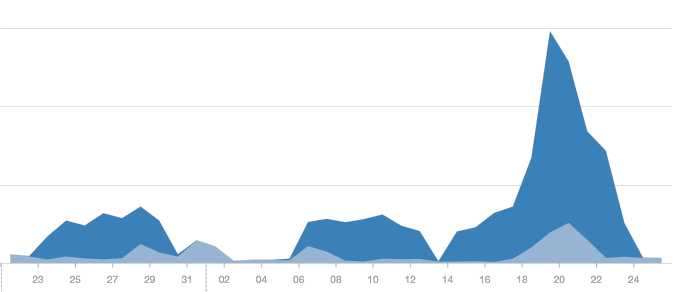
While they may have only had short-term gains in mind when following the Credit Union, the increase in fans has given Whitefish Credit Union a wider audience with which to share their brand message now and in the future. The organic page engagement during this event means a more broad and receptive audience for future posts and promotions. These new fans may also be more inclined to think of them for their next mortgage or vehicle loan in the future.
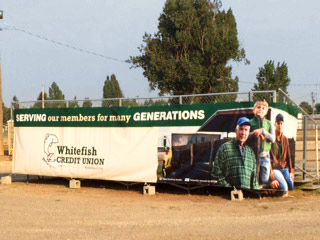
We created branded signage to be displayed throughout the fairgrounds. These illustrated the Credit Union’s commitment to the local communities it serves. Banners and wall art were displayed prominently in high-traffic areas throughout the Fair both inside and out, including a large multi-paneled banner at the main gate welcoming visitors to the Fair alongside the Credit Union’s logo.
Flathead County Fairgrounds Manager Mark Campbell might have put the benefits of corporate sponsorship best when he said, “From our perspective, corporate sponsorship has become ‘the’ key factor in operating a successful program, allowing us to expand, enhance, and reach our audiences in ways just not possible otherwise.”
In 2015, 74,924 people attended the Northwest Montana Fair. That’s the equivalent of 81 percent of the county’s population, and each and every one of them was exposed to the Whitefish Credit Union brand in a fun and pleasant atmosphere.
by on Sep 15, 2015
Understanding the fundamentals of copywriting can put you on a path to marketing success. Although copywriting is only one tool in the marketing tool box, it’s as influential and important as a pair of scissors for a do-it-yourselfer. Copywriting is used in every piece of marketing you do, and it can make or break your entire campaign, so it’s worth understanding the hows and whys behind this often overlooked art. And while it’s true that successful copywriting comes naturally for some people, for the rest it’s a skill that takes time and effort to perfect.
What sets copywriting apart from other types of writing is the ultimate goal. With news articles, editorial writing, or blogs, the goal is to inform your reader about a topic. With marketing, you’re trying to convince someone to take an action, also known as the “call to action”, without beating them over the head with capitalization and exclamation points. And while your messaging should always be able to stand on its own, its effectiveness can be maximized if it works in conjunction with your design and the marketing medium. Below, we explore the different facets that go into making your copy successful, and what they mean for your marketing.
The goal of all copywriting is to connect with your reader, and that means starting with understanding who will be reading your copy in the first place. Are you addressing current or potential customers? Men or women? Old or young? Every piece of demographic data you can define about your audience will guide the copy that you write by helping you select terminology, make social references, relate to cultural ideologies, and more.
Every piece of marketing has a goal, whether that’s to drive sales of a particular product or service, educate about a topic, or even to just to keep your business top of mind. You then use your copy to help guide the customer towards achieving that goal using a “call to action” that is clear and concise. For example, let’s say you are hosting a fundraising event and want to solicit monetary donations from local businesses. The goal of the campaign is to, therefore, secure donations from local businesses. The copy should be used to explain the how and why of the fundraising; it should explain the cause, give a compelling reason as to why supporting the cause is important, and outline any benefits that a business would receive from donating. The call to action, in this case, may be to “mail a check” to an address. Overall, the copy should be used to guide your viewer down a path between receiving your marketing, understanding your goal, and completing your call to action so that your goal for the campaign is met.
When writing marketing copy, you should be constantly re-reading your text through the lens of your target audience. If you don’t, it’s akin to speaking English to a room full of French only speakers. They may get the gist of what you are trying to say, through things like your body language and universally understood gestures, but the details will be completely lost to them. So, too, is it important that you use terminology and language that your target audience will not only understand, but associate with. A younger demographic, for example, may not understand your reference to the “joys of sharing a mixed tape with your closest friends”. Asking your readers to “share this on Instagram” will be lost on an older audience.
We live in an age where your potential customers have incredibly easy access to not only you, but your competitors. They can, and do, research and compare your services, pricing, and reviews before making the decision on which business to choose. It’s best to choose one difference that sets you apart from your competitors, and make that your selling differentiator. The most typical differentiators you hear are price or customer service, but it can be a number of other things, such as coverage range, face to face time, community involvement, or level of expertise in your field.
The easiest and most effective way to compel a reader to complete the goal that you have laid out is to provide them a value for completing it (often called the “conversion”). For example, a gutter cleaner may be trying to encourage pre-booking of their seasonal services, to ensure a consistent and balanced workload. Their value add may be to offer 20% off any service that is booked before the end of the month. This encourages the reader to act within a certain time, and react to the call to action (“call now to book your appointment”). Value adds can vary wildly between businesses, which is another reason why it’s so important to understand your target demographic. What type of value add you decide on should be driven in large part based on the types of rewards or offers your specific demographic is known to respond to.
As with any of your marketing, make sure that your copy is consistent in voice and tone. When people read your content, they have a voice in their head that they use to represent you, as if you were speaking to them. It’s important to try to guide this voice selection so that it not only matches and supports your brand, but remains consistent from campaign to campaign. For example, if your postcard calls you “the best darn-tootin’ accountant in the West”, people are going to form a distinct impression about your brand. They will probably hear the voice as being an old timer miner’s voice, complete with a mental picture of a flannel clad, beaded man holding a pick axe slung over his shoulder. If your goal for your brand is to portray yourself as a detail oriented, corporate accountant, this voice misses the mark.
The type of copy you write relies heavily on the medium that you are writing it for. When considering your copy, try to envision your end reader in the typical setting they would be in when exposed to your copy. If you are writing for a billboard ad, your end reader is probably commuting to or from work, driving at an average speed of 55 to 65mph. They won’t have time, or necessarily the interest, in reading five sentences of copy, even if it IS the most engaging content in the world. Alternatively, when working on a brochure, you can guarantee that anyone who is reading the back panel is trying to dig out every detail about your topic that they can find, since they bothered to flip through the other panels and ultimately turn to the back side. Understanding not only the space that your copy can fill, but also the intent of the reader when they get to that copy, can help you narrow down what your copy contains.
At the end of the day, you don’t want your copy to sound like a carefully selected set of calculated words aligned side by side to maximize effect. Keep your copy genuine, honest, focused on what you want to share with the reader, and what benefit they will gain from reading it. Recognize that this is an exchange of your readers’ time for your information, and each side as to be equal in importance and benefit in order for your copy, and therefore your marketing, to be successful.
Photo courtesy of Flickr user dtron.
by on Sep 10, 2015
Sponsorships can be a difficult area of marketing to branch into, especially if it’s your first foray. What sort of sales will you get out of a hanging banner at a school baseball game? What’s the real benefit of adding your logo to the back of a t-shirt? Or, most often, why should you choose to spend budget on a sponsorship over something more direct, like a television commercial or direct mail campaign?
We’ll explore the answers to these questions below, including the different ways your business can find value in sponsorship, what to expect from your ROI, and how to get the most out of every opportunity.
So just what is the value of a sponsorship? The answer is, like many things in marketing, different for every business. Factors include identifying what your business goals are (what you hope to get out of the sponsorship), what event or organization you choose to sponsor (are you positioning yourself in front of the right people), and how involved you are willing to be (working with the organizers to further your benefits).
We’ve put together a list of the most common, but certainly not an all extensive, list of the top benefits most companies see as a result of sponsorships of one type or another.
This is one of the leading objectives for business to business service industries, such as banking, insurance or telecommunications. With many facets of your service being similar or the same as your competitor, you need to capitalize on every potential edge you can find. By aligning yourself with successful events or organizations, you may be able to give yourself the slight edge needed to bring potential customers to your door, instead of sending them away.
Sponsoring specific topical events positions you as being an expert in that field, and gives you access to a niche demographic that you know could benefit from your product or service. An accounting firm that sponsors an all day “boot camp” for start up businesses automatically positions themselves as being an expert in accounting for start ups, plus gives them the opportunity to network with new business owners who will have an immediate need for that type of service.
Which events or organizations you choose will say a lot about your business. Sponsorships provide an excellent opportunity to introduce, change or reinforce your brand image. For example, when a financial institution sponsors a local high school sports team they are reinforcing the perception that their brand is invested in the growth and ultimate future of the community. Alternatively, if a restaurant that is known to be high end decides to sponsor an eating contest, they may be trying to realign their brand to be more casual and low key.
The hosts or planners for your chosen event will have a marketing plan that outlines how they will drum up attendance for the event. This may include interviews with local television stations, articles in relevant print media, or press releases announcing the details of the event. With the right level of sponsorship, and the right negotiating skills, you can ensure that your business receives mention in some or all of this media outreach.
You probably already know that the cost of advertising your products or services is tax deductible - but promotional expenses such as sponsorships are also deductible so long as there is a clear connection between the sponsorship and your business. Having your name listed in the event program, or being allowed to display signage, is evidence that it is a promotional effort. As always, when it comes to tax deductions and what may or may not be allowed in your state, we suggest that you speak with your accountant.
If your business is participating in social media (and really, it should be) event participation can lead to some really wonderful social media and public relations opportunities for your own business. By sharing your participation and support of the event, you can continue to grow brand loyalty among your followers, even if they are not attending the event. Press releases can also be used to announce your participation, gaining even more wide spread acknowledgement if it is picked up by the press.
Many events offer special opportunities for sponsors to network with each other. These can be get togethers or parties before or after the event, or even special access areas during the event itself. This can be a great opportunity to put yourself in front of larger businesses, or businesses that share the same demographic as you. After the event, organizers should also have a list of all attendees, which you can use to add to your own marketing lists.
Showing a commitment to the community you work in promotes a large amount of good will among almost every demographic. From young to old, the level of involvement that a business has in its local community can be a deciding factor in turning a potential customer into a current customer. By sponsoring local activities, you’re on the front line to receive that good will.
Some specific types of events can help you drive additional traffic into your retail space. For example, if you are sponsoring a local fair, trade show, or other event where attendees have to purchase a ticket, most often you can arrange with the event organizers to sell tickets from your location. This takes some of the weight of selling tickets off of the organizer, and gives you more opportunity to get people through your doors. In addition, if the event is large enough, see about arranging to have a display for the event at your shop. This can be something as simple as a table with photos from previous events, or showcasing products from vendors who will be attending, to something more elaborate like a sports car if you are sponsoring a car racing team.
Depending on the type of services you provide, or products you sell, you may be able to trade your sponsorship for supplying the event itself. If you are an AV company, you could offer to help wire up each display booth, or hang a projection video screen for promotions. If you provide security services, offer to staff the venue on the day of the event, or provide a security plan in case of an emergency. Many event organizers would rather work with a company in trade for their services, rather than hire a third party vendor.
There are often many opportunities for securing high levels of sponsorship without having to spend big bucks. Try to negotiate with the organizers to volunteer you or your staff’s time for setup or takedown at the venue, for registering people as they come in, or for handling phone RSVPs. Or, donate some of your products, or some of you service hours, to be given away in a raffle, silent auction, or as a “thank you” gift for attendees. There are a lot of ways to “upsell” the value of your involvement and secure a higher level of sponsorship than a direct monetary donation may allow.
When you do decide to sponsor an organization or event, make the most out of it. Never be afraid to work with the organizers to negotiate better terms. They need sponsors like you to make their event successful, or keep their organization running for another year. They know that they are asking a lot of you, and expect you work with them to get the most out of your sponsorship.
Don’t select sponsorship opportunities willy nilly. First, make sure you have your own target demographic properly defined. Then, work to find an opportunity that most suits your end goal. If you’re looking to market towards women aged 25 - 45, sponsoring a manufacturing trade show may not give you the results your looking for. Try asking the event organizers for demographics from previous events - they may be able to provide you with narrowed down information that can help you make your decision.
You don’t get a second change to make a first impression. Many people at the event may not have ever heard of you, or know what you do. Hire a professional marketing company that can assist you in designing whatever collateral you need, such as hanging banners, vinyl graphics, flyers, posters, or even video presentations. If your presentation doesn’t look polished and professional, you’re missing out on the opportunity that securing that sponsorship would otherwise provide.
Remember that the organizers want to promote their event just as much as you want to promote your business. Work with them on cross promotional activities, such as sharing each other’s social media posts about the event, collaborating on press releases or media outreach, or sharing the cost of a promotional campaign such as direct mail.
Measuring ROI is an incredibly difficult challenge when it comes to sponsorships. How do you track someone noticing your banner at an event, going home, visiting to your website two weeks later, and ultimately closing a deal with you, and attributing that as being a result of your sponsorship? Sponsorships are about general brand awareness, garnering positive publicity, and remaining top of mind for people - that type of good will cannot be measured. However, you can keep a close eye on your marketing analytics to draw some conclusions. You may see an uptick in your website traffic for the two weeks immediately following an event, or you may see more engagement on your social media channels. Lastly, you should always be asking potential clients how they heard about you. Although by no means 100% foolproof, this will give you some general ideas about where the last touch point was with that potential customer before they contacted you.
by on Aug 4, 2015
A (Very) Brief History of Unmanned Flight
Drones have been in use since the early 2000s. The first wide-spread application? You probably guessed it – the United States military. The unmanned aerial vehicles, or UAVs, were flown over Afghanistan collecting geographic data and relaying information back to the military. Prior to September 11th, 2001, these drones were unarmed and used solely for gathering information in unsafe areas without having to risk soldiers or expensive aircrafts.
Fast forward to 2015, and drones are still an impressive application of modern technology and aerodynamics. Their uses range from ocean cartography, and hurricane-hunting, to beer delivery, and casual backyard hobbyists that want to fly a mini-helicopter in their backyards - because, well, who wouldn’t want to do that? Drone and quadcopter technology has become much more publicly available following the late 2000s and early 2010s, which has led to business owners and hobbyists discovering many creative uses for this technology.
These tools are a godsend for filmmakers – cinematographers are using UAVs to bring their cameras where they’ve never been before. Freeing the camera from being restricted to solid ground, drones can fly in any direction, and capture shots high enough off the ground that you’d need a crane to shoot, but low enough that it would be impossible for a traditional helicopter to get the same shot. Their lightweight properties and quiet motors make them very suitable for narrative film sets, as well as commercials.
Aerial Videography in Marketing
The falling price point has made this technology affordable for the hobbyist and professional alike. It is remarkably less expensive than having to rent a helicopter or airplane for higher-end productions. Companies such as Astraeus Aerial, SnapRoll Media, or Aerial MOB specialize in aerial drone photography for film and commercials, working with companies like BMW to create beautiful ads with unique and memorable cinematography.
One of the other larger industries capitalizing on drones is the real estate market. Many architectural photographers and real estate agents are using them to capture aerial photographs and videos of their high-end homes and properties for sale. The production quality of aerial photography can be very impressive, and virtually unachievable for a photographer standing on the ground. It’s an affordable way to get great looking shots showcasing a property for sale.
ORNL Federal Credit Union worked with JAOPRO to create this feel-good ad which promotes vehicle loans in a way that captivates the viewer, even if they aren’t aware of the overall message. What sets this ad apart is not the message, but the way in which it was filmed. Utilizing drones for aerial videography lets you get the perfect angle, even if you are following a car zooming across a bridge at 60 miles per hour with incredible smoothness and stability.
Coca-Cola went to Singapore to film this ad campaign – It’s a very emotionally-driven ad in which drones are used to deliver polaroid photographs to construction workers of Singapore. Each photograph contains a Singaporean citizen holding up a hand-written sign thanking the workers for their labor, and each photograph is tied securely to a Coca-Cola can – over 2,700 photographs were delivered to Singaporean construction workers by drone.
Aerial MOB flew a RED Dragon camera through the streets of downtown LA for this Peugeot commercial. It’s notable that there are some filming techniques which make this ad impressive – the first being the precision and smoothness of the shots where the camera is positioned outside of the car in the opposite lane, and is filming the car while it drives. Anyone who has attempted to film from a moving vehicle will know that no matter how flat the roads are, it’s nearly impossible to get that level of stability in your footage. The second major feat of cinematography in this ad is the ability to film so close to the buildings. No traditional helicopter would be able to safely maneuver in such a compact area, making this the perfect application for a drone.
Let’s Fly These Things
It’s plain to see that drones add an exceptional level of production value without breaking the bank. Aerial filming and photography with quad- (and hex- and octo-) copters is very accessible today at a reasonable cost and greatly simplified logistics. Consider setting your product or business apart using this unique point of view.
by on Apr 23, 2015
The IAB’s Internet Advertising Revenue Report for 2014 was published yesterday, and if you don’t plan to read the whole thing (really, we don’t expect you to) we’ve wrapped up a few of the key highlights that should mean something to your business:
Digital video remains the fastest growing format of non-mobile display-related marketing, climbing 17% over 2013.
What this means for you: The amount of growth you see in one form of advertising is a reflection on the return that that type of advertising is seeing. If consumers are reacting positively overall to that form of media, and therefore it is driving more business, companies are more likely to commit larger portions of their advertising spend in that arena. More and more people are consuming video via online streaming services, such as Hulu or YouTube, making those venues prime outlets for digital video advertising.
Search engine marketing represents 38% of the total digital ad revenue.
What this means for you: If your business is not running a Google AdWords campaign, you’re losing out on a significant amount of website traffic (and therefore potential sales) to your competitors who ARE running campaigns. Search engine marketing aims to utilize the search terms input into Google search by a consumer to connect that consumer to businesses that offer a product or service that they might be interested in. By setting up a Google AdWord campaign, you are letting Google know what types of search terms might reflect a consumer instructed in YOUR business. By not participating in this advertising arena, Google won’t know who to connect you with.
Social media ended 2014 with a 57% growth increase over 2013.
What this means for you: Social media is still a growing industry, and therefore, so are the opportunities for advertising. Facebook, for example, offers a range of tools to help drive your advertising towards your specific demographics. For example, if you sell jewelry, you may be interested in showing a wedding band related ad only to people who have recently set their relationship status to “engaged”. This type of targeted advertising means that you’re putting your ads directly in front of pre-qualified potential customers, instead of relaying on the “spray and pray” approach.
Interactive advertising (meaning digital ads, videos, social media, etc) continues to outperform the total media marketing (including print and radio).
What this means for you: It should be no surprise that interactive advertising is playing a much larger role in our day to day lives than it ever has before, surpassing traditional media such as print and radio. This type of information can, and should, play a large role in helping to determine your business’s annual marketing budget.
As a final thought, I’ve included a chart below that was provided by the IAB, entitled “Eight Category Avg. CPM Trend”. This chart shows the average cost (per industry) to display a digital advertisement to 1,000 potential customers. The costs are incredibly attractive when compared to efforts such as a direct mail campaign or radio advertisement.
If you’d like more help with your annual marketing budget, media strategy, or the design or implementation of your digital marketing campaign, get in touch!
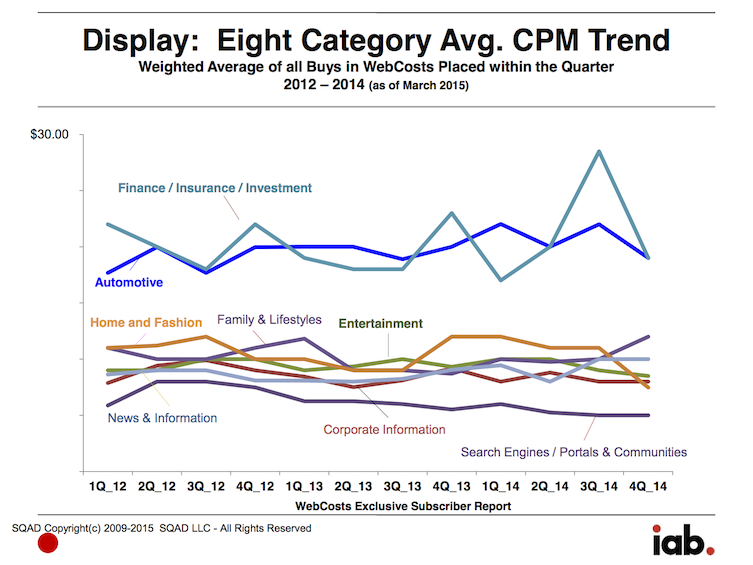
by on Apr 16, 2015
Direct mail is a term used by marketing agencies to refer to any sort of marketing collateral that is mailed to someone’s home or business. This can (and does) include things such as postcards, newsletters, self-sealed brochures, product catalogs and general advertisements.
As with any piece of marketing, there are pros and cons to think about when considering running a direct mail campaign. The first step is to evaluate who your target audience is, and if you think they would be listening and respond well when communicated in this manner. For example, the 18 - 25 demographic has been raised in a digital world and are not accustomed to being introduced to products or services through mail advertisements. They are, therefore, much less likely to spend time reading or considering your message when reached out to this way.
However, the older, retired demographic (55+) are perfect candidates for direct mail, because they often enjoy spending time each day reviewing the mail they received, and are much more likely to give your piece of marketing their time and consideration.
The second step is to consider what other pieces of direct mail your demographic is likely to receive. You need to make sure that your piece is unique, attractive, and isn’t putting across the same message as something else that was delivered that day. For example, if you are sending a postcard to homeowners offering your landscaping services, chances are that homeowner has received the same or similar every day since spring began. Your piece, therefore, needs to offer something different than everyone else - perhaps that’s a discount, a free consultation, or a package deal.
Third is to have your piece professionally designed. It’s incredibly important that you make the most out of every one of your marketing campaigns - and direct mail is no different. If you commit to the cost of producing and mailing your piece, you need to put your best foot forward and send a design that is attractive, effective, and clearly puts across your marketing message. Don’t undercut your own returns by cutting corners on this step.
Lastly, you have to take into account what the cost of mailing your piece is going to be. The United States Postal Service has strict guidelines about the size and thickness of mailable items, and (typically) the bigger or thicket the mail, the more expensive the cost. At Grid, we suggest you have a professional mailing house handle the actual postage and mailing of your piece. They can handle the stuffing, labelling and mailing of your piece, all at a lower cost than you could on your own (often by using their license to mail “bulk mail” at a lower cost than regular rates).
If you’re thinking about sending a direct mail campaign, reach out to Grid! We can help you get the right messaging, design, mailing list (targeted specifically to your demographic), and facilitate sending the final product.
by on Mar 20, 2015
Social media marketing is here to stay, and if your business hasn’t hopped on that bandwagon it’s definitely time you start thinking about it. Gary Galvin of Salesforce published an article today that covers some of the best practices for selling your products or services using social media. Even if you are a social media maven or mogul in your private life, approaching social media from a business standpoint is a whole different ballgame. Read up on these best practices, reprinted below with relevant quotes from the article, to give you a leg up!
If your business is interested in testing the social media waters or has already started social media marketing but aren’t seeing the results you hoped for, get in touch with us. We have extensive experience managing a wide variety of social media accounts in a range of capacities - from assessing your current efforts and making suggestions to improve, to fully managing your accounts across different platforms (such as LinkedIn, Twitter, Facebook, Pinterest and Instagram), we can help make your social media more effective.
Photo courtesy of flickr user Jason Howie.
by on Feb 10, 2015
We’re all heard them - radio ads that offer “free business cards” from large, national print companies. But just like everything else that’s advertised as “free”, there are some hidden costs you should be aware of.
The Upsell
Many business use the term “free” as a way to get you in the door, making you a captive audience to the other products and services they offer that aren’t free. You’ve seen this tactic a lot, and sometimes in slightly different forms, but the ultimate goal is to get you to spend more money than you initially wanted to spend, including heavily marking up the cost of shipping to make up the loss.
The Quality
Have you ever had someone hand you a business card where the paper is so thin you can see through to the other side? Or the ink coverage is inconsistent so solid areas instead look splotchy (or worse, it looks like it was photocopied a hundred times)? How about a card that was clearly cut incorrectly, so all of the information is slanted at an angle? A business card is often the very first chance you get to impress someone with the visual aesthetic of your brand. It’s a chance for you to make a statement about the quality and professionalism of your work. If the printing, paper stock, or cut alignment is sub-par, you’re sending the wrong impression.
The Advertisement
The company’s that offer free business cards take a calculated risk that they can upsell you into selecting a paid product. If they can’t, however, they have found a way to still get value out of your transaction. Business cards are by nature meant to be shared - handed out to other individuals on a regular basis. Every card printed by these company’s comes with their own logo printed on the back - piggybacking their advertisements on your cards, and, therefore, your business. It’s crucial to keep a potential customer focused on the value you can provide them. Confusing your pitch with an advertisement from another brand will make it harder for your message to come across.
Devaluing Your Brand
This is the highest cost to the free business card deal. You value your business - if you didn’t, you wouldn’t be working so hard at it every day. So why would you undermine yourself by devaluing your own brand in literally the same gesture as introduce yourself someone. When you hand someone your business card, you are saying “I am proud to be a part of this brand and I want to share it with you.” As soon as that person reads “Printed for free at companyname.com” on the card, they are going to think that you don’t consider your business valuable or worthy enough of quality business cards. It would be similar to walking into a job interview wearing sweat pants. You may be the most brilliant mind in the room, but if you don’t show that you value this opportunity by dressing appropriately, you’re not going to be taken seriously.
Free business cards may seem like a great deal in the short term, but you always have to consider the long term impact of the choices you make, especially as it relates to your marketing. At Grid, we value the impression that your brand makes from the first introduction, like a business card, to the last interaction, such as a follow up service call to make sure the client is satisfied. Let us help you build a marketing strategy that addresses all stages of the interaction.
by on Jan 9, 2015
To the most drivers, it might look like a standard billboard advertisement, displaying ads for things such as the Porsche 911. But as soon as a Porsche approaches, the messaging changes to something a bit more “ego stroking” (to quote the article). Cameras, placed several hundred yards before the billboard use “car recognition technology” to scan the approaching cars and, based on the type of car it identifies, adjusts what messaging should be shown.
We’re not too blown away by the technology itself - it reminds us a bit of online display ad targeting, which is where the ads you see are based on your previous browsing history. Have you visited Carnival Cruise’s website recently? You’re much more likely to see ads and specials for cruises as you continue browse even unrelated websites. It also hearkens back to FourSquare’s “future technology” pitches of pushing specials or coupons to someone’s phone when it detects them walking into a specific retail location. What’s interesting here, to us, is how Porsche is using this technology to build brand loyalty with it’s current customers.
It can be easy to get wrapped up in focusing your marketing strategy on acquiring new customers - it’s the most common way to think you will make sales. But Porsche has always been sure to spend an equal, if not a greater, amount of their marketing budget aimed towards current customers. In most cases, it can be easier and more cost effective to promote additional sales from current customers, than to try to acquire new ones. Porsche has always built it’s brand on the idea of exclusivity, drawing their advertisement viewers to imagine a world where the viewer belonged to a very exclusive club of speed and luxury. But the pitch has never ended at the sale. Once you’re an owner, Porsche wants to remind you of the club you’re now in. They throw new owner parties and send out hand address invitations. They send hand signed Christmas cards and thank you notes. They keep track of your maintenance and lease schedules, and follow up with sales and promotions when it comes time that you may be thinking about purchasing a new car.
In the case of these billboards, Porsche gets the best of both worlds. It’s showing current owners how valued they are (by adjusting the display to be directed specifically at them), but it also has a trickle down affect by showing all of those around the Porsche owner that they could be in this “special club” too. It’s building brand loyalty and “driving” (no pun intended) brand awareness through our natural desire to be feel included.
How are you making your customers feel appreciated?
by on Dec 12, 2014
Michael Williams of Synchologic spoke with Whitney Archibald of Exhibitor Online Magazine, and gave her an amazing rundown of how his company almost never pays full price to exhibit at trade shows. The article, “Secrets of a Trade Show Tightwad” is a little old (published in September 2003), but the advice he gives is still incredibly relevant. In the article he discusses a variety of tips, including:
The only item we don’t agree with is using a freelancer or student student to handle the graphic design elements of your exhibit and collateral. Your trade show display should be considered as only one piece of your overall marketing strategy. It’s important that your exhibit works in collaboration with your other marketing efforts, such as your website, direct mail campaigns or social media campaigns. At Grid, we take your entire business and marketing goals into consideration when approaching your trade show display, and we make sure that the branding, messaging and design all work together to drive your potential customers towards action. You won’t be able to find this level of 10,000 foot view approach when working with a one off designer who doesn’t know the ins and outs of your brand, or a college student who doesn’t have experience working with trade show displays before.
by on Sep 18, 2014
Google Analytics is a free service which enables website owners to track invaluable data about its users in order to provide a better platform on which to market their products. This service is available to the entire the internet community, and it was launched in late 2005. After it was rolled out to the public, Google encouraged the community to try out its new web analytics software. Around the world, web developers and nerds alike dropped what they were doing and immediately signed up to test this service. In fact, due to the overwhelmingly pervasive response, Google was receiving so much traffic that they were forced to suspend the new sign-ups about a week after it had been launched! Google continued to run this service on an “invitation-only” type basis until mid-August of 2006, which is when the service became fully available to the public.
In the alpha stages of analytics, large websites noticed a heavy performance loss at the cost of running this service; however, today’s asynchronous version of the analytics tracking code permits the service to load in tandem with the rest of the web page, allowing for uninterrupted page-loading. Additionally, Google makes registering extremely easy, and they also contribute in-depth tutorials detailing the steps necessary in implementing analytics onto your own website. How does it work? Well, Google provides you a small snippet of code that contains your unique Google Analytics ID, and this code is to be placed within the Header tags on every page of your website. When a user navigates to your page, the code snippet collects information about that user, and sends the raw data back to your Google Analytics account, which, in turn, organizes and processes that data, and then converts it into readable, graph-able, beautiful data.
To provide an example of how the service works, imagine you are running a small bakery. You want to launch a website to market your brand, and to provide customers with important information about your company. As a business owner, you should have some idea of who your target demographics are, but Google Analytics can provide extremely detailed information, not only about the total number of people visiting the site and where they are located, but also what kind of actions they are taking, which pages are the most popular, and even how long they remain on a given page. The analytics service can also track which browser software the user is using, and also the type of device on which they are browsing—whether it be desktop, tablet, or mobile.
While some of this information may not seem very useful to a business owner, it is incredibly valuable to the developers and advertisers. Knowing where to display your ads is one of the most profitable steps a business can take in increasing revenue. Google even created a page for its analytics software that shares success stories about different companies that have utilized this service, and have seen significant growth as a result. Some companies, such as BuildDirect, have increased their sales by an amazing 50%.While I can only scratch the surface of Google Analytics’s massive capabilities, there are dozens of pertinent features that have not been mentioned. One of the most important facets is the ability to understand where users are entering your site. If they are being directed to your page from a Google search, analytics will outline the most popular search results which led the user to your page. If the user is coming to your site because they clicked on an Adwords campaign, it will tell you specifically which campaign led them there. This is extremely useful because it gives you a visual representation about which aspects of your company seem to be driving the most amount of traffic. After this information has been analyzed, your advertising department can cater to the data provided from Google Analytics, thus creating ads that will be of greater interest to your customers.
“Conversions”, or pre-defined events that are tracked by the analytics account-holder, provide information about certain events happening on your site. For e-commerce sites, it’s common to define conversions as making an online transaction. When a user lands on a certain page, usually the confirmation page, or “Thank you for your Purchase” page, the tracking code will send all of the information about that purchase back to your analytics account. This allows e-commerce site owners to see which products are the most popular and what the average sale order is, among many other useful bits of information. Alternatively, you can set a conversion trigger on an event such as downloading a PDF file, or clicking a link that provides further information. This notifies your company know that the user finds this content useful, and will probably spend more time on your site, therefore this can be tracked as a conversion.
Sometimes, users who navigate to your site will exit immediately after discovering that it is not what they had intended. This is referred to as the site’s bounce rate. A high bounce rate can indicate that your site is being advertised incorrectly, or it is being advertised to the wrong users. It can also be indicative of a broken webpage - Google Analytics will breakdown the bounce rate for each page on your site, which can shed light a technical issue that may have otherwise been overlooked.
No matter how small your business is, your product inventory (or lack thereof), who your demographics are, or the size of your budget, Google Analytics provides business owners with indisputable facts about how their customers respond to its outreach. Prior to analytics, this data would either have been virtually unattainable, or it would have cost an arm an a leg paying a team of experienced developers, analysts, and market researchers. So even if you’re a broke, young, inexperienced start-up, Google Analytics is a reliable and effective source of market research. If you aren’t using analytics already, what are you waiting for?
by on Sep 17, 2014
Google AdWords is a system that allows businesses to pay Google to show their advertisements to people who use Google to search for certain keywords. What advertisement Google decides to show can be complicated to explain, but I found this great infographic that gives an overview of how these advertisements are chosen. In short, the ranking of advertisements is a result of a combination of each ad’s “CPC bid” (how much that business is willing to pay per click) and their “quality score” (how relevant Google believes that websites content is for the search terms keyed in).
It’s important to always remember that a Google AdWords campaign is not “set it and forget it”. You should be making regular changes to your campaign based on the results you are seeing, until you find that sweet spot that maximizes your return and minimizes your costs (and that sweet spot may change several times per year!). At Grid, we have extensive experiencing brainstorming, implementing, and managing Search Engine Marketing campaigns for a wide variety of clients. Let us manage your campaign so you can continue to focus on your own business!
by on Sep 17, 2014
Every web developer understands the feeling of testing a website in IE for the first time. It’s a much-discussed topic of frustration for both designers and developers. Many major corporations such as Google are rapidly ending support for older versions of Internet Explorer.
While you may still hear of developers optimizing websites for Internet Explorer versions 8 and earlier, many professionals are following suit and simply abandoning support altogether. According to to this article from the Google Apps blog, support for IE9 has already been dropped as of November 5th, 2013.
Many developers have been literally counting down the days until Internet Explorer itself officially drops support for its older browsers, but why is it such an important issue among the community? This is a kind of multi-faceted problem for both the developers and the client. There is a superfluous amount of time and effort spent fixing display issues in older versions of IE, and while it is hard to argue that the outcome is not ultimately beneficial for the user, there is a large decrease in the number of users who run older versions of IE on their machines. In fact, less than 1% of the world population is using IE7, and about 10% of the world is using IE8.
This is more a question about whether or not the time spent on optimization is worth it for the client. There is now such a small amount of users running older versions of IE, that the cost of optimizing for IE could almost always be better spent on other aspects of marketing such as the advertising budget, or responsive design for mobile devices.
From a developer’s standpoint, the “optimization” process is comprised mostly of finding ways around the bugs inherently present in IE8 and older. It can be a very difficult process of logically figuring out entirely new methods of creating a certain function or aesthetic flourish that appears so nicely in modern browsers. The lack of support for modern web elements leaves developers dusting off old manuals, and figuring out how to solve the same problem in a seemingly “incorrect” way.
The brilliant men and women behind modern web browsers like Mozilla, Google, Opera, or IE10+ are working everyday to create new and more efficient ways of solving old problems. Additionally, recent updates to the languages used in web development (HTML5, CSS3) are boasting some exciting new features, such as better browser support for videos without having to embed flash onto a webpage.
It’s up to the browser developers to make sure these new features work properly in the newest versions of their software. Modern browser developers are playing an endless game of catch-up with the authors who write the language that it runs on. Many of the features that are implemented into newer versions of browsers have technically already been written into the language, it’s just a matter of the browser supporting those features. If you are running a browser that came out within the past 4 years, then you don’t have to worry—most major browsers provide automatic updates for their software.
This is a big step forward for the development community. With the advancements in how programming languages are written and interpreted, it is opening up a whole new realm of possibilities which was never possible in outdated browsers. Because of this, developing a website has become a much more elegant experience, and many businesses are capitalizing on the new features available to us as developers. It provides us with a better platform to market a business, and, perhaps more importantly, releases the designer from the shackles of ancient web display standards and allows him/her to be truly unimpeded when designing the interface of a website.
by on Jun 9, 2014
Entreprenuer recently put up a great article called “The 10 Commandments of Great Copywriting”. Although the author positioned this list towards copywriting for email marketing, we think it’s applicable for your any marketing copy. The list is reprinted below, with our own notes added in.
by on Oct 10, 2011
We’ve heard the question from clients many times over the years - do billboard advertisements really work? When I challenge them to notice their own behaviors while driving, I often hear back that “Sure, I saw several billboards, but I’m too aware for the marketing to impact me.” But, I respond, do they really know what messages and brands their subconcious is taking in and storing for later recall? If they have a late night need for a plumber, is there a good chance they will remember the plumber who’s billboard they see every day on the way home?
Today, I came across a great Forbes article titled “Does Outdoors Advertising Still Work?” The author reviewed the data from the Arbitron National In-Car Study, 2009 edition, and found some incredibly useful takeaways as to how influential billboard advertisements can be.
Billboard viewers make shopping decisions while in the car.
There is an additional big takeaway that the author just barely touches on at the end of the article. At Grid, we firmly believe that your marketing should never consist of a single marketing piece. As the author of the article says, you “[c]an’t just have a billboard to have a billboard.” If you are considering investing your time and budget into a billboard campaign, here are a few of the questions you should be considering:
Do billboard advertisements really work? Absolutely. But for them to be the most effective, you need to consider them as one piece of your overall marketing strategy, not your entire marketing strategy in and of itself.
by on Jun 24, 2010
Marketing in a Down Economy
The strength of our economy is questionable at best these days. The unemployment rate is hovering around 10 percent, the Dow seems to go everywhere but up, and let’s not even discuss the international markets right now.
Indeed, it’s a scary time for many business owners as they encounter the uncomfortable question, “what do we do next?”
The Turtle Method
One school of thought touts a conservative “circle the wagons” approach for businesses during rough economic times. Gather close everyone and everything you hold dear and hang on tight to weather the storm. This strategy includes reducing or altogether cutting those business programs that some shortsighted executives often see as less-crucial to maintaining the overall bottom line. These typically include advertising, public relations and other marketing functions that don’t necessarily show an immediate or obvious return on investment (ROI).
Unmoving water can easily become stagnant and so do businesses that don’t continue to market, innovate and, consequently, remain top-of-mind with their consumers.
This may seem like a logical move for many small businesses during a lag in the economy’s growth. Granted, a business will save money by omitting these essential business functions, but what will the ultimate cost be in lost revenue without them? Will the business be able to grow? Doubtful at best. Unmoving water can easily become stagnant and so do businesses that don’t continue to market, innovate and, consequently, remain top-of-mind with their consumers.
The annals of the marketing world are fraught with businesses that employed this survival method - eking their way through tough times only to find that their competitors continued their marketing programs and are now occupying the market share they once did.
The Cornflake Method
Consider the cautionary tale of cereal producers Post and Kellogg’s during the late 1920’s. Heading into the Great Depression, Post held a significantly larger cereal market share than arch-rival Kellogg’s. On October 29, 1929, the stock market collapsed, along with Post’s confidence in consumer demand. Post slashed its marketing budget and rode out the Depression resting on its laurels - hoping everything would be just as it was once the economy recovered.
Kellogg’s recognized the opportunity Post was presenting and steamed full speed ahead, doubling their advertising budget and launching an aggressive advertising and marketing campaign. The wisdom of this decision was questioned by more than one industry analyst at the time; however, Kellogg’s shrewdness in business needed no critique. Kellogg’s ramped up advertising and marketing efforts effectively filled the void left by Post’ retreat. As a result, Kellogg’s became the more recognized name, instilling a stronger sense of confidence in its customers.
By the end of the Great Depression, Kellogg’s emerged as the dominant player in the cereal wars posting profits of 30 percent. Their aggressive marketing and advertising campaign paid off, cementing their status as the world’s number one post-depression era cereal manufacturer, a distinction they still enjoy to this day.
Kellogg’s now manufactures their products around the globe and sells them in more than 180 different countries. They currently hold half of the international market and sell 40 percent of all cereal purchased in the United States.
Kellogg’s understood that consumers continue consuming even during depressions. When it might seem like the world is falling apart, people still need food, haircuts, plumbing, electricity, appliances, etc. The difference is they begin to look for better deals and more value-added products.
Furthermore, Kellogg’s wasn’t the only company during the Great Depression that recognized the marketing opportunities in a down market. At least six other companies maintained or increased their investments in advertising and other marketing functions through the market collapse.
You may have heard of them.
Their names were Campbell’s, Coca-Cola, Ivory, Kodak, Wrigley and Lipton. All of them emerged strongly from the Depression and are today, the leaders in each of their respective categories.
A McGraw-Hill Research study supports these real-world results. It showed that four years after a downturn, companies that maintained or increased their marketing communications during an economic slowdown, on average, experienced 14 times more growth than companies that employed the “turtle method” and cut back.
Yours to Choose
Will you follow the Kellogg’s example and seize the opportunities presented by a gloomy economy? Or “turtle up” like Post and spend the better part of the next century trailing the wiser competition? If your company decides to choose the former, Grid is ready to help!